Congratulations to Our 2024 Hall of Fame Members!
Paul Michaelian, a resident of Virginia Beach who passed away in 2023, was a past president of the MAPGA, and Rick Schuller, a resident of Chester, VA and a 5-time MAPGA Player of the Year, became the 59th and 60th Members of the MAPGA Hall of Fame.
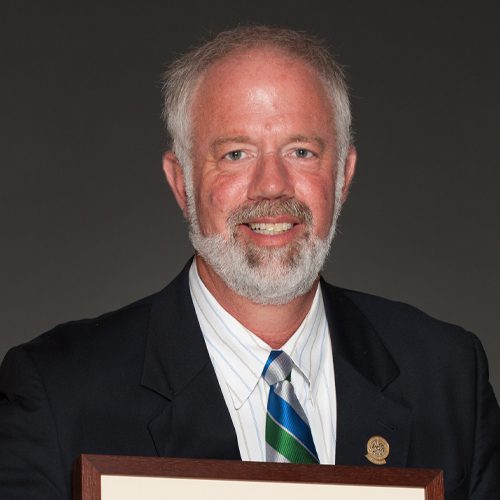 Paul Michaelian, PGA
Paul Michaelian, PGA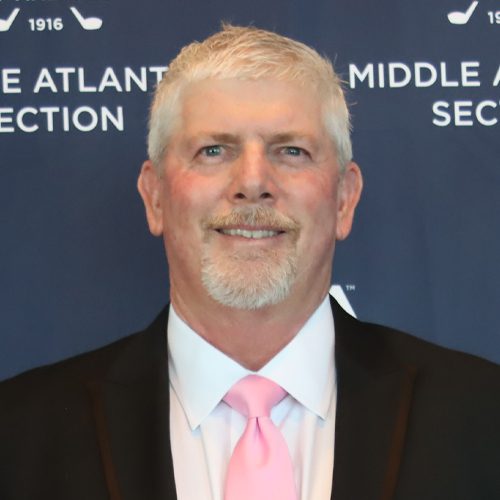 Rick Schuller, PGA
Rick Schuller, PGA
Middle Atlantic PGA Hall of Fame Members
- AHRNSBRAK, MIKE (2019)
- BARNETT, ROBERT (2010)
- BARRY, TOM (2014)
- BASS, JOHNNY (1992)
- BASSLER, CHARLIE (1987)
- BEACH, RALPH (1993)
- BECK, TROY (2021)
- BETSCHLER, CHARLES (1997)
- BROWN, GLENN (2023)
- BURGESS, WARD (1989)
- CLARKE, BILL (1987)
- COX, WIFFY (1990)
- CRONIN, FRANK HARFORD (2007)
- CRUICKSHANK, BOBBY (1996)
- DECK, BILL (1998)
- DEFRANCESCO, WAYNE (2019)
- DOLAN, BOB (2023)
- DOSER, CLARENCE (1988)
- DIFFENBAUGH, GEORGE (2013)
- ELBIN, MAX (1987)
- EMERY, CLARE (2003)
- FITZHUGH, WOODY (2012)
- FLATTERY, JOHN (2011)
- FOLKS, JIM (2010)
- FUNK, FRED (2018)
- GIBSON, ANDY (1992)
- GILES, VINNY (1990)
- HAINES, JOHN (2004)
- HARDY, BILL (1988)
- HARPER, CHANDLER (1986)
- HAVILAND, PAUL (2007)
- HERRELKO JR., FRANK (2009)
- HOLLEY, WAYNE (2012)
- HOUGHTON, AL (1989)
- HURST, DEAN (2021)
- ISAACS, JACK (1996)
- KING SR., CLAUDE (2001)
- KING, FRED (1998)
- LABER, FRANK (2022)
- MACMASTER, CARROLL (2012)
- MAJEWSKI, HANK (2008)
- MARLOWE, TONY (2002)
- MCLEOD, FRED (1991)
- MICHAELIAN, PAUL (2024)
- O’DONNELL, JOHN (1993)
- RASNIC, CARL (1992)
- RINGER, LARRY (2011)
- ROMANS, WALTER (1988)
- ROSE, HERB (1993)
- SCHULLER, RICK (2024)
- SKIPPER, TOM (2017)
- SNEAD, SAM (1986)
- SNYDER, JOHN (1999)
- SPENCER, GLENN W. (2017)
- SPORRE, WILLIAM (2006)
- STEINBRECHER, LEO (1990)
- STRANGE, CURTIS (2017)
- STRANGE, TOM (1997)
- STRAUSBAUGH, BILL (1989)
- WHETZLE, DICK (2000)
- WORSHAM, LEW (1986)
- WRONOWSKI, ALLEN (2015)
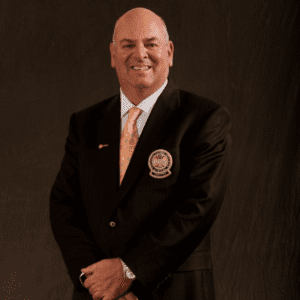
Michael Ahrnsbrak’s esteemed forty-year golf career earned him the Hall of Fame recognition by the Middle Atlantic PGA. His contributions to education, leadership and administration in the Section began as a young Assistant Professional first at Leesburg Golf and Country Club, then Woodmont Country Club, and culminated in election by his peers as one of the PGA of America’s fourteen District Directors. Throughout Mike’s tenure in the Section he served, as a Head Professional at Shenandoah Valley (1985-1999), followed by a number of years in management and organizational consulting, then returning to the Head Professional and General Manager ranks at Musket Ridge (2003-2006), Blue Ridge Shadows (2003-2016) and Lexington Country Club (2017-2018). Mike is currently the GM/COO at Pine Valley Country Club in Wilmington, North Carolina.
Originally from Seattle, the son of a US Navy Chaplain, Mike started swinging golf clubs quite early, maybe only a year old. His father’s naval career meant many moves for the family, so his first golf memory is caddying, actually pulling the cart, for his father in Rhode Island, before moves to San Diego, then Florida, and attending high school at four different locations, including Florida, New Jersey, Missouri and Virginia. Though baseball was a first love, eventually golf became the prime interest. During a short stay in Missouri, he played against Payne Stewart in junior and high school competitions, and in 1971 won the Missouri State Junior title. Then in Virginia at Herndon HS, he lost the District High School Championship by one shot to fellow inductee Wayne DeFrancesco. After attending Rollins College, Mike turned professional and secured an assistant’s position to Billy Pearl at Leesburg Golf and Country Club. Soon thereafter, he won a Pro-Am at Goose Creek. Before becoming a Head Professional he was schooled by Hall of Fame member Tony Marlowe as an Assistant Professional at Woodmont.
The “service” relationship in the MAPGA began with an Assistant Directorship in the Junior Golf Academy in 1979, followed by becoming Director in 1981. The membership elected him MAPGA A-8 Director in 1982. As a significant member of the Section, he first earned Assistant Professional of the Year honors in 1983. Within the Central Chapter, Mike moved up through the leadership ranks from Tournament Chair, Vice President and then President. His contributions to education earned him the Horton Smith Award in 1990. He followed that with a Merchandiser of the Year (Resort) Award in 1991. Under MAPGA President and Hall of Fame member, Allen Wronowski, he was appointed the Chair of the Employment Committee. Mike was named MAPGA Professional of the Year in 1992, the Section’s highest active honor. Once he won election to the MAPGA Section Secretary position in 1992, Vice President (1994-95) and President (1996-1997) ensued. After moving through the ranks to the MAPGA Section Presidency, Mike Ahrnsbrak earned the highest distinction from his colleagues when they elected him to serve on the PGA National Board of Directors as the District 10 Director in 2010, a three-year term.
In 1997, the Dewar’s Virginia Hall of Fame for Virginia Golf Professionals named him as one of their own. Additionally, his credits include a Golf Digest “Beat Teacher in Virginia” recognition in 2000; and an “America’s Top 100 Golf Shops” by Golf Shop Operators Magazine in 1991. Also, he hosted at the National level a “Seminar and Social for Non-PGA and Developing Golf Facilities.”
As a leader in the Section, Mike foremost accomplishments include a major role in bringing on Colonel Dick Johns as Executive Director, and Jon Guhl as Assistant Executive Director in 1995. He followed up as a team member that created the MAPGA “Superfund” that eventually paid for the purchase of land and the construction of an office complex unmatched throughout the PGA Section communities, replete with conference rooms, museum and library.
As a player, he earned his way into qualifying for five PGA Club Professional Championships, now deemed the Professional National Championship. Mike has won at least one section event in each decade of his career. Additionally, he played in the 1985 PGA Tour stop in Washington, the Kemper Open, and then the 1992 Anheuser Busch Classic and the 1994 Nike Tour Dominion Open.
Influences on his career and good work beyond his parents who introduced him to the game and championed his passion, are major figures in MAPGA circles, many of whom are Hall of Fame members, notably Bill Pearl, Carl Rasnic, Tony Marlowe, David Wortman, Bill Strausbaugh, Hank Majewski and Jim Folks.
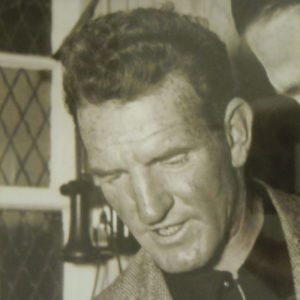
1896 – 1949. Robert Barnett, a native Philadelphian, rose to prominence in PGA circles as a founding member and President of two sections, the Philadelphia and the Middle Atlantic. He served the national PGA as a Vice President between 1944 and 1946 as well. The Philadelphia Section elected Bob their first President in 1922. He moved to the Chevy Chase Club in 1923. The Middle Atlantic PGA (MAPGA) membership elected him President twice, the first time for two consecutive terms, 1926 and 1927, succeeding the legendary Fred McLeod, and the second time in 1933.
Bob Barnett began his professional career as an assistant at the Bala Golf Club in suburban Philadelphia in 1914. Three years later he took the assistant position at the Pocono Manor Inn. US Army duty with the Fifty-Fourth Infantry landed him in France for a year as an infantry instructor during World War I. After the War Bob returned to Pocono Manor as the Head Professional for a year before accepting the head position at Tredyffrin CC in Berwyn, Pa, where he stayed until 1923. In a 1933 interview Bob reminisced how after the war he spent seven and eight hour practice sessions hitting hundreds of balls day after day to enhance his game.
As a player he won the Philadelphia Section championship twice, 1923 and 1925. The Philadelphia membership held Bob in such high esteem that even though he took the Chevy Chase position, they invited him to play in their Section championship. Bob won the 1929 MAPGA Section title besting J. Munro Hunter in the final match, but lost the Sectional title in 1931 to R. Cliff McKimmie.
Nationally, he played in seven US Opens, finishing 35th at Columbia in 1921 followed by a tie for 54th in 1925. In PGA Championships Bob lost a first round match in 1921, then in 1923 won a first round match before losing. He qualified for the PGA Championship again in 1924, 1945 and 1946. Locally, he finished second in the 1948 Maryland Open. In 1929, he shot a five under 64 on the Chevy Chase layout.
In a history of the The PGA, Herb Graffis cited Bob’s statement to the 1932 National Convention that “There are real-estate men in New York and Chicago who would give the PGA land, a golf course, and a club-house for a club on its own and make a large profit out of what a PGA club would do to increasing the value of surrounding property.” Certainly, Bob was thinking far ahead of those in his generation. Furthermore, he served on the 1941 PGA Teaching Program Committee headed up by a future PGA President, Joe Novak.
For about twenty years, Bob held the “winter” Head Professional position at one of South Florida’s premier clubs, Indian Creek in Miami. During that time two of his “winter” assistants included two future PGA and MAPGA Hall of Fame members: Max Elbin and Bill Strausbaugh Jr.
After World War II when The PGA launched the “Wounded Veteran’s Rehabilitation Program,” Bob not only spearheaded the MAPGA efforts, but served on the National PGA Committee chaired by Frank Sprogell, the PGA Secretary. Robert Barnett’s contributions to the Middle Atlantic PGA, the Philadelphia PGA and the National PGA continued long after his premature demise in 1949 at age 53.
On a personal side, Bob could whistle with the best of them. He played golf whistling and when he needed to call a meeting to order or get everyone’s attention, he called on his famous whistling. (rev. 2011)
The District of Columbia Professional Golfers’ Association, a forerunner of the MAPGA, elected Fred McLeod their first President, and Bob Barnett and Leo Diegel to the first and second Vice Presidents positions in their inaugural meeting in April 1924. The next year, Bob and McLeod were instrumental figures in the formation of the MAPGA Section in March, 1925, along with Charles Betschler, President of the Maryland State Professional Golfers’ Association. The Maryland and District of Columbia organizations ceased operations in 1927 and 1928, respectively.
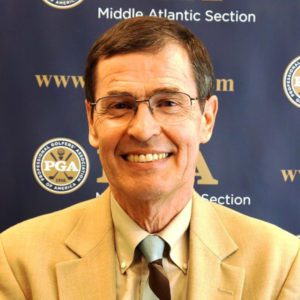
Jefferson Lakeside Country Club, Richmond, Virginia
Tom Barry’s unparalleled service and contributions to the Middle Atlantic PGA and the PGA of America span over thirty years. For that he is honored with MAPGA Hall of Fame recognition. Since assuming the Head PGA Professional position at the Jefferson-Lakeside Club in 1983, the MAPGA recognized his excellence and dedication with numerous awards, most notably the Horton Smith Award three times: 1989, 2000, and 2008 for excellence in PGA member education; the President’s Award in 1990; the Bill Strausbaugh Award in 1992 for service to fellow members in employment and club relations; and the MAPGA Professional of the Year Award in 1994. In 2012, the Virginia State Golf Association acknowledged him with the “Service to the Game” award.
Additionally, within the Section’s Virginia and then Southern Chapter, Tom Barry held the Director-at-Large position for of the Virginia Chapter in 1987 and 1988, served as Secretary of the Southern Chapter for three years between 1990 and 1992, and the Presidency of the Southern Chapter for three years between 1993 and 1995, and as the Honorary President of that Chapter in 1996. As a Committee member, he has held seats on both the Membership Committee and Club Relations & Employment Committee for some fifteen years.
Furthermore, over the years Tom has become well known for his Rules of Golf expertise. After attending many PGA\USGA rules workshops, and continuing to support the Section as an on-the-course rules official, he became the “go to guy” as many colleagues and even MAPGA staff members call him to confirm or ask for clarity on a ruling. As well, and of considerable importance, since 1990 he is one of the core teachers in MAPGA\VSGA in Rules of Golf program in Virginia that MAPGA Honorary member Clyde Luther originally developed.
Originally from Waterbury, Connecticut, Tom was the fifth of eight children reared by Joe and Maryalice Barry, born on October 24, 1952. As a youngster the family relocated to Chicago Heights, Illinois. His golf career began at a local nine-hole venue, Cherry Hills Golf Course, playing alongside his father’s watchful eye just after he had turned nine-years old. At age 13, he joined the caddie ranks, his first golf-related job. From there on out, he worked every summer at the golf course, then becoming the shop assistant before turning professional in 1973.
Tom elected to PGA membership in September 1979. Flossmoor Country Club employed him as an Assistant Golf Professional for seven years, from 1973 until 1980. From there Tom’s career moved to the Head PGA Professional ranks at Oregon Golf Club in Oregon, Illinois in 1981 and 1982. Since 1983 Tom Barry has faithfully served the Jefferson Lakeside Club as their Head PGA Professional.
While Tom was still a young man, David Ogilvie III, Head PGA Professional at Flossmoor Country Club in Flossmoor, Illinois, won over his esteem to such as extent that it subsequently influenced his decision to make the golf business a career. Tom says that more than anything else that Ogilvie stressed the importance of professionalism and demonstrating a gentleman’s persona at all times. David Ogilvie himself ultimately received the PGA of America “Professional of the Year” award in 1986. Interestingly enough, David Ogilvie’s father held the Head PGA Professional position at Jefferson Lakeside for some fourteen years, 1964 – 1978.
Tom and his wife Michelle Hoffmann were married in 1990. He says that there is no way he would have achieved any success in the golf business without her support and encouragement.

1911–1981. Johnny Bass entered the MAPGA Hall of Fame for his notoriety on the golf course and his many years of providing Maryland charities his organizational assistance. He always did his utmost to lend support to boys’ clubs, sports teams, and the fund raising efforts of hospitals and churches. For the golfing community, Johnny is given great credit for bringing the LPGA tour stop to Baltimore.
A native of Baltimore, Johnny started out as an “office boy” in his first job, but left that in 1932 to become the assistant golf professional at Clifton Park Golf Club. From there, John soon moved on to Woodholme Country Club, where his apprenticeship continued under Warner Mather, one of the leaders of the fledging Middle Atlantic Section. After three years he accepted a similar position at Hampton Roads Country Club, but stayed for only six months. In 1936, John returned to Clifton Park as the head PGA Professional where he remained through 1957. After World War II began, he enlisted in the Maritime Service and served as an onboard ship purser. Following more than a decade of service at Clifton Park after the War, he became the first head PGA Professional at the newly constructed Pine Ridge Golf, continuing there until his 1972 retirement.
John’s playing career began in a noteworthy fashion when he led the assistant professionals in the Maryland Open at Baltimore CC Five Farms in 1933. He won the 1934 MAPGA Assistant Professional Championship at Baltimore CC Five Farms and then the 1935 MAPGA Section Championship at the “original” Indian Spring course. On his way to the 1935 MAPGA Championship title he defeated Mel Shorey, Charles Betschler, Alec Taylor, and then George Diffenbaugh in the finals for the $100 first place check. All of them were well-regarded players of the 1920s and 30s. In 1938, he played in the first Baltimore City Open at Baltimore CC Five Farms, but lost in the opening round to Charles Betschler.
Nationally, Johnny played in four US Opens and two PGA Championships. In 1935, he qualified for the PGA Championship at Rolling Road. However, he did not make the field for the match play portion in the thirty-six hole qualifier at Twin Hills CC in Oklahoma City. John captured medalist honors in the 1936 US Open qualifier at Hillendale. However, he missed the cut in the event held at Baltusrol. Two years later in 1938, he again qualified for the US Open, that time besting George Diffenbaugh in a playoff for the last spot. However, he did not play in the Tournament proper held that year at Cherry Hills in Colorado. After World War II, John qualified for the 1948 US Open at North Hills in Philadelphia, but missed the cut; qualified again in 1952, but missed the cut at Northwood in Dallas; and qualified for the last time in 1954 at Mt. Pleasant and finished in 50th place at Baltusrol. In 1948, he led the field briefly at Riviera Country Club. His last national appearance took place at the Hermitage CC in Richmond when he did not make the match play portion of the 1949 PGA Championship.
In 1963, John thumped his younger colleagues in the Belair CC pro-am, now Bowie Golf Club, by shooting 68 and gaining a tie with Billy Phillips from Winchester CC and leading the field by two strokes.
Johnny was one of the last tournament players to wear a tie and long-sleeved shirt in competition. His peers named him the MAPGA Merchandiser of the Year (Public Category) in 1980. (rev. 2004)
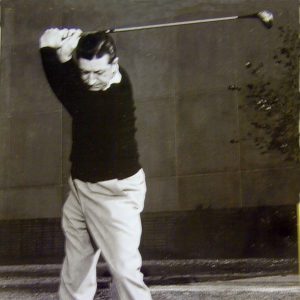
Charles Bassler, born and raised in Catonsville, Maryland, started in golf at 14 as a Rolling Road Golf Club caddie. In 1941, he won the club championship. During World War II, he served with the First Marines in Okinawa and Peleu. Soon after returning stateside in 1946, he turned professional as an assistant to Robert Barnett at Chevy Chase Club. Charlie was elected to membership in The PGA in 1948. He was the head PGA Professional at Rolling Road GC (1948 through 1958), Turf Valley CC (1959 and 1960), and Indian Spring CC where he remained until his retirement in 1981.
Known as a big hitter and swing stylist, “Golf Digest” featured Charlie in their initial issue in an instructional piece about driving the ball.
Charlie won the Maryland Open seven times: 1948, 1950, 1953, 1955, 1957, 1958 and 1965. He conquered the field twice in the District of Columbia Open, 1949 and 1952, both times at Indian Spring CC. Charlie defeated Roger Peacock in a playoff to win the 27-hole 1951 Annapolis Roads Open by firing 37-36-33. The 1961 and 1962 Salisbury Open titles are in Charlie’s trophy case and, most impressively, in 1962, he shot 69-68 to win by seven. In regional competition, he lost the 1969 Middle Atlantic Open to Dick Whetzle in a playoff.
Charlie regularly teed it up against national competition in the Eastern Opens in Baltimore when it was a PGA Tour stop in the 1950s at Mt. Pleasant GC. His highest finish occurred in 1953 when he, Chandler Harper, and Doug Ford ended in a three-way tie for second behind Dick Mayer. Then in 1961 and 1962, he finished 6th against the same field. The Uplands Open, South Jersey Open, and the Elizabeth City Open are all tournament victories in his list of titles.
Charlie won the MAPGA Match Play Championship five times: 1949, 1950, 1951, 1954 and 1962, including final match victories over Walter Romans twice, Bill Collins, Andy Gibson and Dick Sleichter. He also lost in the finals to Andy Gibson in 1948 and 1954 and to Walter Romans in 1952. Charlie played in the final match for five consecutive years, 1948 – 1952.
His trophy shelf also includes the MAPGA Section Championship five times: 1952, 1953, 1957, 1959 and 1960. In 1952 he won by three over Jack Isaacs and Johnny Musser at Bonnie View; a second round 66 at Woodholme in 1953 led to a second title; and the third title came in a playoff over Clare Emery at the Cascades. Only a handful of MAPGA professionals have won the Section Championship in back-to-back years, Charlie did it twice. And he is the only person to triumph in the Section Championship more than three times. Between 1948 and 1960, except for 1956, Charlie won either the Maryland Open or an MAPGA Section Championship. The last title he captured was the MAPGA Pro-Assistant Championship in 1980 with Roger Simpkins.
Charlie played in six U.S. Opens, making the cut three times: 1951(tied for 21st), 1952 (52nd), 1953 (tied for 56th). He also qualified for the 1955 U.S. Open but did not make the trip because of his wife’s illness. In thirteen National PGA Championships, Charlie played his way into the match play field six of the nine times. His best match play performance came in 1951 when he defeated Ed Furgol, Jim Turnesa (1952 PGA Champion), George Balesta, and Al Borsch, before losing to Sam Snead, the eventual winner, in the semifinals. In 1961, in stroke play, he tied for 29th at Olympia Fields. Charlie also competed in the 1952 Masters won by Sam Snead, finishing in a tie for 34th. The MAPGA began naming a Player of the Year in 1955, a title he garnered five times: 1955, 1957, 1959, 1961 and 1962. It is a feat that no one has come close to matching in nearly fifty years. Charlie is in the Maryland Sports Hall of Fame as a member of the Class of 1980. (rev. 2004)
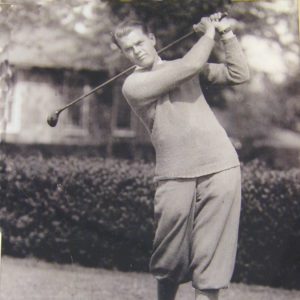
1902–1981. Ralph Beach’s forty years of service and commitment to the MAPGA and The PGA places him amongst the most important figures in MAPGA history. He held the presidential reins twice, once in the 1930s and again in the 1940s. The MAPGA Professional of the Year Award was awarded to him in 1959.
Originally a Virginian, Ralph spent his early years as a caddie at Washington Golf and Country Club, including carrying President Woodrow Wilson’s bag in 1916. He turned professional in 1919 by taking a job as an assistant at the Chevy Chase Club, then moved on to take the head Professional position at Blairmount CC in Altoona, Pennsylvania, during 1924. After one season there, he returned to the Washington area as the Head Professional at the Burning Tree Club, remaining for three years. While at Burning Tree Club he taught the game to President Warren G. Harding. He assumed the head PGA Professional position at The Suburban Club of Baltimore County in 1928, where he held forth until retiring in 1965.
When the MAPGA’s initial organizational meeting took place in 1925 at Columbia, Ralph Beach attended. Along with many other duties Ralph served the MAPGA as its Second Vice President in 1930, First Vice President in 1931, and President in 1932. At the member’s behest, he repeated the terms as Vice President and served as President for another two terms, 1939 and 1940. After World War II, the Baltimore contingent endorsed him as their regional vice president in 1948 and 1949. Nationally, Ralph contributed to the formation of the National Senior PGA group and served as its president in 1961 and 1962.
Noted for his beautiful swing and fine shotmaking, Ralph played as a strong competitor throughout four decades: the 1920s – 1950s. He won the 1931 Maryland Open. Ralph captured the MAPGA Section Championship twice, first in 1933 when he defeated the defending champion, Glenn Spencer. Sixteen years later at Woodholme he bested Andy Gibson, Walter Romans and John O’Donnell when he won the title at stroke play. That year he eagled the par-4 7th hole during the afternoon en route to a one-stroke victory over Walter Romans. Ralph triumphed in the Match Play Championship in 1947. Three consecutive MAPGA Senior Championships, 1953 – 1955, are on his golfing credentials as well as four consecutive MAPGA Senior Teacher’s Trophy titles, 1954 – 1957. Additional accomplishments include winning the Maryland Senior Open in 1955 and the Uplands Open Invitational Senior in 1954 and 1955 at Rolling Road.
Near misses included a playoff loss to Al Houghton in the 1933 Maryland Open; losses in the MAPGA Match Play final to Otto Greiner in 1939 and to Walter Romans in 1946, and a MAPGA Championship playoff loss to Chandler Harper in 1954.
Nationally, Ralph qualified through the Section for eight National PGA Championships: 1925, 1927, 1930, 1933, 1934, 1936, 1945 and 1949, and twice succeeded in making the match play field, 1927 and 1936. Between 1926 and 1936 he played in eight US Opens, making the cut in 1926, 1933 and 1936. His best finish, a tie for 39th at Scioto CC, occurred in 1926. He played fifteen PGA Senior Championships, making the cut seven times, and finished in a tie for third in 1953. (rev. 2003)

Troy Beck, PGA
1954 – 2021
Troy Beck’s thirty-five-year career in golf was served as one of the Section’s major proponents for and leaders in Junior Golf. Furthermore, as both a stellar player and teacher, the LPGA and MAPGA awarded her for significant contributions to their organizations. She received the inaugural LPGA Nancy Lopez Achievement Award in 2008 for Leadership, Passion, Giving and Approachability. The MAPGA recognized her accomplishments with the 2000 Youth Player Development Award. She was honored with the “Lifetime Achievement Award” from the PGA President’s Council on Sports, Fitness and Nutrition. Additionally, in 2016 she organized a PGA of America HOPE program for Female Veterans with instruction by female professionals.
Growing up in Regina, Saskatchewan, Canada, and active in many sports and notably basketball where she played for the Regina University team. As a student she double majored in Biology and Physical Education. Golf seasons are rather short in western Canada. However, at ten-years-old, Troy accompanied her father on one of his golf junkets to California and for her introduction to the game. Subsequently a membership to Regina Golf Club paved the way for her career which began as waitress at the club, followed by a stint in the bag room, then pro shop staff and a grounds crew member.
Once graduating from college, she began playing tournaments, including representing Saskatchewan in the Canadian Nationals to conclude her amateur career. In 1979, the then twenty-four-year-old took a professional position at Soboda Springs CC in Hemet, California. A year later, Troy enrolled in a PGA Business School, one of the first three women to do so. In 1984, Jim Hiskey, a well-known MAPGA Professional at the CC at Woodmore, hired her as an assistant professional. She earned her LPGA membership in 1987, and her PGA membership in 1989. Glen Barrett, the Head PGA Professional at Glenn Dale Golf Club, brought her on as his “first” assistant in 1988. The duo won the MAPGA Pro-Assistant Championship in 1990.
As an advocate and teacher for juniors, Troy established The Troy Beck Golf Academy. She and the academy became well-known throughout the area by touching the lives of some 800 juniors annually. Many came through the Junior Summer Camp program with some 400 children participating in one of nine camps. Furthermore, the early spring months her junior camps provided “free” instruction to approximately 150 over the four-week duration. The overwhelming participation revealed evidence of the positive image and leadership ability required to conduct such a successful program, which Carl Donner of the USGA called the “champion program of the country.”
While maintaining her career long LPGA Class A membership, she organized two LPGA local Girls’ Clubs in conjunction with the USGA and Girl Scouts of America. She also published a quarterly instructional newsletter for junior entitled “Junior Pinseekers,” and another monthly newsletter to LPGA Girls’ Clubs. She won the LPGA’s Teaching and Club Professional Championship in 1994 and in 1995 received the LPGA Northeast Teacher of the Year Award. Noted for her expert use of video golf instruction, Golf For Women listed her in the Top 50 Female Instructors in the Country.” Nineteen of her “students” obtained college golf scholarships. Golf Magazine named her one of the Top Instructors in 2005. Furthermore, she held the LPGA Section President position, placing her on the LPGA Board of Directors, from 2003 – 2007.
With Canadian climates not conducing to developing golf skills, Troy did not begin serious work on her game until after college. However, when she did, she rapidly emerged as a serious player. In 1984 and 1985 she teed it up in the USGA Women’s Open. Then ten years later played in two more majors, the McDonald’s LPGA Championships. She eventually played in 13 LPGA Tour events. She won the LPGA National T&CP Championship at Woodlands Country Club in Texas in 1994. Within the MAPGA ranks, she took Women’s Player of the Year titles in 1993, 1994, 1998 and 2003 along with the Women’s Championship in 1998. In the 1994 MAPGA Match Play Championship, she knocked out well-known MAPGA stars, including Trent Wright, Craig Gunn, Brian Lehnhard and Wayne DeFrancesco before losing to the winner Glenn Barrett. Once she started spending her “winters” in Port St. Lucie Florida in 2000, Troy could be found teeing off in the PGA “winter” tournaments.
Troy Beck’s countless contributions to Junior Golf in the Middle Atlantic Region and the goodwill she promoted earned her the respect of her peers, her community and thousands of juniors who will never forget the difference she made in their lives. Beck is entering based on her sterling playing credentials and is the first female to be inducted in the MAPGA Hall of Fame.
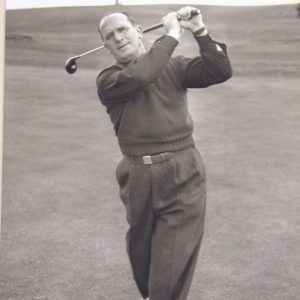
1895-1983. Charles Betschler’s distinguished golf career included launching two regional golf associations that he ultimately served as President: the Maryland State Professional Golfers’ Association and the Middle Atlantic PGA. The MAPGA Senior Championship Trophy is named in honor of Charles Betschler.
A native of Baltimore, Charles Betschler’s life in golf started as an 11-year-old caddie at the Maryland Country Club. The “old” Maryland CC, situated in the Baltimore’s Arlington section, no longer exists. His enthusiasm soon won him the affection of the golfing members who sought him out as a good luck charm. Displaying quite an aptitude for the game, he began giving tips to beginners by his mid-teens. He became an instructor, the caddie master, and then in 1916 the Head PGA Professional, a position he held until 1928. In 1929 he became the Head PGA Professional at Rodgers Forge Country Club (now the CC of Maryland), then moved to the “original” Hillendale in 1935 where he remained until retirement in 1954.
In 1924, when plans emerged to broaden the scope of the District of Columbia Professional Golfers’ Association and the Maryland State Professional Golfers’ Association, Charles Betschler played a prominent role in the formation of the MAPGA. At the time he served as the President of the Maryland group. He attended the inaugural meeting of Maryland, Virginia and the District of Columbia professionals at Columbia in March, 1925, which led to the formation of the Middle Atlantic PGA. In subsequent years, the membership elected him Vice President in 1927 and President in 1928. In 1929, they voted him Treasurer, the first person to hold that position. Then again in 1938, his fellow golfers again installed him as their Vice President.
Known as the “Little Dutchman,” Charlie was not particularly blessed with all of the physical attributes of other golfers, but well-known as one of the toughest match-play competitors of his time. Prior to winning the Maryland State Professional Golfers’ Championship in 1923, 1924, 1925 and 1927, he played in the 1921 US Open. When Charlie captured the fifth edition of the Maryland Open in 1925 at Rolling Road, he was the first professional to do so. His triumph followed a second place finish in 1924 at Baltimore CC – Roland Park course.
The MAPGA Section Championship came his way twice. First, in 1934 at the “original” Hillendale he defeated Johnny Bass, Al Treder, Carroll MacMaster and Al Houghton in match play to gather in the title. In the final match Charlie was 5 down to Al Houghton after 27 holes, but then rallied with birdies at 10, 12, 14, 15 and 16 to get even. Charlie then birdied 17 and halved 18 to win 1 up. In 1936 at Rolling Road, Tommy Ryan, Glenn Spencer, Leo Walper and Cliff Spencer lost to him as he carried the day. Additionally, he had been a semifinalist in 1931 at Woodmont and a finalist in 1932 at Maryland CC where he lost to Glenn Spencer.
His golfing credentials include a triumph in the inaugural MAPGA Senior Championship in 1949 at Woodholme which he followed up victories at Elkridge in 1950 and Bonnie View in 1952. In those days the MAPGA held a senior division within the Section Championship. In 1953, he and Ralph Beach shared the Bill Scott Trophy, accorded to the Senior Sectional Champion at the time, when they each shot 72 at Woodholme. Nationally, Charles Betschler tied for 13th in the 1947 PGA Seniors’ Championship in Dunedin, FL.
Over the years Charlie scored seven holes-in-one. He also established a number of course records: Rolling Road (65), Maryland CC (65), “original” Hillendale (65), CC of Maryland (66), and the “original” Sherwood Forest (71).
At Charles Betschler’s 1954 retirement dinner, Jimmy Roche, professional at The Elkridge Club, said, “If there’s only one man on the golf course and that man is Charlie, you know there’s a gentleman on the course.” (rev. 2007)

Unlike many golf professionals, Glenn’s interest in golf didn’t come at a very early age. He enjoyed sports as a teenager, but baseball was his preferred game. The only child of Allen and June Brown, Glenn was born and raised in Alexandria, VA. He was 16 when his father introduced him to the game of golf at East Potomac Park. His father’s enthusiasm was contagious, and Glenn soon became “hooked.” After a short stint in the Air Force, Glenn looked to golf as a career. In 1971, he declared his professional status and went to work as a shop assistant at Belle Haven Country Club in Alexandria, VA. Glenn earned his PGA membership in 1977, and in 1978 he left Belle Haven to accept a position as Assistant Professional at Westwood Country Club. In 1982, he was promoted to Head Professional of Westwood Country Club, where he remained until his retirement in 2018.
Glenn was well-known throughout the Section for the countless hours of service he gave to the Section, serving as a member or chair of numerous Section committees throughout the years, including Special Awards, Tournament and Long-Range Planning. Most significantly, he served on and chaired the Employment/Club Relations Committee for almost 20 years and continually went above and beyond the call of duty in promoting the PGA professional to employers and the public. He was involved with many seminars in this arena and increased the number of business topics offered by the Section’s education program in order to enhance members’ professional status and value to their employers. Glenn was instrumental in the development of a Non-PGA Facilities Seminar which brought together representatives from facilities who were not currently employing PGA professionals with Section professionals in a relaxed setting to forge stronger relationships and inform them of the benefits of hiring PGA professionals.
Glenn also initiated the revival of a section employment database. His section compensation survey and subsequent publicity campaign resulted in a 60% response rate. The statistics gleaned from these surveys was invaluable in assisting members with job searches, and eventually led to the PGA of America likewise instituting an annual survey. The MAPGA now annually leads the response rate among other Sections, with 80-85% return rate, all due to the habits formed when Glenn was Employment Chair.
He personally met with hundreds of club officials, owners, management companies and public officials to educate them about the PGA. Glenn helped develop and improve compensation packages by designing them to meet a specific golf operation. He received dozens of calls weekly from fellow golf professionals seeking his advice and guidance. In recognition for his dedication and commitment in this area, he was awarded the Section’s Bill Strausbaugh Award on three occasions, 1994, 1996 and 1998; and has been a national finalist three times, 1996, 1997 and 1999, and was selected as the National Bill Strausbaugh Award winner in 2000. Additionally, in 1992 Glenn was recognized for his superb merchandising skills and awarded the section’s Merchandiser of the Year (Private Category) award. Glenn’s distinguished record of service also includes serving on the Central Chapter Board of Directors from 1991 – 1994, Chapter Vice President 1994 – 1995, and Chapter President 1995 – 1996. He served on the section Board of Directors from 1993- 2003 as a chapter officer and then several terms as the Section’s Director-at-Large.
Glenn was a great mentor, and his personal hiring philosophy was to hire good staff, help them establish direction, and then allow them the freedom to execute. This ideology helped seven of his former assistant professionals become head professionals and some win section-level awards. Three former assistants have won the MAPGA Assistant of the Year and the MAPGA Merchandiser of the Year awards, with one winning Professional of the Year (John Madden, PGA).
Glenn lists Charles Muck and Ernie Garlem as his own mentors, the gentlemen who hired him at Belle Haven and Westwood. He notes that they provided him a wonderful opportunity to learn the golf business. He also closely observed Bill Strausbaugh’s ability to communicate with people at all levels and tried to emulate that. Lastly, he often utilized Bill Wallace, a longtime PGA member, as a sounding board and relied on for his advice and knowledge in the golf business for many years.
Glenn had tremendous respect for the rich history and tradition of golf and its many rules and boundaries. He believed it was every PGA professional’s responsibility to promote not only the game of golf, but also the most important principle of the game — integrity.
Glenn always relied on a few tenets for his success. He felt you should know your strengths and weaknesses, be honest, work hard, and remain dedicated. Always hire the very best people available, with a commitment to helping create a working relationship where they understand and learn the golf business and move forward in the industry. And lastly, to treat your employment not as a job, but as a career.
Glenn currently resides in Vienna, VA and still enjoys playing golf, traveling, and seeing his adult children, Kate (Moore) and Allen and grandson Jasper.
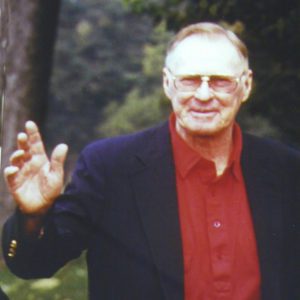
1921-2010. Ward Burgess entered the MAPGA Hall of Fame as a consummate professional who spent nearly a quarter century serving the MAPGA. He held many positions in the Association. First, he chaired the Publicity Committee which oversaw contributions to the PGA News for three years. Then he steered the Tournament Committee in two different tours of duty. For five years he held the Secretary – Treasurer’s job. He also served as the Maryland Vice President. And he led the Senior Association as Chair or Co-Chair for 15 years. As the leader of the senior professionals, he initiated the practice of having the assistants “work” the senior events so that they could get to know the “old guard,” as well as the game. For his meritorious work the MAPGA named him their Professional of the Year in 1961.
During World War II, Ward served in the U.S. Navy aboard a sub chaser as a radio operator in the Mediterranean. His ship participated in the invasions at Anzio, Italy, and then Southern France. The Navy transferred him to the Pacific Theater where he served on the destroyer escort USS Hanna with duty in and around Tokyo, Yokahama, and Yokasuki. He was honorably discharged in 1945.
Ward turned professional in 1947 and the MAPGA elected him to membership in 1948. He worked for Johnny Bass at Clifton Park Golf Course in Baltimore for almost two years before moving to Chevy Chase Club as an assistant for Bob Barnett.
Chevy Chase club members quickly recognized the potential of the young assistant. When Bob Barnett died a few months later, they named Ward Burgess and Bill Hardy the co-head PGA Professionals. After five years, Ward became the sole head PGA Professional until his retirement in 1987.
As a player Ward Burgess first appeared on a leader board at the Assistant Professional Championship in 1948 held at Manor. He finished third behind Bobby Bowers and Severn White. He won or tied for first in pro-ams at Woodholme twice, once in 1949 and then by shooting 67 in 1954. In 1952 he won at Fort Dupont, the next year at Glenbrook and then in 1954 at Court House. In 1954 Ward and two others tied for low of the tournament, 67, in the Maryland Open at Manor. In the Pro-President Series, he and J.P. Marshall won the Pro-Official title in 1961 with a 63 at Indian Spring. He and Billy Bassler tied for first at Beaver Creek’s pro-am in 1969. He won the MAPGA Pro-Assistant Championship with Bob Murphy in 1971 when they combined for 63 at Northwest Park. The year before he and Bill Sporre had finished second at Turf Valley. Also in 1971, Ward, Dennis O’Leary, Claude King and Billy Phillips tied for first at the Country Club of Fairfax pro-am. Ward was victorious in the inaugural MAPGA Quarter Century Championship in 1974. In other senior competitions Ward won his age group in 1977 and 1979.
The MAPGA recognized Ward Burgess for his contributions to the Association’s administration, but also for innovative merchandising and teaching, and for his contributions to the success of pro-amateur tournaments over many years. (rev. 2010)

1923-2008. Bill Clarke rose to prominence as one of the most important figures in the MAPGA and National PGA during the second half of the Twentieth Century. The PGA named him a “Legend” in 1997, the third person so honored.
His interest in golf started as a boy, frequently playing at Forest Park where Jimmy Flattery was the professional. Bill also had an early interest in art, eventually graduating from the Maryland Institute of Art. After service in the Navy during World War II as an aerial gunner, Bill began a career in golf by accepting the Assistant Professional position to Leo Kernan at Princess Anne in 1946. After spending a year as the head professional at Richardson Golf Course (Ft. Lauderdale, Fla.), in 1948 he learned through Jimmy Flattery that Walter Romans sought a new assistant for Baltimore CC. Bill took over the “teaching” responsibilities there. Hillendale Country Club named him their Head PGA Professional in 1954. He remained for 35 years, serving as the club’s Executive Director for 14 of those years.
Bill assumed the responsibility as the MAPGA Tournament Committee Chair for four years, 1955 – 1958. He made a quick leap to the Presidency for 1959 – 1962. The MAPGA named him Professional of the Year in 1960 and the MAPGA Merchandiser of the Year (private category) in 1989 as well. For many years, some golf professionals in Virginia held VAGP membership, but not PGA membership. Bill Clarke, Leo Steinbrecher, Bill Strausbaugh and Carl Rasnic formulated the agreement which gained PGA membership of the VAGP members who had at least five years of professional experience. They entered the MAPGA as full members, and at the time created the Virginia Chapter of the MAPGA in 1966.
Bill Clarke’s rise through the National PGA ranks began as the Regional Vice President [1966 – 1968], Treasurer [1969 – 1970], then Secretary [1971 – 1972] and finally, President, [1973 – 1974]. He also served as Honorary President from 1975-1975. He provided the leadership for many important PGA committees over the years. What he considers his most important contribution was chairing the National Education Committee in 1966 – 1968 which pioneered the Home Study program for the PGA Business Schools. Additional assignments included the membership on the PGA Championship Committee from 1966 onward and chair of the Club Professional Championship Committee. Bill sat in the chairman’s position on the Rules Committee for five years, which is longer than anyone else, beginning in 1966.
He made his mark as one of the quintessential rules officials in the golf world. From 1968 through 1990 he regularly refereed at the Masters. He started as a rules official at PGA Championships in 1966 and “ruled” in a number of Tournament Player’s Championships and in the World Series of Golf. In 1967 he began as a Ryder Cup Official; through 2004 Bill only missed the 1985 Ryder Cup. In 1986, he and Clyde Manguum, the PGA Tour Representative, worked with Royal and Ancient Golf Club to rewrite the rules of golf.
His playing career included third place finishes in the Maryland Open twice, a second in the Howard County Open, and twice a second place in the MAPGA Assistant Professional Championship. That trophy is named in Honor of Bill Clarke. Bill’s credentials include a 67 in 1950 at Fountain Head, a 68 at Green Spring Valley in 1951, and a victory in the Mt. Pleasant Pro-Am preceding the Eastern Open. Bill was the NEWS AMERICAN Maryland Player of the Year for 1960 and 1961 based on a year-long points system.
Bill Clarke is a member of The PGA Golf Professional Hall of Fame Inaugural Class of 2005 and is also a member of the Middle Atlantic Golf Association Hall of Fame. The PGA awarded him the National Horton Smith Trophy in 1968 which “bestows special recognition on a PGA member for outstanding service and contributions toward developing and improving educational opportunities for PGA Professionals and Apprentices.” (Rev. 2009)
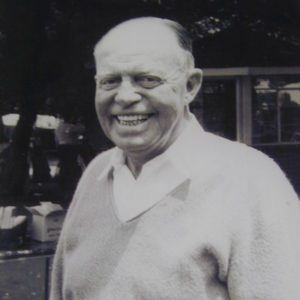
1897–1969. Wilfred “Wiffy” Cox entered the MAPGA Hall of Fame for his contributions to the Section, including a term as President, and for his role as an important figure in the organization that evolved into the PGA Tour. He was a fine teacher with an engaging personality and unique sense of humor.
Wiffy was born in Brooklyn, New York, in 1897, and came to the Middle Atlantic Section in 1935 as the Head PGA Professional at Kenwood CC. From there he moved on to Congressional where he served as the head PGA Professional from 1938 until his death in 1969. During World War II, when the OSS occupied Congressional Country Club, Wiffy held the head PGA Professional position at Hempstead Country Club on Long Island, New York. For a time during World War II, he served with the U.S. Navy as a fireman aboard the USS Nevada. Returning to Congressional in 1947, he rejoined his assistants Jocko Miller, Warner Gray, and Lew Worsham, who all toiled to re-open the course.
The PGA Tour credits him with nine championship victories. The first occurred in the Pinehurst Pro-Pro Medal Play with Willie MacFarlane in 1930. Wiffy led the 1931 money list with $11,000 and held the number one ranking amongst the touring professionals. That year, he won four consecutive titles: the Florida Open, the International Four-Ball with MacFarlane, the North-South Open in a playoff over Joe Turnesa, and the San Francisco Match Play. He also played in the Ryder Cup Matches at Scioto CC in Columbus, Ohio, compiling a 2-0-0 record. In 1932, Wiffy won the Pinehurst Pro-Pro for a second time with MacFarlane. In 1934, he won at the Agua Caliente Open and the Texas Open. Two years later, Wiffy won the Sacramento Open by defeating Bill Melhorn in a playoff. His career best scores include a 64 at Oakmont, California, in 1931; 64 at Westchester Biltmore in 1931, 65 at Tampa in 1933, and 66 at San Antonio in 1930.
Nationally, Wiffy played in six PGA Championships, four Masters, and eleven US Opens. He played in four consecutive Masters, 1935-1938, finishing 12th in 1937 and in a tie for 13th in 1936. His eleven US Open starts took place between 1924 at Oakland Hills and 1939 at Philadelphia CC. He only missed the cut three times. His best finish, a tie for third in 1934 at Merion, found him two shots behind Olin Dutra and one behind Gene Sarazen and tied with Bobby Cruickshank. Other notable US Open finishes included a fourth place tie at Inverness in 1931, fifth in 1932 at Fresh Meadow, and a fifth place tie at Baltusrol in 1936.
Locally, Wiffy won the District of Columbia Open at the original Indian Spring course in 1937, earned the medal at the PGA Qualifier at Baltimore CC-Five Farms in 1938, took the District of Columbia Open again at Washington Golf in 1938, made the US Open field in the Sectional at Congressional in 1939, finished second in the MAPGA Section Championship at Columbia 1939, and lost a playoff to Andy Gibson for last spot in the US Open Sectional at Manor in 1940. In 1942, he won the Washington Open at Indian Spring and the Maryland Open at the original Prince George’s CC in Landover, MD.
He served as the MAPGA President from 1941 through 1943. The membership selected him as the MAPGA Professional of the Year in 1963. In February 1969, Wiffy played his last nine holes, shooting even par, three weeks before succumbing to cancer. (rev. 2011)
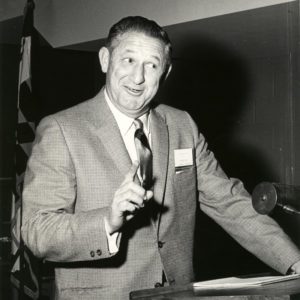
1917 – 1998. Frank Cronin earned the Middle Atlantic Hall of Fame honors for his untiring work in promoting the game and educating a generation of students in Physical Education at the University of Maryland. He coached the University’s Golf and Boxing teams for many years. Frank Cronin is a member of three other Halls of Fame: University of Maryland Athletic Hall of Fame; the Golf Coaches Association of America Hall of Fame; and the Maryland Boxing Hall of Fame.
Within the MAPGA ranks, he served as Treasurer in 1964 – 1967, as Vice President-at-Large in 1968, as Regional Vice President in 1969 and as the Northern Chapter President in 1969. He received the MAPGA’s Professional of the Year honor in 1971 and the Section’s Horton Smith Trophy three times: 1966, 1967, and 1975.
Frank served as a member of the PGA’s Education Committee for three years. He coordinated three PGA Business Schools including the first one ever held outside the state of Florida, conducted in 1966 on the University of Maryland campus.
Originally from Colorado, his family moved to Bel Air Maryland in the 1930s. At Bel Air High School, his athletic prowess led to a University of Maryland track scholarship where be became one of the University’s all-time great athletes in track and boxing. As a boxer he won the Southern Conference Middleweight title in an undefeated season, 1938 – 1939, the only year he boxed. He defeated a United States Golden Glove Champion along the way. Frank was the Southern Conference indoor and outdoor quarter-mile champion five times; and the 1938 Southern Conference pole-vaulting championship. He graduated in 1939 and also received an Army ROTC commission.
During WWII, he served as an instructor at the Fort Benning Infantry School before deploying to the Pacific Theater in 1945 where he served with the Occupation Forces in Japan until returning state side in 1946. Frank remained active in the reserves until the early 1960s when he retired as a Lieutenant Colonel.
Upon returning to the University in 1946 he assumed responsibility for the golf team and a faculty position in the Physical Education Department. Overall, his golf team’s amassed 195 wins against 75 losses and 5 ties. He stepped down as golf coach in 1971, but remained the PGA Director of Golf Operations at the University of Maryland Golf Course until his retirement in 1980. His 1961-1965 golf teams won fifty consecutive home matches (an NCAA record) and his 1964 team tied for first place in the Atlantic Coast Conference. Some of the players he helped develop include Deane Beman, former PGA Tour Commissioner; Bill Calfee, Nationwide Tour President; and countless MAPGA Professionals. Five of his player’s garnered All-America honors: Deane Beman, Vern Novak, Bill Calfee, Rick Bendall and Mike Pratt. He also coached the boxing team from 1950-1954.
In the early 1950s, Coach Cronin launched a successful campaign to construct a university golf course. Using donations and money received from the football team’s appearances in the 1953 Sugar Bowl and 1954 and 1956 Orange Bowls, they built and then opened the course in 1958. Although officially credited to George W. Cobb, Frank was heavily involved in the design of the course.
In his career at College Park, he instructed more than 10,000 students in golf and physical education classes, coached successful golf and boxing teams, created the Women’s Golf Association, and directed the UM junior golf program for 10 years. Furthermore, Frank worked with the Lifetime for Sports Foundation and the National Golf Foundation.
And, even though he came to golf late in his athletic career, Frank Cronin could play. In 1964, he set the course record at the University of Maryland Golf Course, then a par 72, with an eight under par score of 64. He also torched Prince Georges CC with a 67 that included nine 3s on his card. (rev. 2007)

1894 – 1975. Robert Cruickshank entered the MAPGA Hall of Fame for his outstanding play at the regional and national level and for his contributions to the formation and leadership of the Virginia Association of Golf Professionals.
Born in 1894 in Scotland, he emerged as a golfing rival of Tommy Armour, but in school also starred in track and boxing. Bobby matriculated at Edinburgh College in 1914, but soon thereafter joined the Army with the outbreak of World War I. While a prisoner of war in Germany, he saved Sandy (Tommy’s brother) Armour’s life. Ironically, Bobby won the Edinburgh Trophy in 1919 by defeating Sandy Armour and repeated that victory in 1920.
He migrated to the United States in 1921 and turned professional holding assistant professional positions at Shackamaxon Country Club, Twin Hills, and Purchase Country Club. From 1932 to 1947, Bobby served as the Head PGA Professional for the Country Club of Virginia. He left there moving to Chartiers Country Club in 1948 where he remained until his retirement in 1968. “The Wee Scot’s” PGA credentials count 17 official tour victories. In 1927 Bobby won the Los Angeles Open, the Texas Open, the Hot Springs Open in Arkansas, the International Four-Ball in Miami with Tommy Armour and the North and South Open. He also led the PGA Tour in money earnings that year.
On the national scene he played in twenty-three US Opens, six Masters, and thirteen PGA Championships. Highlights of his US Open career include a playoff loss to Bobby Jones in 1923, a second place finish to Gene Sarazen in 1932, and a third place behind Ralph Guldahl and Sam Snead in 1937. Bobby’s last appearance, in 1957, occurred after he turned sixty-three years old. A fourth place finish in the 1936 Masters highlighted his career at Augusta. In thirteen PGA Championships beginning 1921 and concluding in 1951, he earned his way into the match play portion eleven times, advancing to the semifinals twice, but losing to Gene Sarazen in both instances.
Regionally, Bobby won six Virginia State Opens: 1933, 1934, 1935, 1936, 1937 and 1939. He won the Virginia State Open in 1934 at Old Dominion in Newport News by ten, by seven in 1935 at Old Dominion again, and over Errie Ball in a playoff at Farmington CC in 1937. Before arriving at the Country Club of Virginia in 1932, he won the Maryland Open in 1928 at Baltimore CC-Five Farms by two over Tommy Armour. And in 1934, Bobby and Tommy Armour succeeded in the Pinehurst Fall Pro-Pro.
Additionally, as an MAPGA player between 1932 and 1947, Bobby laid out an impressive set of accomplishments. He captured the 1933 PGA Qualifier; qualified for the1934 US Open in a playoff over Al Houghton; won the 1934 National Capital Open at Kenwood, a PGA Tour event; and played on both the 1935 MAPGA team and the Virginia team against the touring Japanese All Stars at Kenwood and at the Cascades. His 1945 MAPGA Section Championship, which also served as the PGA Championship qualifier, found him ahead of Andy Gibson (by 4) and Ralph Beach (by 5).
After leaving the Country Club of Virginia, Bobby won the Tri-State PGA Championship in 1949 and 1950, and played in several more US Opens, the last in 1957. The Tri-State PGA Section has elected him to their Hall of Fame as well. Towards the end of his career, Bobby played in seven PGA Senior Championships, finishing tied for 36th in 1964 and 1968.
On the personal side, “the Wee Scot” was well-known as a fisherman and expert flycaster. The National PGA Hall of Fame inducted Robert Allan Cruickshank in 1967. (rev. 2011)

1925-1978. Bill Deck entered the MAPGA Hall of Fame for his contributions to the Association, for excellence in teaching, and for stellar play. He considered his most important contribution the initial handicap recording system used throughout the Middle Atlantic area which eventually spread nation-wide. The program still generates revenue for the MSGA, VSGA, and MAPGA more than thirty years later. As an officer in the MAPGA, Bill served as the Secretary (1972-1974), Treasurer (1973-1977) and a member of the Executive Committee. The MAPGA named him the 1975 Professional of the Year. During the mid 1970s, Bill Deck’s architecture of the Section’s ATP (Associated Tournament Players) series upgraded the tournaments and enhanced the payouts for the Monday and Friday pro-amateur tournaments.
A native of Washington, D.C., Bill took up golf around age 13, but didn’t become serious about it until the early 1950s during his late 20s. Athletically, he stood out as a basketball player for Eastern High School. Bill completed a year at George Washington University, but the lure of becoming a pilot brought enlistment as a Naval Air Cadet as World War ended. Unfortunately, he sustained a broken neck while wrestling in a match during basic training just after turning 21.
For the next eleven years he worked as a meteorologist for the U.S. Weather Bureau. During this time he took a serious interest in golf. To sharpen his game, he frequented the well-known and historic gambling matches at East Potomac Park Golf Course, a public course that attracted talented golfers and hustlers.
In 1957, Bill accepted a job as an assistant to Walter Potter at the National Naval Medical Center course. In 1959, local Maryland businessman Doug Smiley formed a corporation which bought the Maenner Farm in Bowie, Maryland. They developed it into Belair CC and Bill served as the head PGA Professional at from the day it opened in 1959 until 1977. Then he moved to Hillsborough Country Club in Neshanic Station, New Jersey.
As a player, he went out on the Winter Tour twice and onto the Caribbean once during the early 1960s. Bill played in six PGA Tour events during that time and in 1965 qualified for The PGA Championship. In 1963, he won the Panama Open on the Caribbean Tour. Bill was the runner-up to Dick Mullen in the 1961 MAPGA Match Play, the Baltimore City Open. He once shot 62 at Bowie.
The 1964 MAPGA Section Championship victory highlighted his career, winning at Manor with a 71-69, even-par score. On the second day, Bill bested the leading players of his day, including Jimmy Clark from Argyle; Dick Sleichter, the defending champ; former champ Clare Emery; and Paul Haviland, a former MAPGA and Maryland Open Champion. During the second round he birdied the ninth after getting home in two, birdied the 10th, nearly holed out for eagle on the 12th, and birdied the 14th to sew up the tournament.
Throughout the mid 1960s, he, Tony Marlowe, Ward Burgess, George Pigott, Bill Clarke, and Henry Girardi called themselves the “The Big Six.” They held a standing challenge in every tournament with the three highest scorers treating the lowest scorers to a “fancy” dinner afterwards. In 1968, he won three pro-amateur tournaments. He and Larry Wise tied at Maryland Golf, but won outright at Bonnie View and at Indian Spring. He won the 1972 pro-member at Fredericksburg CC. Bill Deck is one of those rare PGA professionals who served the MAPGA as both a magnificent player and organizational leader. (rev. 2004)

Wayne DeFrancesco’s exemplary golf career as a player and teacher earned his place in the Middle Atlantic PGA’s Hall of Fame. Over the organization’s history only he garnered both Player of the Year status and a Teacher of the Year recognition. Additionally, Wayne won the Section Championship three times and also received the Horton Smith Award for contributions to education. No other player in the Section’s history displays such an array of credentials.
Wayne was introduced to golf by his father, Henry, and his mother, Bobbie, who joined Lakewood Country Club in Rockville as charter members in 1959. Henry was an engineer and mathematician by trade, and thus he found the mechanics of the golf swing quite interesting and challenging. Wayne remembers having Ben Hogan’s “Five Lessons” and Cary Middelcoff’s “Master Guide to Golf” on the shelf from the time he could read. Henry had Wayne in the back yard hitting whiffle balls by age 8 and by age 10 they were out at Lakewood playing. Wayne played in his first event at age 12 and finished 2nd, and getting that trophy hooked him for life.
His successful playing career spans five decades, first serving notice winning the Washington Metropolitan Golf Association’s Bobby Gorin title in the thirteen-year-old and under division in 1971 and followed up with a win in the 14–15 year-old division two years later. Playing out of Langley HS, he captured the Frank Emmet School Boy Championship in 1975 and was named “Junior of the Year.” For success in a premier amateur career, the trophy case includes the Washington Metropolitan Amateur titles in 1978 and 1981, First Team All-America and Southeastern Conference Champion at Louisiana State (LSU) in 1979, as well as appearances in the 1975, 1978 and 1979 US Amateurs, where twice he went to the round of 32.
Within the Middle Atlantic PGA, Wayne DeFrancesco was a frequent visitor to the winner’s circle. He triumphed in the Section Championship on three occasions: 2000, 2001 and 2007; the Tournament of Champions twice: 1995 and 1998; the Assistant Professional Championship twice: 1999 and 2001. He won the Match Play Championship three times: 1996, 2004 and 2006; and the Senior Championship twice: 2007 and 2008. The MAPGA Player of the Year title came his way four times: 1994, 1995, 1997 and 2001. Over the years, additional victories include the Team Championship with Rick Schuller in 2006 and 2007, the 2009 and 2010 Facility Championship with Jay Lindell, the Senior-Junior Championship with Pat Coyner in 2014, and the Challenge Cup Tom Strange MVP Award in 1998.
Regionally, Wayne captured the Maryland Open three times: 1994, 1995 and 2005; and the Maryland Senior Open in 2007.
Nationally, Wayne played in his first PGA Professional National Championship in 1995, finishing 5th and qualifying for his first PGA Championship at Riviera, where he made the cut and was the Low Club Professional. Wayne then qualified for his 2nd PGA in 1999, playing at Medinah CC. In his next PNC Wayne went to Bend, Oregon and led the event wire to wire (the only person to do so, leading alone every round) winning by 3 shots, a victory he considers the greatest of his career. In all, Wayne played in 5 PGA Championships, a U.S. Open (as an amateur in 1981 where he was Sectional medalist at the Army Navy Club, making the U.S. Open field at Merion), two Senior PGA Championships, a Senior US Open, and qualified for eleven PGA Tour Kemper Opens. In addition, Wayne won 4 USGA medals as medalist in local U.S. Open qualifying.
“As soon as an instructor stops teaching beginners he or she ceases to be qualified for any honors…” so sayeth Wayne DeFrancesco. However, the accolades include the MAPGA’s Horton Smith Award for Education in 1998, and the Teacher of the Year (1994) recognition. He is both student and teacher of the game, participating in the PGA National Cracker-barrel, and Teaching and Coaching Summits, and becoming more than well-versed in the instructional literature. Accolades include Golf Digest’s 50 Greatest Teachers, and Golf Magazine’s Top 100 Teachers. His contributions to the literature include a four page spread in Golf Digest entitled “Drive 45 for Power,” Sports Illustrated articles and a three page piece on iron play in the 2008 PGA Guide to Instruction. Furthermore, he authored a long list of articles for GolfStyles Magazine over thirteen years.
Objectively, his teaching attempts to “try to organize the information and teach you how to use your mental abilities in order to take what you learn out on the course and use it.” Wayne’s instruction is grounded in learning theory, technology and social media which emphasizes ongoing development for players at all levels of their potential. Given the difficulty of the sport he states that “best thing you can do is arrange for first rate instruction, but with the proviso there are no quick fixes. He has been particularly successful in guiding young teenagers through the ranks of junior, high school, collegiate and in some cases professional careers. At one time or other his younger students subsequently won a Virginia State Amateur, another qualified for two US Juniors and two US Amateurs, and one other won the Maryland State High School title and the State Amateur, and a young girl made First Team All-Ivy League. Amongst his professional peers, Wayne coached quite a number, most notably guiding Kevin Streelman to a victory in the PGA Tour’s Travelers Championship, and others have taken the time to study how he teaches. Such an honor is accorded to very few colleagues.
The Wayne DeFrancesco Learning Center offers both in person and online instruction as well as presentations and seminars. The attendant library includes “Lessons of the Week Videos” and online lessons and golf swing analysis, replete with copious articles on every aspect of the game. Wayne’s visibility on the internet has helped garner him lessons with such players as Brad Faxon, Tom Kite, Nick Price, Aaron Baddeley, Kevin Streelman, Len Mattiace, Gary Hallberg, Dick Mast, Andrew Loupe and Willy Wilcox.

Bob was born August 27, 1961 and grew up in Long Island, New York as part of a large family. His parents, Bob and MaryAnn Dolan, were very supportive of their children, offering encouragement at every opportunity. His father taught him to play golf when he was ten years old while living in Rhode Island. As a young man, Bob participated in several team sports, but he was particularly drawn to golf because he realized that his success was dependent solely upon himself.
Bob got his first golf-related job when he was 16 years old working at Fernway Driving Range under the tutelage of PGA Professional Luther Showaker. Bob turned professional and entered the PGA apprentice program in 1983 and was elected to membership in 1987. He worked at Leisure World Golf Club, Montgomery Village Golf Club and Chevy Chase Club as an assistant professional. Bob served as the Head Professional at South Seas Plantation on Captiva Island, Fla., Hidden Valley Resort in Somerset, Pa. (1987-1992) and Lakewood Country Club in Rockville, Md. (1992-1994). He then succeeded the legendary “Coach” Bill Strausbaugh at Columbia Country Club in 1995 and will move to Professional Emeritus at the end of 2022 after a 27-years as Head PGA Professional.
Bob received numerous awards at both the Section and National level. Middle Atlantic Section accomplishments include the 1996 President’s Award, 1997 PGA Professional of the Year, 1998 Junior Golf Leader, 1999 and 2010 Bill Strausbaugh Award, 2004 Professional Development Award and 2011 Merchandiser of the Year (Private). He was recognized by the National PGA with the 2000 Youth Player Development Award and the 2011 Bill Strausbaugh Award. He is one of the very few PGA professionals to win two or more National Awards (believed to be only 68 in PGA history).
Bob is the consummate PGA Professional. He not only understands – but embraces – all aspects of what it means to be a PGA Member. He personally works to “wear all the hats” of a PGA member. At his core, he is about service: service to his members, to his fellow professionals, to his students, to the community and above all to the game of golf. He works every day to both grow the game and further everyone’s love for the game. He is deeply committed to promoting diversity, equity and inclusion in the game and growing and developing the golf industry’s workforce. He respects the history and traditions of the game and believes that golf is a vehicle through which he and others can bring people together and teach valuable life lessons. He is and always has been a wonderful ambassador for the game and an outstanding representative of the Middle Atlantic Section. Bob simply loves the game of golf and those that play it!
Bob has held all of the offices in Middle Atlantic Section, including his service as Section President in 2002-2003. He has served on the Employment, Government Relations and Special Awards Committees of the PGA of America and is a regular attendee at PGA Annual Meetings. He also chaired the Presidential Advisory Board for TaylorMade Golf from 2004-2011.
Two of his primary career passions are junior golf and career development among PGA members.
Bob has led many initiatives in junior golf. For example, he was instrumental in creating the MAPGA Junior Tour in 1998. Today, the Tour has over 60 events and with approximately 750 annual participants. Bob is also incredibly active in junior golf throughout the area. His work with The First Tee of Greater Washington DC included not only serving on the Executive Committee as chair of the Program Committee but also actively teaching golf and life skills. In addition, he works closely with other organizations such as The Neediest Kids Charity and Golf in Schools. It is certainly appropriate that the PGA of America awarded Bob the National Junior Golf Leader Award in 2000 (it has since been renamed the Youth Player Development Award).
Following in the footsteps of his predecessor and mentor, PGA of America Hall of Famer Bill “Coach” Strausbaugh, Bob has spent the past 27 years being the go-to person for professionals throughout the Middle Atlantic on issues of employment, professional growth, and career development. Bob recognizes Luther Showaker, Jack Doser, Jerry Heard, Bill Strausbaugh, Jim Fitzgerald, Jim Folks, Dennis Satyshur, Bob Ford, and Ward Burgess as his PGA mentors and tries to “pay it forward” to young professionals in our industry. In addition to the countless hours, he has spent coaching and mentoring fellow professionals, Bob also found time to create and launch the MAPGA Employment Summit to benefits professionals throughout our Section. The original Summit was such a success that the Section has institutionalized it as an annual event hosted in recognition of Bob at his home club. In fact, PGAHQ plans to duplicate the idea at the national level, and plans to host the first event at Columbia CC. It is no wonder that the PGA of America awarded Bob the National Bill Strausbaugh, Jr. Award in 2011.
Bob’s leadership role also extends to the community. Whether it be Board service or simply leading specific initiatives, organizations such as The First Tee and Folds of Honor rely on Bob in so many ways. His work ethic, professional demeanor, style, and approach inspires people to support the causes he champions. This work has resulted in not only significant financial support to these organizations but increased awareness, education and understanding of their important work.
The First Tee-DC hosted a “Bob Dolan Roast and Toast,” hosted by Tony Kornheiser and Michael Wilbon, to raise over $100,000 for First Tee programs. In 2020, Bob and his team developed a program believed to be “first of its kind” which allowed for First Tee of DC kids to earn honorary guest privileges at Columbia CC. Bob has hosted a bi-annual Folds of Honor event in 2017 and 2019, with amateurs playing with members of Congress and PGA professionals, and raised over $350,000 for FOH, easily a top fund-raiser for that charity. Lastly, he was asked and proudly serves on the PGA Leadership group with PGA Magazine.
Bob’s commitment to his profession is surpassed only by his commitment to his family. He and his wife, Dawn, have been married since 1985 and have two adult children, Bobby and Shannon.
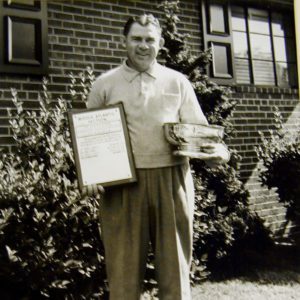
1909–1999. Clarence Doser earned MAPGA Hall of Fame honors for his high caliber of play over four decades in regional and national circles. He was the MAPGA Player of the Year in 1958 nearing his 50th birthday.
At age 45, Clarence Doser moved to the Middle Atlantic Section in 1954 as the Head PGA Professional for Woodmont Country Club. Already a distinguished professional, he concluded his career with seven more years at Woodmont Country Club and then 15 years at Washingtonian Golf and Country Club before retiring to Florida in 1976.
Clarence Doser’s successful career got underway in 1929 when he reached the PGA Championship Match Play field, but lost a first round match. His early triumphs included the 1929 and 1935 Western New York PGA Section titles. Add to this the 1932, 1933 and 1934 Western New York Open, the Rochester Open in 1933 and 1935, the Buffalo Open in 1934 and 1935, and the Central New York Open in 1936. He played in many PGA Tour events throughout the remainder of the 1930s and into the 1940s. Before arriving in Maryland, Clarence won Metro New York Connecticut title in 1945, 1948 and 1953, and the Greenbrier pro-am in 1953. After arriving in Maryland he regularly played in the PGA Tour’s Eastern Opens. In that event, he finished 9th in 1958.
In the MAPGA, he won the Section Championship in 1955 and 1958 and the Match Play Championship in 1956. Clarence captured the Senior Championship six times: 1962, 1965, 1967, 1968, 1969 and 1971. In 1958 he triumphed in the MAPGA Senior Teacher’s Trophy Championship at Woodholme and repeated the next year at Columbia. He triumphed in the Salisbury Open at Green Hill and the Howard County Open at All View in 1962, and the 1963 Maryland Open in a playoff over Dick Whetzle and Cosimo Tiso at Suburban. In 1975, Clarence won the MAPGA Quarter Century Championship.
In 1959, up against national figures, he and Lew Worsham defeated Sam Snead and Dick Iames in an exhibition at Court House CC. His 68 that day, low round of four players, put him two shots ahead of Sam Snead and three over Lew Worsham.
On the national stage, Clarence Doser played in 21 PGA Championships. His best showing occurred in 1945 when reached the semifinals. He lost to Sam Byrd who in turn lost to Byron Nelson in the finals. Several years later, in 1952, he reached the quarterfinals, only to lose to Jim Turnesa, the eventual PGA Champion. In his final PGA Championship appearance at age 52 in 1961, Clarence finished tied for 37th in the stroke play competition at Olympia Fields CC.
In 20 PGA Senior Championships, he made the cut 15 times. His highest finish, 3rd, occurred in 1961. Clarence’s accomplishments in those championships are attested by two top 5s, five top 10s and 11 top 25s. He played and made the cut for the last time in 1981 at 72 years of age. In 1973, at age 64, he finished 86th in the PGA Club Professional Championship in one of his three appearances in that series.
In US Open competitions, Clarence earned trips to the championship 19 times between 1930 and 1963, making the cut six times. A tie for 13th in 1952 highlighted his US Open career.
In two Master’s appearances, Clarence finished tied for 34th in 1953 (Ben Hogan won the Green Jacket) and for 38th in 1954 (when Sam Snead beat Hogan in a playoff for the Green Jacket). He shot his best round at Augusta in 1953, a 71, and in 1954 a 72.
Beginning at the age 64 Clarence Doser shot his age more than 1644 times. At 79, he shot a 74 to finish in the runner-up spot in the South Florida Seniors in West Palm Beach, beaten only by a 50-year old. (rev. 2007)

Kenwood Country Club, Bethesda, Maryland
Hall of Fame Class of 2013
1901-1977. During a fifty-seven year golf career, George Diffenbaugh rose from the caddie ranks at Baltimore CC to the Presidency of the MAPGA. He started as a caddie at Baltimore CC in 1917 under Aleck “Nipper” Campbell, a founding member of the PGA of America. George Diffenbaugh assumed the Presidency of the Middle Atlantic PGA in 1937. Towards the end of his career the Section awarded him the “Professional of the Year” distinction in 1957. As a pioneer, he attended the formative meeting on the Middle Atlantic PGA on March 2, 1925.
In 1925 George had relocated to Rock Creek Park Golf Course in the District of Columbia. Then served as an Assistant to J. Munro Hunter from 1928 – 1932 and then Head Professional at Indian Spring until 1938. He replaced Wiffy Cox at Kenwood later in the year where he remained for 38 years. As a teacher he played a prominent role in the development of a number of young amateur “stars,” including Roger Peacock, Bobby Brownell, Betty Palmer Meckley and June Nelson.
The first reference to George Diffenbaugh’s playing came in the 1922 Maryland State Professional Golfers’ Association (MSPGA) “Open.” During 1923 he won two MSPGA tournaments. He finished second to Toney Penna in 1928 MAPGA Assistant Professional Championship. As a player, high High Hfinishes in Maryland Opens marked his career. In 1931 he finished second to Gene Larkin at Congressional, then in 1932 and 1934 second to Al Houghton. In the 1935 MAPGA Championship he lost to Johnny Bass in the final match. Later in 1935, George secured a prominent win by taking the District of Columbia Open at Indian Spring and pocketing $75. Carroll MacMaster stated that the diminutive George Diffenbaugh got his great length from a perfect pivot.
In 1937 he qualified for the PGA Championship. George succeeded in the 36-hole qualifier at the Pittsburgh Field Club gaining entry to the match play portion, but lost in the first round. George qualified for the US Open in 1940 and the PGA Championship a second time in 1946.
Over the years he successfully played against nationally known figures in exhibitions. In 1928, George and J. Munro Hunter halved the British team of Aubrey Boomer and Archie Compston. In 1931 they lost to Billy Burke and George Von Elm, the US Open Champion and runnerup by one. In the 1934 Mid South Professional Foursome matches at Pinehurst, he and Andy Merrilees defeated Bill Melhorn and Vic Ghezzi in a match. In 1934, he and Al Houghton along with Roland MacKenzie and Roger Peacock, played two exhibitions with Lawson Little, the 1934 and 1935 US and British Amateur Champion. During 1935, George and Al Houghton played two exhibitions against “tour” stars Jimmy Thomson and Henry Picard, halving the first, but losing the rematch 1 down.
In 1938 Merrell Whittlesey reported that George provided group lessons to competing teams in the District of Columbia schoolboy matches. Furthermore, he pushed his fellow professionals to give lessons free of charge to any schoolboy golfers and routinely attended the annual meetings of the scholastic body overseeing golf.
Organizationally, not only did George Diffenbaugh serve as President of the MAPGA, he did so during a difficult time for professional golf, the “Great Depression” of the 1930s. He, along with Al Houghton, successfully upgraded the purse and status of the Section Championship starting in 1937 held at the Chamberlin in Hampton. They changed the format to 72-hole stroke play and the number of players increased, particularly Virginians. In fact, for the first time professionals from Richmond, Hot Springs, Charlottesville and the Norfolk area entered.
George Diffenbaugh is one of those MAPGA personalities who made substantial contributions to the organization, but succeeding generations lost sight of his place in the organization’s history. So much so, that his recognition as “Professional of the Year” in 1957 did not appear in the MAPGA Annual until 2005 when his award came to light. The specific citation credited him with contributions to “Junior Golf.”
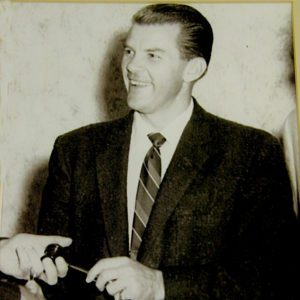
1920-2008. Max Elbin entered the MAPGA Hall of Fame for his leadership of the Middle Atlantic PGA and for steering the National PGA through not only of the most difficult times, but also one of the most rapidly changing eras in professional golf, the late 1960s.
Max Elbin and his brother started in golf by shagging balls and carrying “Sunday bags” at Cumberland CC in 1930. By thirteen Max was playing the game and in short order won the Cumberland CC Caddie Tournament in 1936. He also won the City Championship. At Allegany High School, where he was the Class President, Max played basketball, soccer, baseball and ran on the track team before graduating in 1938. His sports achievements brought him basketball and golf scholarship offers from the University of Baltimore.
Max turned professional in 1940 as an assistant for Lew Worsham at Burning Tree Club. He worked for Worsham during the summer months and then with Bob Barnett at Indian Creek Country Club in Miami over the winters.
After two years at Burning Tree he joined the Army Air Corps in 1942. The military initially assigned him to the U.S. Army Air Corps Headquarters Technical Training Command. From there he served with the Flying Training Command in Texas, and ultimately landed in the Pacific Far East Theater with a B-25 group where he saw the War upfront in New Guinea, the Philippines and eventually in Tokyo.
After the War, he returned to Burning Tree, but by that time Worsham’s interest had turned to the PGA Tour. The story goes that in May 1946 Lew went off to play the Philadelphia Inquirer Open leaving Max in charge. Lew didn’t return. For nearly fifty years he tended to the club’s membership, became an integral of the MAPGA’s leadership cadre, and the advanced through the ranks of the National PGA ultimately becoming President.
His “organizational” career began as the Section’s Publicity Committee Chair in 1949, followed by chairmanship of the Tournament Committee (1952 and 1953), Regional Vice President in 1954, and ended with Presidential terms in 1956, 1957 and 1958. When the Section expanded their “Executive Committee” in 1963 from 8 to 11 members Max won one of the three new slots which he continued to hold for several years. At the time, his contribution to the Section involved the development of a standard “PGA Professional’s Employment” contract that was widely used for many years. The Section selected him as the MAPGA Professional of the Year in 1962.
From the top position in the Section, Max started out on the path that led to the National PGA Presidency. He was elected to National PGA Treasurer in 1964, Secretary in 1965, and President in 1966 – 1968. Max steered the PGA during one of its difficult periods, the mid 1960s when the “touring pros” splintered toward their own organization. During that time he also oversaw the development of arrangements with the television industry by guiding the negotiations of the first TV contract. Furthermore, he was instrumental in early PGA educational efforts by hiring their first Educational Director.
As a Head PGA Professional he tutored many young professionals who went on to become prominent in their own right. By the time he retired in 1995, some 39 of his assistants had moved up in the ranks.
The PGA recognized Max Elbin as a “Legend” in 1995, becoming the first Past President so honored. In 1997, the Middle Atlantic Golf Association inducted him into their Hall of Fame. Max also received the Richardson Award in 1967, the highest honor bestowed by the Golf Writers’ Association of America. He also received the Washington Touchdown’s Club “Timmie” Award. He played with, or taught golf to, Presidents Eisenhower, Kennedy, Johnson, Nixon, Ford, and Bush.
The MAPGA Head Professional Championship trophy is named in honor of Max Elbin. (rev. 2009)

1925-1980. Clare Emery earned MAPGA Hall of Fame honors for his outstanding playing record and for his contributions to the game. As a father figure to his employees, Clare assisted many of his assistants in becoming Head PGA Professionals. He was a superb teacher of the game who taught his students patience and the art of playing within their ability. In 1960 and 1967 he won the coveted MAPGA Player of the Year title. His peers awarded him the Tom Strange Memorial Trophy in 1977 as the MVP of the Yamaha Challenge Cup Matches.
Administratively, Clare served as a Vice President-at-Large for the Middle Atlantic Section for a number of years. Most importantly the Middle Atlantic PGA recognized him as their 1977 Professional of the Year, the Section’s highest honor for active PGA Professionals.
He served as the Head PGA Professional at Washington Golf & CC from 1954 until his death. Described as a wonderful gentleman, Clare meant many things to many people. An honorable man, known for his class and gracious demeanor, he could tell a great story and always found time to listen to the jokes and stories told by his members. The service Clare provided to his club members matched his outstanding playing ability. Regardless of how busy, he always made himself available to expand a member threesome into a fun foursome.
Born in Salt Lake City, Clare’s father was the superintendent at three municipal courses and introduced him to golf at age nine. He started working on the grounds crew at 16, then as a starter, and in 1948 turned professional. Clare moved to Woodmont CC as an assistant to George Fazio in 1950. After Fazio left Woodmont in 1950, Emery eventually moved to Congressional CC working for Wiffy Cox. Clare was elected to membership in The PGA in 1954, the same year that Washington G & CC selected him to succeed Earl Fling as their Head PGA Professional.
Clare won several Section Championships, including the 1961 MAPGA Section Championship, MAPGA Senior Championship five consecutive times (1975-1979), and the MAPGA Quarter Century Championship twice (1978,1979). In 1959, Clare won the MAPGA Pro-President with James Murphy. He won countless Pro-Am tournaments over the years. Regionally, he captured the1951 District of Columbia Open, 1960 Howard County Open, 1960 Eastern Shore Open.
On the national scene, Clare played in seven PGA Championships (1958,1959[T-28th], 1960, 1962, 1963, 1967 [T-64th], 1974[78th]); two US Opens (1957,1967), and five Senior PGA Championships (made all five cuts and tied for 3rd in 1977). One memorable experience for Clare took place during the first round of the 1967 PGA Championship at Columbine CC in Denver…he was walking up the ninth fairway, looked up to see the leader board, and there it was right at the top, Emery – 2 under! Years later in the final round of the 1977 Senior PGA Championship, Clare fired a 67 and passed half the field as the next best score was a 70 (George Bayer) and the eventual winner, Julius Boros, shot 72. The weather conditions included numbing cold, icy rain, tremendous winds, and fog!
Furthermore, Clare competed in seven National PGA Club Professional Championships, making three cuts with his best finish at T-21st in 1973. He also qualified and competed in the first US Senior Open won by Roberto De Vicenzo at Winged Foot GC. He competed in four PGA Tour events, making all four cuts. Clare was simply an outstanding iron player and many believe he would have made it on the PGA Tour if his putter would have behaved a bit better.
Clare suffered a fatal heart attack as he was preparing for his afternoon tee time in the Charles Town Golf Classic in West Virginia. He had just finished lunch and was trading stories with some of the MAPGA professionals who had completed their earlier round. Washington G&CC honored Mr. Emery by renaming the Club Championship Cup (donated in 1916) the Emery Cup. (rev. 2009)
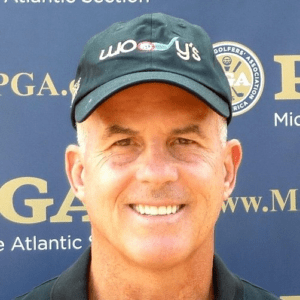
Woody FitzHugh’s distinguished playing during the 1980s earned MAPGA Hall of Fame honors. Capturing the MAPGA Section Player of the Year titles four times: 1981, 1984, 1985 and 1987 included not only two Section Championships, but also three Virginia Opens.
Additionally, he spent three years on the PGA Tour, 1980 – 1982. Nationally in PGA Championships, he played in two PGA Championships (1980 and 1988), qualified for the Professional National Championship twelve times, and played in the Senior PGA Professional National Championship three times (2005, 2006 and 2007.
Growing up in McLean, Virginia, during the 1950s with his brothers Gill, Philip and Grayson, Woody attended Langley High School where he wrestled, and played on the baseball and basketball teams, starring in baseball. Following high school, Woody attended Hampden-Sydney College, playing on the baseball team. However, some unhappiness with his playing time led to expressing disappointment to Colonel Gustav Franke, his math professor, but also the college’s golf team coach. Col. Franke invited Woody to his make-shift driving range, a set up in one of the campus building’s basement. Hitting into a little net in this basement was where Woody had his first taste of golf. From that point, Woody decided to say good-bye to baseball and start a new life with golf.
The golf team practiced occasionally at Longwood College Golf Course in nearby Farmville where PGA Professional Mac Main, Sr. held forth as the head golf professional. Mac noticed Woody on the practice range, decided to give him instruction on his grip, and from there taught him how to play the game. Mac Main, himself already won two MAPGA Section Championships and a Virginia PGA Championship, had also played on the PGA Tour. Between the leadership of Col. Franke and the golf knowledge of Main, Woody started to develop one of the finest golf games in Virginia. While still in the amateur ranks, he finished second to his brother Gill in the Washington Metropolitan Amateur Championship in 1973. Little did he know at that time that his talents would take him to the highest levels of tournament play.
Woody graduated in 1974 with a BA in Psychology and immediately decided on pursuing a golf career. His first golf job was an assistant golf professional position at Washington Golf and Country Club in Arlington, Virginia, to PGA Hall of Fame member, Clare Emery. After five years there, he struck out to play tournament golf for a living, earning a PGA Tour card. Woody spent three years on the PGA Tour where he played in 53 events, made eight cuts and had one top 25 finish. He only lost the 1980 Buick Open by four strokes to Peter Jacobsen after an opening round of 76. Also during this time, he established Woody’s Golf Range Inc.; a full service golf range that now includes batting cages, volleyball courts and a miniature golf course. Woody’s Range has been Woody’s passion for over 32 years.
A PGA Member since 1978, Woody established a very impressive tournament record within the Middle Atlantic region. He is a three-time State Open of Virginia Champion (1984, 1986, and 1988). In one of the three State Opens, he defeated fellow Virginian and World Golf Hall of Famer Curtis Strange. Furthermore, Woody’s successful playing career also includes two-time MAPGA Section Professional Champion (1981 and 1985), an MAPGA Head Professional Champion (1988), an MAPGA Team Champion (1987), a four-time MAPGA Player of the Year winner (1981, 1984, 1985 and 1987), and a Middle Atlantic Open Championship (1984). In addition to these impressive finishes, Woody holds 15 course records, made 13 holes-in-one, and won more than 75 Pro-Am events. At one stage in his career, he played in eight consecutive events without making a bogey. In 2000, Hampden-Sydney awarded Woody with a Special Citation into their Athletic Hall of Fame. “If you can’t do it in a tournament, you haven’t practiced enough,” states Woody on his personal golf philosophy.
Outside of golf, Woody has been very active in his community. In 1996, he established the Jeremiah House in Paeonian Springs, Virginia which was a home for battered and unwed mothers. The women who stayed at the Jeremiah House were provided medical care, so they could birth their children safely and then find occupations to get back on their feet. Over 50 babies were saved from abortion through Woody’s services at the Jeremiah House. An interesting side note about Woody is that he played Aide-de-camp to General Robert E. Lee in the movie Gods and Generals (General Lee’s character was played by Academy Award winner Robert Duvall).
Woody’s personal life is based on his love for his family and his strong Christian faith. Joan FitzHugh has been at Woody’s side for over 38 years and they have three successful daughters, Tyler, Leta and Currie. Tyler FitzHugh is the owner/founder of Voila Event Studio and is an associate with Stoladi Property Management Corp. Leta FitzHugh works as a paralegal secretary and does theatrical scene painting in her spare time. Currie FitzHugh is the owner/founder of Currie FitzHugh Photography and also assists her dad in the management of Woody’s Golf Range. Woody’s life has been very blessed and he shares that his children “have proven to be the people in my life who have taught me the most about my life.”

John Flattery’s prominent golf career moved him to the forefront of Middle Atlantic PGA leadership cadre for a longer period than any other officer in the organization’s history. Over a period of almost 20 years, he served the Section as either, the President, Regional Vice President, or Secretary-Treasurer.
John was born to Michael William and Mary Anne (Reynolds) in Peabody, Massachusetts, a suburb of Salem. He was the oldest of seven children, five girls and two boys. Brother Jimmy would also become a prominent PGA Professional in the Baltimore area.
John started as a caddie in 1911 (age 7) at Kernwood CC in Salem, Ma. When many golf professionals entered the military as World War I broke out, he became the caddie master, club maker and eventually assistant professional at Kernwood CC In 1917. Three years later John assumed the head professional position at the Franklin CC. Within a year he took over at Pine Brook Valley near Boston. John earned his PGA membership on May 1, 1922 a few months before his 18th birthday! Siwanoy CC in Mount Vernon, New York, came next where he remained as the Head PGA Professional for three years, 1928 -1930.
From 1920 through 1929 John “wintered in Florida” as a teaching professional at Palm Beach Golf Club at the Breakers Hotel. After a long hiatus and at the behest of the owner, John returned to the Palm Beach Golf Club from 1950 through 1959. Every year he would depart Baltimore via train on Christmas day and return on March 19th. While in Palm Beach he enjoyed his interaction and involvement with numerous celebrities and prominent figures, among them, the Kennedy family, Prince Rainier of Monaco, and The Duke and Duchess of Windsor.
In the late 1920’s, a New York Railroad executive and amateur golfer, Ed “Gunboat” Smith, laid out the plans for a country club and resort in the Ellicott City area south of Baltimore. The course, Allview Golf Club, was first planted in 1928, the same year John would marry Catherine M. Fitzpatrick. These were exciting and changing times in the United States, beginning with the “Roaring Twenties” and followed by the Great Depression.
John’s friends and associates included Gene Sarazen, Johnny Farrell, Babe Ruth, and other sports heroes. However, the 1929 stock market crash brought an end to the elaborate plan for a luxury resort but the golf course became a reality. In 1931 John, along with Catherine, came to Allview to be Head PGA Professional.
He remained at Allview through 1934 when he was selected as the first Head Professional at Rodgers Forge Golf Club (now known as the CC of Maryland) in Towson. In 1944, John moved to the Head PGA Professional position at Forest Park Golf Course (Baltimore) where he remained for two years before becoming the Head PGA Professional at Green Spring Valley Hunt Club in Garrison, Maryland. John hosted the MAPGA Match Play Championship (the Baltimore City Open) at Green Spring Valley from 1946 to 1965. John, known by all as a quiet and caring human being and the consummate PGA Professional, served the members of Green Spring Valley Hunt for 26 years before retiring in 1972.
The members of Green Spring Valley Hunt Club honored John at that time with the title of PGA Head Professional Emeritus while, at the same time, he became a PGA Life Member. Upon John’s 25th anniversary at the club, the members held a celebration in his honor. After presenting him with a silver tray, John in turn gifted it back to the club for use as the trophy for the Men’s Match Play “Season Long Championship.” It remains in use to this day.
At the MAPGA Annual Meeting in October 1939, the membership elected John as their Secretary – Treasurer. He held that position for just a year when in the fall of 1940, he took on the Baltimore Regional Vice President position which he held until May 1943. Also, in 1942 he carried out the Tournament Chair duties.
John succeeded Wiffy Cox as MAPGA President in May 1943, serving through October 1946. When he stepped down as President, his colleagues trusted and relied on him so much that they elected him Secretary – Treasurer for a second time. He continued to serve in that capacity for another decade. Altogether, John Flattery served as a MAPGA officer continuously from 1939 through 1957.
Impressively and true to his profession, it is noteworthy that during John’s outstanding career, he mentored and encouraged several other Middle Atlantic PGA Hall of Fame members – Bill Strausbaugh, Bill Clarke, Walter Romans, Andy Gibson, John O’Donnell and Dick Whetzle. John’s brother, Jimmy, also deceased, was the Head PGA Professional at Forest Park Golf Course in Baltimore. He orchestrated the prestigious Jimmy Flattery Junior Championship for many years at Forest Park, encouraging a substantial number of junior golfers who went on to become professionals.
Sadly, John’s wife, Catherine, passed away in 1959. They had three sons, John Jr., now deceased, William and Paul. John is currently survived by Bill, his wife Winnie; Paul, his wife Jane; 7 granddaughters, and 13 great grandchildren.
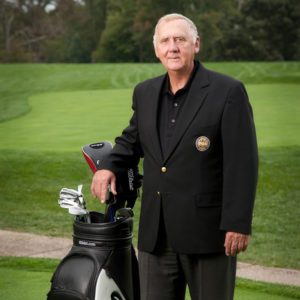
The MAPGA conferred Hall of Fame honors to James Folks for his career-long contributions to the organization’s development as a leading Section in The PGA of America. He either served or chaired the important committees and rose through the officer ranks, reaching the Presidency in 1986. Beginning in 1975, when elected a Regional Vice President, he steadfastly brought innovation and leadership to the MAPGA for over thirty-five years, and will continue to do so in retirement. In the past, the Section honored him with the Horton Smith Award (1981), the Bill Strausbaugh Award three times (1982, 1984 and 1985), Merchandiser of the Year (1986), Professional of the Year (1987), and the prestigious President’s Award (1994).
Originally from Georgia, a family relocation took him to Ocala, Florida, as a young boy. Playing with his father at Ocala Golf Club turned his interest from baseball to the links. Jim quickly picked up the nuances of the game under the tutelage of PGA Professional Lou Bateman. Within a short duration, he captured the Men’s Club Championship twice, the Ocala City Junior Championship three times, the Florida State Junior Jaycee title twice. And, winning the Henry N. Camp Invitational at age twenty highlighted his amateur career up until then.
While attending Central Florida Junior College, the collegiate golf powers, the University of Florida, Florida State and Houston, pursued him with scholarship offers. However, Mississippi State University succeeded in the recruiting battle. He finished his bachelor’s degree there in 1964. Jim turned professional almost immediately, returning to Ocala Golf Course as an assistant to his original teacher and mentor, PGA Professional Lou Bateman.
Following five years in the Florida Section, Jim came to Congressional Country Club in 1968 as the first assistant to Wiffy Cox, a MAPGA Hall of Fame member. However, later that year he sojourned back to Florida for the Winter Tour. But, by the spring of the next year, Jim returned to Maryland as Max Elbin’s assistant at Burning Tree. Three years later, Bethesda CC named him Harry Griesmer’s successor and he began what became thirty-nine years of service to the club and the MAPGA.
From 1975 on, there is a considerable catalogue of contributions and leadership. To begin with, in 1975, 1976 and 1981, Jim served as a Regional Vice President. The Club Relations Committee Chairmanship took up his time between 1981 and 1983. That committee led the way in establishing area employment representatives throughout the Section’s expansive boundaries. Jim focused on compiling a compensation statistical database. He and Bill Strausbaugh, a MAPGA Hall of Fame member, collaborated on developing employment programs for the membership. In fact, subsequently as President, he hired MAPGA Past President and Hall of Famer Carl Rasnic as the Section’s first “Employment Director.”
As an officer of the Association, Jim started out on the path to the Presidency as the Treasurer in 1982 – 1983, Secretary during 1984 – 1985 and then the top spot in 1986 – 1987. While President, Jim led the effort to centralize the handicap program and negotiated the contracts with the Virginia State and Maryland State Golf Associations thereby establishing the continuity of the program. Additionally, he brought to fruition the MAPGA branch office in Richmond attempting to allay the effects of the geographical expanse with all its attendant difficulties.
And in the world of the professional tours, Jim played a major part in bringing the women’s tour stop to Bethesda CC in 1988 and 1989 with the $500,000 Greater Washington Open In 1990 and 1991 it was the Mazda LPGA Championship with the first million dollar purse on the their tour in 1990.
On the competitive side of golf, not only did Jim win Section events, but he also led Bethesda CC to the Maryland State Team Championship in 1977 and 1986, and the Washington Metropolitan Golf Association Team Championship in 2004.
Jim Folks’ contributions to and leadership of the MAPGA over the length of his career established him as one the most important figures in the Association’s history. (rev. 2011)
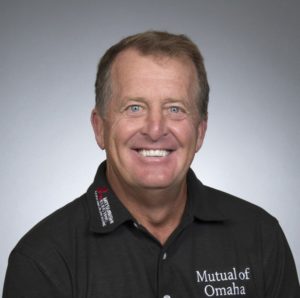
After turning professional in 1981 upon graduation from the University of Maryland, Fred Funk became the golf coach at Maryland from 1982-1988. He was an accomplished player in MAPGA events, winning the MAPGA Professional Championship three years in a row (1987-89), the Maryland Open in 1983 and 1987, and both the MAPGA Assistant Professional Championship and National PGA Assistant Professional Championship in 1984. He won several additional events, including the year-ending MAPGA Tournament of Champions in 1984 and 1988. He was also the MAPGA Player of the Year in 1983.
Funk made it to the PGA TOUR in 1989, playing in 29 events. However, he broke through in 1992 with his first PGA Tour win. In May of that year he captured the Shell Houston Open with a 16-under score for a two-stroke win over Kirk Triplett and winnings of $216,000. In 2005, Funk scored his biggest PGA Tour win when he captured The Players Championship, also becoming its oldest winner at 48 years, 9 months, 14 days. He earned $1.44 million for the win.
In total, Funk has won eight times on the PGA TOUR, and nine times on the PGA Champions Tour, including three Champions Tour Majors (2009 US Senior Open, 2008 & 2010 JELD-WEN Tradition). He represented his country as a member of the USA Ryder Cup team in 2004, and the Presidents Cup in 2003 and 2005.
One of Funk’s lasting legacies with the MAPGA is the scholarship fund in his name. Funk used a portion of his charitable dollars from the 2005 Presidents Cup team to help fund and endow the MAPGA Family Scholarships. The Bill Deck/Fred Funk Family Scholarships annually gives educational funding to children and grandchildren of MAPGA members.
Funk was born in Takoma Park, Md., and earned his PGA membership in 1986. He is married to wife, Sharon, and has three adult children: Eric, Taylor and Perri. He currently resides in Ponta Vedra Beach, Fla.
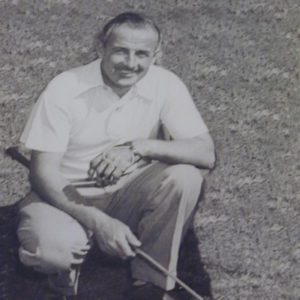
1908–1995. Andy Gibson entered the MAPGA Hall of Fame for his stellar play in the section over a number of decades, including two triumphs in the Section Championship, three Match Play Championships, two Senior Championships and a Maryland Open title. He qualified for ten PGA Championships. Andy trained many young golf professionals and was always talked about as a colorful, charismatic, and gentleman Scot.
After arriving from Prestwick, Scotland, in 1927, Andy turned professional as an assistant to Bill Scott at Baltimore CC. He became the first head PGA Professional at Bonnie View Country Club in 1932. He moved to the Country Club of Maryland in 1943, remaining there until retirement 41 years later. He served the MAPGA as a Vice President twice, elected in 1944 and 1949.
Andy’s first appearance in an MAPGA Championship occurred in the 1931 Assistant Professional Championship, finishing third. As an MAPGA player, his first win took place at the Rolling Road pro-am in 1937. In 1938, he won the Maryland Open at Congressional. His first Section title came in the 1940 Match Play, the first of three.
Andy won the MAPGA Championship in 1944 at Rolling Road by three strokes over John O’Donnell. In the annual meeting afterwards, the membership elected him one of the regional Vice Presidents.
In 1946, he and an amateur at the time, Otto Greiner, tied with Jim Riley and amateur George Gosey form Lynchburg in one of the few times that the section held a pro-scratch championship.
1948 was a particularly good year for Andy. He won the MAPGA Championship at Baltimore CC-Five Farms by a stroke over Ralph Beach and the Baltimore City Match Play Open at Green Spring Valley by besting Charles Bassler in the finals.
In 1951, he earned a spot in the US Open and in 1952, 1953 and 1954 qualified for the PGA Championships in the sectional qualifiers at Woodholme, Country Club of Virginia and Washington Golf. In 1954, he shot 66 to win a pro-am at Fountain Head. In 1955, he, Rick McHale, and Frank Michalek ended the Howard County Open at Allview in a three-way tie. In the playoff, Andy and Frank Michalek tied again with 72s, but Michalek won on the first extra hole. In 1957, at 49 years old, he finished third in the MAPGA Championship at the Cascades, two strokes behind Charles Bassler and Clare Emery. He posted a 67 in the 1958 Bonnie View Pro-Am. Andy qualified for a national event for the last time at Hillendale when he made the 1958 PGA Championship field.
He finished his competitive victories with the MAPGA Senior Championship in 1964 at Manor. He had won that event in 1958, the first year of his eligibility. In 1966, he and his assistant, George Jakovics, lost the Section Pro-Assistant Championship in a playoff to Dick Whetzle and Al Kelley.
Nationally, Andy Gibson qualified for three US Opens: 1940, 1941 and 1951; ten National PGA Championships, and in the 1941 Masters finished in 42nd. In the 1940 US Open at Canterbury, he tied for 20th, gaining his only invitation to the Masters. Andy finished up in national events by competing in six PGA Senior Championships beginning in 1959, when he tied for 26th, and the last time in 1964. The MAPGA named him Professional of the Year in 1969. (rev. 2004)
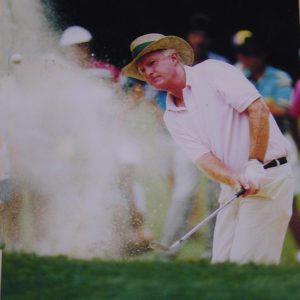
Vinny Giles entered the MAPGA Hall of Fame for not only his stellar amateur play over several decades, but more so for his contributions to the MAPGA and the VSGA. The MAPGA recognized him for contributing to unification of the two Virginia Opens held between 1958 and 1984 into a single Championship. He served on the VSGA Executive Committee for more than twenty years and is a Past VSGA President (1989-1990). Additionally, he held a Director’s position in the Southern Golf Association. They too embraced him as a member of their Hall of Fame. He held a chair on the USGA Mid Amateur Committee and is a member of the Royal and Ancient Golf Club of St. Andrews.
Originally from Lynchburg, he started out in the game playing with his father, an accomplished player in his own right. He won the State Jaycees Tournament as a fourteen-year-old. Vinny finished high school at Episcopal in Alexandria, Virginia and started college at the University of North Carolina at Chapel Hill. After a year he transferred to the University of Georgia from which he graduated in 1966 as a three-time All-America. After a few years in the financial services business, he, his partner, and their company, Pros Incorporated, began managing the financial affairs of many professional golfers.
As one of the most successful amateur golfers in recent decades, his credentials include victories in regional, national and international tournaments. Regionally, he won the Southern Amateur in 1967 and finished 2nd in the U.S. Amateur. The next year found him finishing as low amateur in the Masters. In 1969, he played on both the Walker Cup and World Cup Teams and repeated on the World Cup Team the ensuing year. As the early 1970s opened he continued to play on the World Cup and Walker Cup Teams. One of his personal triumphs came by winning the 1972 U.S. Amateur. In 1973, Vinny won the Porter Cup, played on the Walker Cup Team, captured the Eastern Amateur, and finished the US Open as the low amateur. In 1975, he stayed in England after the Walker Cup matches and won the British Amateur at Hoylake. A second triumph in the Southern Amateur that year followed. The World Team Cup officials named him Captain for 1992 and the U.S. Walker Cup officials named him their Captain for 1993. The 1990 Crump Cup at Pine Valley came his way as well.
The VSGA record book is filled with his accomplishments: twice the VSGA Golfer of the Year (1990, 1993) and once the VSGA Senior Golfer of the Year (2000). Vinny won the VSGA Amateur seven times (1962, 1964, 1966, 1968, 1969, 1971, and 1987) and was the medalist three times (1964, 1989 and 1993). He also won three Virginia Opens (1969, 1974, and 1993) and was the low amateur in the Virginia Open two other times (1972 and 1986).
As a senior, he has won three VSGA Senior Amateurs (2000, 2003 and 2008) and a Middle Atlantic Golf Association Senior Amateur (2004). He scored as the low amateur in the 1993, 1996, and 1997 U.S. Senior Opens. And to date, a career highlight is winning the USGA Senior Amateur in 2009.
In 1976, Vinny was elected to the Virginia Sports Hall of Fame. For contributions to the game as a business consultant to professional golfers, for spectacular play as an amateur, and for contributions to the VSGA and MAPGA he is enshrined in the MAPGA Hall of Fame.
(rev. 2009)
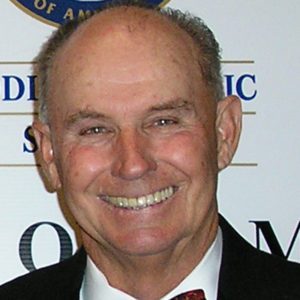
Born January 14, 1938 in Lebanon, Pennsylvania to William J. Haines and Virginia M. Haines, John grew up with sister Kathy (Novak) and brothers Richard (now deceased) and William in a typical small town. William and Virginia worked hard to raise their four children.
John’s Uncle Bill introduced him to the game of golf when John was eleven years old. They played in Uncle Bill’s backyard. John fell in love with the game and knew, by the age of 13, that he wanted to be a PGA Professional. Head PGA Professional Harlan Will at the Lebanon Country Club in Lebanon, Pennsylvania was an early role model. Not only did John caddie at the Lebanon Country Club he also owned and operated The Caddie Shack where he sold sandwiches and snacks to the other caddies!
John played on his high school’s golf team and was the caddie champ at Lebanon Country Club. He is a 1955 graduate of Lebanon High School in Lebanon, Pennsylvania. From 1955 to 1958, John served in the US Navy at Long Beach, California and achieved the rank of Gunners Mate 2nd Class. While serving, he played on the US Navy golf team and played in all Navy Championships during his enlistment.
After beginning his golf career in 1959 as an assistant at Andrews Air Force Base, Maryland under head PGA Professional George Pigott, John was elected to PGA membership in 1963. He worked ten years as the head PGA Professional at Goose Creek Golf Club in Leesburg, Virginia; sixteen years as the head PGA Professional, director of golf, and general manager at Hunt Valley Golf Club in Hunt Valley, Maryland; and two years as director of golf at Greystone Golf Course in White Hall, Maryland before moving to Wyoming. After ten years as the director of golf and head PGA Professional at Teton Pines Resort and Country Club in Jackson, Wyoming John retired to Hobe Sound, Florida in 2002.
In his over 40 years of service to The PGA of America, John served as a member of the MAPGA Board of Directors in various capacities for twenty consecutive years (1969-1988), including service as treasurer, secretary, and president from 1980-1985. He served as a member of the PGA Rules Committee for over twenty years (1982-2002). John served on the following PGA Committees: Education, Special Awards, Merchandiser of the Year Selection, and Public Relations and Communications. John also served on the PGA Board of Directors as the District 9 Director (2000-2002) representing the Rocky Mountain, Colorado, and Utah Sections and as a member of the PGA Properties Board of Directors.
John’s outstanding contributions to the Association have been recognized with the following awards: the 1979 MAPGA Bill Strausbaugh Award, the 1982 MAPGA Horton Smith Trophy, the 1989 MAPGA President’s Award, and the Rocky Mountain Section’s 1994, 1995, 1996, 2000, and 2001 Merchandiser of the Year (Resort) Award. In 1985, he was recognized with the Middle Atlantic Section’s highest honor to active members when he was selected as the PGA Professional of the Year.
John is a member of the Kiwanis and Optimist Clubs. He volunteers at Camp Greentop, a camp for disabled children, and with the Fellowship of Christian Athletes. (rev. 2004)
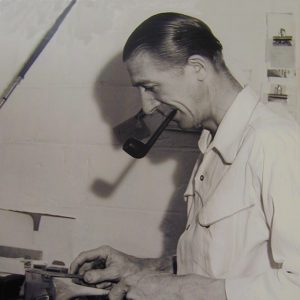
1905-1995. Bill Hardy entered the MAPGA Hall of Fame for his contributions as one of the game’s pioneers in club-making. In a career that spanned sixty-five years, his many credits include inventing one of the first swing weight scales, utilizing maple tees instead of screws to secure inserts on the wood heads and using fiberloid to cap off the grip and the top of the whipping. Bill concentrated on matched sets of persimmon woods with stain to show the grain, the club decal, and a stamped identification number. He maintained a list of each club owner’s specifications. Spalding once had him spend three days at their factory as a consultant. One of his clubs sits on display at Golf House, the headquarters of the U.S. Golf Association.
Bill was born in Baltimore, but the family moved to the Washington area around 1920. He started working at East Potomac Park GC in 1922, and then moved over to the Rock Creek course for the 1923 and 1924 season. As a nineteen year old, Bill became a golf professional and club maker for the Chevy Chase Club in May 1924, where he made clubs and served as a golf professional until 1973 (earning his PGA membership in 1937). However, he continued turning out clubs until 1989.
Sometime during the 1920s he installed heads and grips on the first steel shafts for inventor Alan Lard’s “whistlers,” wherein a metal piece wrapped inside the steel shaft created an air pocket which made a sound when swung. Lard was a member at the Chevy Chase Club. During the 1928 PGA Championship at Baltimore CC-Five Farms, Leo Diegel, the eventual winner, needed a hickory shaft driver and brassie in a hurry. Bill turned them out and delivered them to Diegel on the 10th tee during one of his matches. Later, in an act of appreciation, Leo sent Bill a set of ruby cuff links from Tiffany’s. He corresponded often with other famous club makers, notably Kenneth Smith based in St. Louis. In 65 years of practicing his trade, he made clubs for touring professionals, including Horton Smith, Bobby Cruickshank and Deane Beman, as well as celebrities, senators, diplomatic corps members, and hundreds of devoted club members.
In 1950, Chevy Chase appointed Bill and Ward Burgess co-head Professionals in the days following Robert Barnett’s death. After a few years of doing “double duty,” Bill returned to the primary task of club making.
Bill Hardy became nationally recognized and a frequent lecturer on the art of club making. He presented at the first PGA Business School in 1957. The MAPGA honored him with the 1974 MAPGA Horton Smith Award and he was subsequently selected as the National Horton Smith Trophy winner. In 1983, the Golf Collector’s Society honored him for his contributions to the game. Posthumously, in 2003, the Professional Clubmakers’ Society inducted Bill into their Clubmakers’ Hall of Fame for his lifetime of achievements. (rev. 2004)
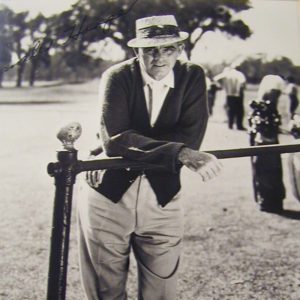
1914-2004. Chandler Harper starred on the regional, national and international golf stage throughout four decades. A teenager when 1930 dawned, he had already captured the Portsmouth City crown twice. Chandler emerged as Virginia’s youngest golf prodigy when he won the Virginia State Amateur in 1930 as a sixteen-year-old.
He learned the game by studying magazine pictures of Bobby Jones, his boyhood idol, and by watching the Hollywood film series by Jones shot in the early 1930s entitled “How I Play Golf.” Chandler Harper crossed paths with Bobby Jones at Winged Foot in 1929, site of the US Open, and asked for chipping advice, which the young amateur star provided.
In 1932, Chandler won the first of six Virginia State Open titles while still an amateur. In 1933 and 1934, he captured back-to-back VSGA Amateur Championships and the Tidewater Opens in 1933-1935 and 1937. As a nineteen year old he played an exhibition at Norfolk CC, now Sewell’s Point, with Walter Hagen. He turned professional in 1934.
Chandler Harper played the Winter Tour starting in 1937 by picking up with either the Tucson or Phoenix Open and then playing across the Southern U.S. and finishing at the Masters or the North and South Open. When he finished the PGA Tour in 1955 he had won seven titles. His first paycheck came at the 1938 San Francisco Open, $50 dollars for tenth place. The Tour moved on to New Orleans the next week where a 5th place rewarded $500. At St. Petersburg, he tied for first with Johnny Revolta, but lost the playoff. The breakthrough to the winner’s circle came at the Miami Biltmore Four-Ball with Herman Keiser in 1942. He notched PGA Tour victories at Tucson, El Paso, Virginia Beach, the Texas Open and the Colonial and the PGA Championship at Scioto in 1950. He won the Texas Open in 1954 by shooting 70 (39-31), 63, 63 and 63.
Regionally, Chandler won the MAPGA Championship in 1954 at Cavalier in a playoff over Ralph Beach. As professional, he won his first, but second overall, Virginia State Open in 1938, and again with back-to-back wins in 1940 and 1941. Immediately after World War II he lost a playoff to Sam Snead in the 1946 VSGA Open, but won in 1952 and in 1968 in a playoff over Bill Calfee. In the years when the Virginia Association of Golf Professionals held the Virginia PGA Open, 1958-1984, Chandler won in 1960 and then four consecutive titles beginning in 1967. Nationally, Chandler played in 11 US Opens between 1935 and 1955. A tie for 15th in 1946 highlighted his US Open career. Between 1941 and 1971, he qualified for 19 PGA Championships, fourteen at match play. For his championship title, he defeated Lloyd Mangrum and Jimmy Demaret in the run. His PGA credentials include the 1955 Ryder Cup Team membership. At Augusta, he appeared in two Masters prior to World War II, and then continuously from 1946 through 1955.
As a senior, he played in fifteen PGA Senior Championships, winning in 1968 by four over Sam Snead with a third round 64. That title allowed him to play the World Seniors Championship against England’s Max Faulkner during the summer. In what turned out to be a decisive hole near the end of the match he covered Faulkner’s birdie on a par five with an eagle. He also won the Los Angeles Senior Open.
The PGA Hall of Fame inducted him in 1969 and the Virginia Sports Hall of Fame in 1973. (rev. 2005)

Paul Haviland earned Middle Atlantic PGA Hall of Fame honors for his stellar playing career over two decades, the 1950s and 1960s. He also served on the MAPGA Board of Directors holding the Tournament Committee Chair position in 1968 and 1969. As a player Paul won numerous MAPGA Section tournaments, competed in two PGA Championships, two US Opens, two Senior PGA Championships and won a prestigious regional open. He played in five PGA Tour Eastern Opens, making the cut each time.
During his youthful days Paul taught himself the game at Baltimore CC’s Five Farms course where his father held the superintendent’s position. As a twenty year old he won the 1950 Maryland State Amateur Championship at Five Farms. Additionally, Paul qualified for the US Amateur in 1950 and 1955.
He spent fours years in the United States Navy, 1951 – 1955, with two years at Bainbridge Naval Training Center in Port Deposit, Maryland, and then two years aboard the aircraft carrier, USS Hornet. In 1952, Paul won the Fifth Naval District Championship at Sewell’s Point in Norfolk.
All View’s Head PGA Professional Johnny Musser introduced Paul to Harold “Shorty” Oatman in September 1955 which led to a professional position at Oatman’s Norfolk Naval Base Golf Club during 1956. At season’s end he returned to Baltimore where upon he held an Assistant Professional position to Johnny Bass for four years (two at Clifton Park Golf Club and two at Pine Ridge Golf Club). In 1961, Paul accepted the Head PGA Professional position at the newly developed Maryland Golf and CC where he remained for thirty-five years.
Once his professional career got underway, Paul finished tied for second, a stroke back, in the 1957 Maryland Open. His first triumph in MAPGA tournaments took place at the 1958 East Potomac Pro-Am. His first really good year came in 1960 when he made it through local qualifying for the US Open, made the cut at the Eastern Open, won a MAPGA Pro-Pro at Sherwood Forest with Eddie Graefe, won the Quantico Pro-Am, and most importantly, captured two MAPGA Section events. First, Paul won the Assistant Professional Championship. Then he captured the Baltimore City Open (the Section Match Play Championship) when he defeated then five-time champion Walter Romans in the finals. Paul had previously made the semifinals in 1957 and 1958.
Paul played his way to MAPGA “Player of the Year” honors in 1964 by qualifying for the PGA Championship (finishing tied for 33rd), qualifying for the US Open, winning the Maryland Open by overcoming Lou Graham in the final round, taking a regional open title at the Salisbury Open, and winning the first edition of the MAPGA Pro-Assistant Championship with Paul Quinn.
In 1966, Paul won the MAPGA Section Championship and qualified for the PGA Championship for a second time. Later, he and Paul Quinn won the Pro-Assistant title twice more, 1968 and 1969. He qualified for another US Open in 1965. Paul and number of his members won several Pro-President and Pro-Official titles: a Pro-President in 1966; and Pro-Official titles in 1968, 1969, 1971 and 1972.
His career is also marked by a number of other outstanding accomplishments. In the Hot Springs Pro-Am Paul shot 68 at the Cascades and then 69 at the Lower Cascades course the next day to win making a bogey on the first hole the first day and then none after that. He shot 64 at Fort Meade with nine birdies and a bogey. In 1967, Paul’s 66 at the Rolling Road Pro-Am put him clear by five shots.
He played in the 1982 and 1983 PGA Senior Championships. Paul’s last Section title was the 1983 MAPGA Senior Championship. Also in 1983, he earned the Tom Strange Memorial Trophy when his peers deemed him the “most valuable player” in the Yamaha Cup Matches, a competition against the Philadelphia PGA Section professionals. (rev. 2011)
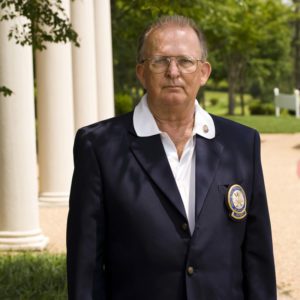
The MAPGA placed Frank Herrelko into their Hall of Fame for his career-long dedication and service to the Middle Atlantic PGA, The PGA of America and golf in the commonwealth of Virginia. Within the ranks of the MAPGA, the Southern Chapter elected him President in 1984 – 1985. He has held membership on the Rules Committee since 1976, and Co-Chaired the Tournament Committee in 1992 while serving on that body for 40 years, 1966 – 2006. Furthermore, Frank chaired the MAPGA Section Championship Committee four times. To this day, he remains the Section’s Parliamentarian for the annual meetings and has done so since 1991.
Frank has led as a Co-Chair the State Open of Virginia Committee for the past eleven years. He also chaired the Virginia PGA Open Championship Committee between 1976 and 1980 and again in 1984. He was a founding donor of the Virginia State Golf Association’s Independence Golf Club. In 2007, he received the VSGA’s President’s Award for thirty-five years of exceptional and noteworthy service. Not one to retire on any laurel, he almost single-handily brought the Senior Open of Virginia into existence. Additionally, he is a member of the Dewar’s Hall of Fame for Virginia Golf Professionals, inducted in 1985.
The MAPGA previously recognized his commitment and contributions with the 1986 Professional of the Year Award, the highest award presented by the association to an active PGA Professional; the 1988 Horton Smith Award for his work in education; and the 1993 President’s Award for outstanding, dedicated and selfless service. His service to The PGA of America included the Junior Golf Committee in 1984 and 1985, and the Boundaries and Education Committee in 1990. Frank taught for the PGA Business Schools I and II in 1988. He also attended numerous PGA Annual Meetings as an alternate delegate. He and Ken Lindsay authored “A Summary of the Rules of Golf,” a PGA publication. Not unexpectedly, he attended the first PGAUSGA rules workshop (1975), the first Teaching and Coaching Summit (1988) and the Advanced Rules Workshop (1990).
Frank Herrelko, an Eagle Scout, began playing golf as a fourteen year-old at Fort Meade. Fortunately, the Head Professional Steve Tobash, PGA, switched him from left-handed to the right side of the ball after his opening 144. From then on his prowess rapidly improved so much that he played on the 1964 ACC Championship team at the University of Maryland.
His professional career began with working, but mainly teaching classes, under MAPGA Hall of Fame member Frank Cronin, PGA, at the University of Maryland. Frank followed that with an Assistant Professional position at Fort Meade (1966) and then Bonnie View (1967) under the tutelage of MAPGA Hall of Fame member Carl Rasnic, PGA, and Cosimo Tiso, PGA, respectively. In 1972 he accepted the Head PGA Professional assignment at Salisbury Country Club, remaining until his retirement in 1991. He is currently an honorary member at Salisbury Country Club.
Amongst ranks of the Section’s players, Frank Herrelko won the 1996 Senior Stableford Championship and with Herb Hooper, PGA, the Southern Chapter Pro-Pro in 1980. He finished third in the MAPGA Championship in 1971. Nationally, Frank teed it up in four National PGA Club professional Championships: 1973, 1976, 1977 and 1979; and in the 1996 National Senior PGA Club Professional Championship. He won more than a dozen pro-ams in his distinguished career.
As a teacher, Frank estimates that he taught more than 10,000 lessons. Several of his junior golfers went on to receive golf scholarships. For career-long distinguished service to the MAPGA, Frank Herrelko entered their Hall of Fame, all the while married to the former Ann Murdoch of College Park, Md. (rev. 2009)
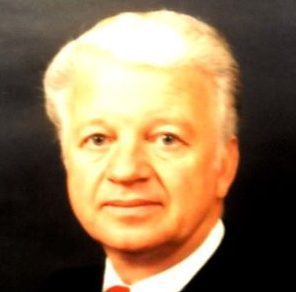
Big Lick Golf, Roanoke, Virginia
Hall of Fame Class of 2012
Wayne Holley’s contributions to the MAPGA are held in such high regard that they bestowed him Hall of Fame recognition. First, as an officer in the Virginia Chapter, then followed by an ascendancy to MAPGA Presidency is the hallmark of his career. Furthermore, once his presidential terms ended, he has remained an integral member of the Board of Control and steadfastly supports the organization.
His golf career began as a 12 year-old caddy. He continued during high school, but also supervised the club storage facility and ultimately became the caddie master at Hidden Valley. After high school graduation in 1961, Wayne turned professional as the Assistant Professional to Clyde Johnson, Head PGA Professional at Hidden Valley Country Club.
In 1963, his break of a lifetime came by accepting an Assistant Professional position to PGA of America and MAPGA Hall of Fame member, Max Elbin, at the Burning Tree Club. Three years later, he had earned his PGA membership but more importantly became the Head PGA Professional at Roanoke Country Club, where he remained for 25 years, until 1991.
“Any success that I have had and have now, I attribute to three things: Max, Max and Max. He is quoted saying that taught him the importance of maintaining a professional attitude concerning every aspect of my life’s and to always do my best. This has become my life philosophy. My golf philosophy centers on the basic fundamentals of golf. As in golf or life, without the basic fundamentals, we cannot reach our potential.
In 1991, a vision of developing, maintaining and opening a facility that would allow the public access to learning swing techniques and etiquette from a PGA Professional through private lessons and clinics provided a new focus for his career. Subsequently the BIG LICK GOLF Learning Center and Driving Range opened in 1993.During the course of his career MAPGA colleagues awarded him numerous awards, notably the Section’s highest honor, Professional of the Year, in 1993. However, he also received the Bill Strausbaugh Award for Employment efforts in 1981 and the Horton Smith Award for Education in 1984.
Wayne has also been recognized through his selection into two other Halls of Fame, both in 1990. Induction into the Roanoke Valley Golf Hall of Fame and the Dewars Hall of Fame for Virginia Golf Professionals came that year.
Wayne is proud of quite a few success stories over the years. In 1974, he succeeded in establishing the Roanoke Valley Golf Hall of Fame, along with amateur Walter S. “Buddy” Clement. This project unified eight Roanoke Valley golf clubs through the planning and coordination of an annual golf tournament, including divisions for men, women, juniors and seniors.
He also directed and was primarily responsible for the establishment and organization of the Scott Robertson Memorial Junior Golf Tournament. This event began in 1984 as a state event and has grown into a national tournament enjoyed by over 160 of the nation’s top junior golfers.
During his Presidency, Wayne was heavily involved in the daily operations of the Section. He was instrumental in the growth of the Section’s Handicap program by supporting, promoting and overseeing the administrative development and growth of the cooperative handicap service program between the MAPGA and the state golf associations of both Virginia and Maryland. Since its inception in 1986, the program has experienced uninterrupted success.
As recognized by his 1981 Strausbaugh Award, Wayne worked diligently to improve the employment arena for PGA professionals in the Roanoke Valley and western part of the state. He often negotiated contracts between PGA members and their golf clubs.
Wayne has been married to his wife, Barbara, for more than fifty years. The only time they lived outside of the Commonwealth of Virginia was in Bethesda, Maryland, when Wayne was at Burning Tree Club. They have three children: Brad, Chad and Pam; and eight grandchildren: Candace, Bradley, Megan, Marissa, Jesse, Chandler, Garrett and Ann Carole.

1903-1982. Al Houghton entered the MAPGA Hall of Fame for his untiring work as section President who also held National PGA office. Known as the “Silver Fox” and “The Senator,” the monikers were bestowed because he promoted golf in this area as no one ever has. Al Houghton and Sidney Banks dramatically upgraded the purses and status of the MAPGA Championships in 1937 when they hosted the event at Chamberlin Golf Club and changed it to seventy-two-holes of stroke play. As a golf promoter, he organized the National Capital Open at Kenwood in 1931-1934 as PGA Tour stops. Al revitalized the regional open following World War II at Prince George’s CC. He assisted in the development of the National Celebrities Open in the late 1940s and early 1950s. He is also given credit for developing the National Women’s Open.
Born near Glen Echo, Maryland, in 1903, Al began his golf career as a caddie as Bannockburn in 1914. President Wilson selected 10-year-old Al to be his caddie. Army service took place during World War I.
His superb amateur career is evidenced by winning the District of Columbia Public Links Championship in 1925 and reaching the semi-finals of the national event. He may be the only player to compete in the four national events of his generation: the USGA Public Links Championship, the US Amateur, the US Open, and the PGA Championship.
Professionally, he began as an assistant at Bannockburn in 1927. His first head PGA Professional position came at Harper Country Club (1928-1931), then Kenwood (1931-1936), Cavalier Country Club (1936-1940), and Beaver Dam (Prince George’s CC) (1940-1968).
Four Maryland Open titles highlighted his career: 1932 at Columbia, 1933 at Baltimore CC-Five Farms, 1934 at Indian Spring and 1936 at Manor. He also won the 1940 District of Columbia Open at Congressional. In regional events, he won at Bedford Springs three times: 1933, 1939, and 1940, and the Mid-South Open and the Tidewater PGA Open in 1936. In April 1934, Al scored 9 birdies and no bogeys for a career and course record 61 at Washington Golf and CC.
Nationally, Al played in five PGA Championships. In 1933, he lost to Paul Runyan in the first round, but followed that with a quarterfinal appearance in 1934, but a loss to Denny Shute ended his PGA appearances. He played in six U.S. Opens, making the cut three times with a tie for 40th in 1932 his highest finish.
The MAPGA membership elected him President for the first time in 1950, and then re-elected him through 1956, and again in 1965. The MAPGA membership sent him to eleven national meetings as their delegate.
At the National PGA level, he held a regional Vice Presidency for three years. Al chaired the PGA Ways and Means Committee, the Insurance Committee, the Manufacturer’s Relations Committee and the Jurisprudence Committee. In 1952, in a proposal that was ahead of its time, he laid out a PGA equipment program that would fund pensions for PGA professionals.
In local civic circles, Al sat on the Chamber of Commerce, and presided over the Optimist Club and the Riverdale Civic Association. In 1959 Governor Tawes honored him with the Distinguished Citizen of Maryland Award.
The Maryland Athletic Hall of Fame inducted him in 1969. (rev. 2004)

1954-2017
Dean was introduced to the game by his father, Lawrence Hurst, who had become a PGA Professional following a 22-year career as an aviator in the U.S. Navy. Larry Hurst was a great amateur player during his military career, capturing second place in the Virginia State Amateur in 1955. His military career took his wife, Joyce, and their three children, Terry, Dean, and Georgia (Peck) to Guam, Hawaii, Georgia, Florida, New York, and Virginia Beach … and his love for the game of golf led him to frequently take his family to the golf course. Both Dean and his older brother, Terry, developed a passion for the game, and both followed in their father’s footsteps to careers in golf and PGA membership. Terry was the long-time Head PGA Professional at the Country Club of Scranton in Pennsylvania from 1980-2015.
In high school and in college, Dean was an accomplished amateur player, qualifying for regional and state championships. While pursuing a degree in Political Science at the University of South Florida, Dean worked summers for his father at Lago Mar Country Club in Fort Lauderdale, where, in 1977, he also obtained his first job as an assistant professional. In 1978, he accepted an assistant position at Cavalier Golf and Yacht Club in Virginia Beach, Virginia working under the watchful eye of local legend, (and brother Terry’s good friend) Butch Liebler. In 1980, Dean was elected to membership in the PGA and was selected for his first Head PGA Professional job at Duck Woods Country Club in Kitty Hawk, North Carolina where he remained for the next 15 years. In 1995, he moved back to Virginia Beach with his wife Denise, and son Drew, to accept the position as Head PGA Professional at Bayville Golf Club. Denise assisted Dean with merchandise buying decisions throughout his career. Their son Drew, grew up in pro shops and is a very good player himself.
Dean conducted numerous charity golf events in addition to hosting championships for the MAPGA and the Virginia State Golf Association. His goal each day was to provide the highest level of service to the members and guests of Bayville Golf Club and to seek to improve golf operations through innovation, training, and motivation of his staff. He also found the time to be actively involved in the Southern Chapter and the Middle Atlantic Section. Dean served all the offices of the Southern Chapter and the Section, culminating with his term as Middle Atlantic PGA President in 2010-11. Dean was honored in 2001 with the MAPGA’s Bill Strausbaugh Award, in 2003 with the Section’s Horton Smith Award, and 2007 with its highest active honor, MAPGA Professional of the Year.
As an officer of the MAPGA, Dean’s genuine personality, approachability and fun-loving spirit caused him to be a popular figure with peers, national leaders and industry personnel. This allowed the MAPGA to lead and be involved in several areas. One of the greatest compliments about Dean was that when he was speaking to you, you felt like you were the only person in the room.
Dean was also the driving force, along with T.J. Young (then of Cedar Point Club, now the Head Professional at Bayville), behind the MAPGA’s efforts to develop mentoring programs in the Chapters. His and T.J.’s “cracker barrel” sessions provided the time and opportunity, to those relatively new to the golf industry, to ask questions on everything from tips on getting that first head professional job to ways of handling difficult customers. In addition, these “cracker barrels” (now called Town Hall Meetings) fostered an atmosphere of camaraderie among the participants. Dean’s goal was to improve communication and fellowship among PGA Professionals in order to improve performance and increase the PGA Professional’s value to employers. This program is one of his legacies, as it spread to all parts of the Section. His hope was that the program would be self-perpetuating, with those being mentored today becoming the mentors of the future.
Another hyper-local program that Dean started was an end-of-season Pro-Assistant event at Bayville. He would invite eight or ten local facilities to bring their Head Professional and one Assistant to Bayville for two-day, 54-hole event (with a social event at Chick’s Oyster Bar, Dean’s favorite watering hole) in November. There was a competition, but it was mostly about decompressing from a long season, sharing ideas, and building camaraderie.
As Chair of the Employment and Club Relations Committee, Dean initiated an MAPGA Career Coaches program. The term Coach was chosen to emphasize the Section’s rich history with Coach Bill Strausbaugh. The Committee divided the Section into eight geographic areas and identified three or four experienced individuals in each region who volunteered to travel to facilities to visit PGA Professionals to discuss concerns and interests about a variety of topics, but primarily centered on employment issues.
Dean’s commitment to his fellow PGA members was unmatched. In ways big and small, he looked out for his peers, helped those new to the industry, and guided his staff up and onward to new positions. He was a humble man, a servant leader, and pushed credit off to others. But his impact on the MAPGA, and specifically his fellow members, was immense.
When asked to what he attributed his success, Dean responded, “I was fortunate to have the opportunity to learn the golf business from three great PGA Professionals: my father, my brother, and Butch Liebler. All three set the highest of standards toward providing the appropriate level of service to members and promoting golf. I have simply applied what I learned from them and tried to improve my own abilities through education and innovation. It is easy to go to work every day when you love your job. I am very proud to be a PGA Professional and remain dedicated to assisting others considering a career in golf.”
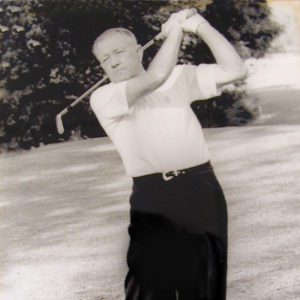
1908-1982. Jack Isaacs’ playing career included success at the regional and national levels, and for that and his leadership in the Virginia Association of Golf Professionals (VAGP), he was inducted into the MAPGA Hall of Fame. As early as 1939, he served as a VAGP Vice President. Between 1951 and 1954, he held the Presidency. The VAGP saved the Virginia State Open from collapse in 1934, when he, Bobby Cruickshank, Chandler Harper and others formed that organization. The VAGP, and subsequently as the MAPGA Virginia Chapter, conducted a separate Virginia PGA Open until 1984. Jack held a MAPGA Regional Vice Presidency in 1950 – 1951.
Jack, a Richmond native, started as a caddie at the Country Club of Virginia. While there he looped for Walter Hagen in an exhibition with Joe Kirkwood in 1922. In 1928, he accepted the head PGA Professional position at Laurel Golf Club and in November 1929, moved to the Chesterfield Golf Club. Five years later, Jack relocated to the Old Dominion Club. Then in 1938, he accepted the Head PGA Professional position at Langley Air Force Base and remained there until 1963. He semi-retired to Tequesta CC in Florida, but then returned to Willow Oaks in 1965 before a final retirement in 1969. While at Langley, he served a four-year tour of duty with the Army Air Corps during World War II.
His earliest success as a player came when he shot 64 at Glenwood in the Public Links qualifier in 1928. Nationally, Jack played in eight U.S. Opens, qualified for 13 PGA Championships, appeared in two Masters, and also qualified for three British Opens. As a senior golfer he played in 16 PGA Senior Championships and won the PGA Quarter Century Championship in 1965 and 1966. His highest finish in the U.S. Open occurred in 1949 at Medinah, finishing tied for 23rd. In PGA Championships his greatest successes occurred in 1952 and 1953. In 1952, Jack knocked out Pat Abbott and Marty Furgol before losing to Clarence Doser. The next year, he ousted Chandler Harper, Fred Haas Jr., Labron Harris, and Henry Ransom to reach the semifinals where he lost to Felix Torza in 39 holes. At stroke play he finished tied for 49th in 1958 after turning 50 years old. PGA Senior Championships brought four top ten finishes with a fourth in 1963. In two Masters Championships, Jack finished with ties for 44th in 1950 and 53rd in 1954.
Regionally, Jack bested the MAPGA Section Championship field in 1941 and many years later he won the South Florida PGA Section Championship. He won the Virginia PGA Open five times: 1949, 1950, 1956, 1958 and 1961. In 1949 at Ocean View Jack opened with a 65. He captured the Maryland Open three times: 1949, 1951, and 1952. Once Jack turned fifty, the MAPGA Senior Championship came his way in 1959 at the Homestead; repeating in 1960 at Princess Anne, and for the last time at Prince George’s CC in 1961. At 59 years of age the MAPGA tapped him to play in the inaugural Schmidt Cup matches between themselves and the Philadelphia PGA Section in 1967.
Locally, he won the 1958 Howard County Open at All View. Also in 1958, he captured the Atlantic City Senior Open.
Two of his rounds are famous in this part of the country. In 1940, at the U.S. Open qualifier at Manor he opened with a 74, relegating him to sixth place when only five slots would be awarded at the conclusion of the afternoon round. In spectacular fashion, he carved out seven birdies and two bogeys for a 65 securing his place in the U.S. Open with a course record. Ten years later, in the Maryland Open at Columbia, he scored 66 from the back tees with five birdies and bogey. To date, that feat has only been done four other times on the course that dates back to 1911. (rev. 2011)
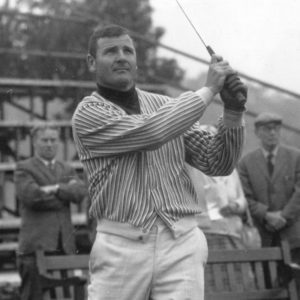
Claude Keith King gained MAPGA Hall of Fame recognition for his outstanding play in the section during the 1960s and early 1970s and on the PGA Tour during the first half of the 1960s. He won MAPGA Championships in 1967 and in 1971. In 1971 Claude King earned the MAPGA “Player of the Year” title. He captured the Virginia PGA Open title in 1971 and the Virginia State Golf Association Open in three consecutive years, 1961 – 1963. Claude represented the MAPGA in their annual Schmidt Cup matches with the Philadelphia section five times, 1967 – 1971. In 1970 his Schmidt Cup teammates voted him the Tom Strange Memorial Sportsmanship Trophy. He also won the Salisbury Open in 1970. The 1976 Middle Atlantic Open trophy is his as well. In 1967 he took the PGA National Winter Series Medal Play Championship. In PGA Club Professional Championships he competed six times, making three cuts and finishing tied for 17th in 1969. Claude played in three PGA Championships: 1968, 1970 and 1972. He also played in three US Opens: 1962, 1964 and 1966, finishing 57th in 1966.
Claude King toured on the PGA circuit beginning in 1962 and continued into the fall of 1966. Overall, his career included 96 PGA Tour events, making 80 cuts, with eight top-10 finishes and twenty finishes in the top-25. In 1963 Claude finished 10th in the 500 Festival at Indianapolis and in 1964 he finished 5th in the Sunset – Camelis Open. His best year on Tour occurred in 1965 when he finished 7th in the Houston Open and 8th at the Carling World Open leading to 54th place on the money list. In a practice round at Lafayette, La., one year he shot 60 (-12) at the Oakbourne CC.
Claude Keith King was born in Wilmington, North Carolina, in 1932. At New Hanover High School he lettered three years in football, baseball and golf. In 1951 he opted for a football scholarship to East Carolina College rather than signing with the Baltimore Orioles or Brooklyn Dodgers. He started in the backfield, handled all of the kicking duties, and, at 6’1″ and 190 pounds, was recognized as the North State Conference’s top fullback in 1953 and 1954.
Claude was named to the Little All-America team in 1954. He also played on the college’s baseball and golf teams. While hitting golf balls at a local driving range with the rest of the baseball team the ECC Golf Coach came over to encourage Claude to give his golf team a try. As a sophomore, he fell in love with golf and began an extremely rigid practice schedule. Claude won conference golf titles in 1954 and 1955.
After graduating in 1955, the NFL teams called his number, but he decided on an education career. Virginia Beach High School hired him to teach English and Physical Education and to coach on the football, baseball and golf teams. As an amateur, Claude won the Norfolk City Amateur Golf Championship in 1958. He lost in a playoff to Jack Isaacs in the 1961 Virginia PGA Open in his last major tournament as an amateur.
In 1961 Claude King made the decision to try out the PGA Tour. After four successful years, he attended the 1966 PGA Business School, and then with ankle and wrist injuries disrupting his tour schedule, he returned to Virginia Beach as the Head Professional at the newly developed Lake Wright Golf Course. Claude King remained there until retiring in 1996. (rev. 2006)
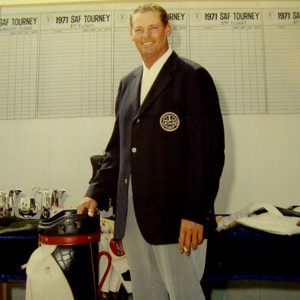
1922-1972. Fred B. King served Middle Atlantic PGA and the U.S. Air Force with great distinction. In the MAPGA his reputation as a teacher and charity fundraiser won him respect throughout the golf community.
Originally from Lafayette, Louisiana, Fred played many sports, but could swim particularly well. As a swimmer and diver, he finished first in the 1939 AAU Louisiana District Swim Meet for “Men’s Fancy Diving” and third in the 100-yard breast stroke. Fred’s golf career golf began as a caddie at the Lafayette City Golf Course with the Herbert brothers, Jay and Lionel. He enrolled at the University of Southwest Louisiana on a football scholarship, but during World War II enlisted in the Army Air Corps. While in flight training, doctors diagnosed “discoid lupus erythematosus.” The illness did not stop him, however, from completing the training and serving the country for twenty years. As an Air Corps pilot, he flew in British Guiana, Puerto Rico, Korea, Guam, and Japan. He retired his wings in 1963.
In 1962, the Air Force awarded him the Airman’s Medal. The citation reads “distinguished himself by heroism involving risk of life in the Intracoastal Waterway…upon seeing a youth struggling in the water…immediately dove into the water to help him…succeeded in getting the victim into a boat…and then revived the unconscious boy.”
Upon leaving the military Fred King accepted the head professional position at North Augusta Country Club in 1964. In 1968, he came to Washington, D.C. to run the Air Force’s premier golf complex at Andrews Air Force Base where he presided for twenty years. Even in retirement he couldn’t stay away. He worked as a teaching professional at his son’s Lakeview Golf Club in South Carolina for several years.
Immediately after arriving at Andrews Air Force Base, Fred began running an annual one-hour-per-week golf clinic for children at no charge. Fred and his assistants spent one day a week working with children on the fundamentals throughout July and August. By the mid 1970s, more than 100 kids would participate each summer. He also maintained a golf academy for the military personnel’s children and was a keen supporter of ladies’ day at the club.
Within the MAPGA Fred held the Secretary’s position and served on the Club Relations Committee in 1973 and 1974. In 1982, his peers recognized him as the MAPGA Professional of the Year and oftentimes referred to him as one of the region’s greatest ambassadors for The PGA and the game of golf. All the while, he maintained his game well enough to compete in PGA Club Professional Championships.
His outgoing personality, sense of humor, and genuine interest in people were rewarded by an outpouring of response when he hosted charity events. It was widely known that Fred would seldom turn down a public speaking date for civic clubs or charity and golf groups where he regaled them with his humorous stories in his Louisiana Cajun dialect.
Fred King founded the Lupus Foundation Tournament in the late 1970s where the yearly contribution reached nearly $15,000. The tournament has raised $200,000 by the mid 1980s for research to cure the anti-immune disease. He conceived, and in 1979 established, the annual clinic and tournament for residents of the U.S. Soldiers and Airmen’s Home in Washington D.C. This event continues to this day through the efforts of Quin Sullivan, head PGA Professional at Springfield Golf and Country Club. (rev. 2004)
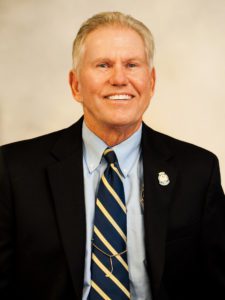
The Middle Atlantic PGA is proud to announce its newest selectee for the MAPGA Hall of Fame, Master Professional Frank Laber. Frank epitomizes the ideals of sportsmanship, ethical behavior, and the mission of the MAPGA. His enthusiastic spirit, loyalty, and selfless service toward promoting the game of golf and the PGA professional are extraordinary and undisputed.
Born in Baltimore, MD, in 1947, the only child of Frank and Eleanor Laber, Frank is well known and respected in the Baltimore/Washington area where he has spent his entire life. He began playing golf as a youngster and was a fixture at Clifton Park GC and Mt. Pleasant GC. Later, he and his mentor and best friend for almost 60 years, Coleman Plecker, could often be found playing golf at Carroll Park GC. In keeping with the true “Baltimore son” that he is, Frank attended the University of Baltimore.
This four-time recipient of the Section’s Bill Strausbaugh Award (1988, ‘90, ‘91, ‘95) dedicated his career to improving the financial stability of the golf professional. Recognizing a need for employment support for MAPGA professionals, Frank played a proactive role in establishing the position of The PGA of America’s first Section Employment Director in 1990. The creation of this position within the Middle Atlantic Section was the foundation for career services being offered in the Section today. Frank’s initiative to establish the position of Employment Director on the Section level subsequently evolved into a National effort, impacting the entire structure of The PGA and all its members!
As a result of Frank’s inspiration, positive systemic changes have taken place to improve employment opportunities, the financial well-being, and the negotiating climate all enhancing the status and lifestyle of today’s PGA professional. Frank still believes that along with the honor that comes with being a PGA Head Professional, there also comes a responsibility to mentor others to realize their potential in the profession. He was awarded the Section’s PGA Professional Development (formerly Horton Smith) Award in 1987 for his efforts as an educator and has continued over the years to play an important role in the Section’s education programs. Promoting the game through sharing knowledge, developing human relations skills, improving playing proficiency, and keeping current with education and certification requirements are some of the most important lessons he still teaches new associates he comes into contact with. Frank can proudly reflect on the success of many of his former assistants who were inspired by his methods and continue in that same tradition today.
Frank became a PGA member in 1978 and has a long history of service to the MAPGA, including serving on the Section’s Membership, Tournament and Employment Committees in some capacity since 1981. He was Chair of the MAPGA Membership Committee in 1984-85, and Chair of the MAPGA Employment Committee from 1986 – 1995. Frank served as the first President of the Northern Chapter in 1989- 90; and following that term, he served as Vice President of the Northern Chapter in 1991-93. He served as Northern Chapter Director-at-Large from 1994 – 2001. For his years of dedicated service to his fellow professionals and to the Section, Frank was awarded the prestigious MAPGA President’s Award in 2001. Lastly, Frank was honored as the Section’s highest active honor, as its Professional of the Year in 2002.
Frank was also active on a national level, serving on the PGA Education Committee in 1984-85, and from 1986-91 as a member of the PGA Employment Committee. One of Frank’s proudest career accomplishments was earning Master Professional status in 1996. Just as in the game of golf, the commitment to achieve this status reflected a challenge to surpass one’s own level of mastery; and Frank eagerly accepted the challenge.
Another of Frank’s goals was in pursuing his dream to create and own a facility where people of all ages and playing ability could learn, practice, and enjoy the game of golf. Frank accepted that challenge and realized his dream in 1999. Following 18 years as the Head PGA Professional at Longview GC and a year at Hereford Golf Center, Frank became the co-owner of Black Horse Golf and Learning Center in Whitehall, MD.
Frank “retired” to Life Member status in 2009, but that has not kept him from staying active in the Section. Frank is famous for stopping by “for a cup of coffee” with his PGA peers to see how they are doing, especially on the Eastern Shore of Maryland. But many of his contemporaries still get calls on their birthday or a few times a year when Frank checks in with them. He truly loves being an MAPGA member and cares about his peers. Frank is currently involved with efforts to get his fellow PGA Master Professionals organized to share camaraderie and their collective wisdom.
Frank has been married for 41 years to his wife, Susan, who says Frank is her favorite “All World” PGA Master Professional. For his unrelenting dedication and countless contributions to the golf profession and to PGA professionals, the MAPGA is proud to recognize Master Professional Frank Laber as its newest selectee for the MAPGA Hall of Fame.
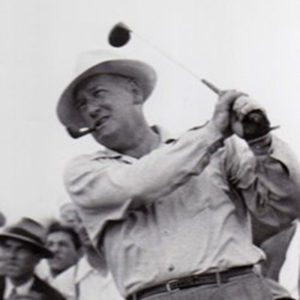
Woodholme Country Club, Rockville, Maryland
MAPGA Hall of Fame Class of 2012
1897-1961. Carroll T. MacMaster’s prominence in the MAPGA and PGA of America included the Presidency of the MAPGA in 1947 and 1948 and the Presidency of the PGA Seniors’ Association in 1956 and 1957. The section’s membership first elected him to office in 1929 as an Assistant Secretary. He became the Treasurer in 1931. Herb Graffis, in his history of the PGA, gives credit to Carroll MacMaster and a number of others, including Ralph Beach, for reviving the PGA of America Seniors’ Association in the early 1950s. As his tenure at the head of the Seniors’ Association concluded, the MAPGA awarded him the 1958 their “Professional of the Year” honor.
Originally from White Plains, New York, Carroll MacMaster started as a caddie in 1909 at the Scarsdale Golf and CC in Westchester County. The caddie master position at Century CC came his way in 1915. Dan Mackie, a PGA pioneer, gave Carroll MacMaster his first lesson at Century CC. His high school chums included the four Turnesa brothers and Tony Manero, all of whom achieved golfing notoriety.
As the United States entered World War I he enlisted in the New York National Guard’s Tenth Regiment which became part of the Fourth Army Corps, 51st Pioneer Infantry. They built bridges in France during the War. Consequently, Carroll MacMaster spent nearly a year in France as a Provost Sergeant in occupied Germany.
After the War, Carroll MacMaster returned to Century CC as an assistant professional under Dan Mackie for several years, 1919 – 1922. At the time, Dan Mackie, one of the thirty-five charter members of the PGA in 1916, held the distinction as a masterful teacher. In 1923, Carroll MacMaster came to the Catoctin Club in Frederick, Maryland as both Head Professional and Greenkeeper. Three years later he accepted the Head Professional position at Rolling Road, then on to Hillendale in 1932 and then to Woodholme in 1935 where remained until his death in 1961.
In the fall of 1923 he married Frederick native Flora Taylor. They had two children, Carroll MacMaster, Jr., born in 1925, and died in 1973, and Flora Jane, born in 1927.
Carroll MacMaster first appeared in golf related newspaper articles in 1923 when he played in the Third Annual Maryland Open at Baltimore CC – Roland Park and also in the 2nd Annual Maryland State Professional Championship held at the same venue. Throughout 1924 – 1927 he regularly appeared in the Maryland State Professional Golfers’ Association events, the PGA Championship qualifiers and the Middle Atlantic Opens. Successful qualification for national events came in 1932 when he made the field for both the US Open and the PGA Championship. And, he qualified for the US Open a second time in 1937. Carroll MacMaster won the MAPGA Senior title in 1951 and the “Senior” Teacher’s Trophy title in 1953. He played in the PGA Senior Championship in Florida for the first time in 1949 and continued to regularly do so until 1959.
In July 1931, Carroll MacMaster shot 62 at Rolling Road in a fourball match with three of the club’s members. He had six birdies going out including four in a row starting on the second. His lone bogey occurred on the par 3 10th. In 1945, he and Glenn Spencer lost to Byron Nelson and Jug McSpaden in one of the national PGA’s exhibitions supporting the veteran’s war relief programs.
As an executive Carroll MacMaster served as MAPGA President during 1947 – 1948. And, he held the National PGA Seniors’ Presidency in 1956 – 1957. Merrell Whittlesey and Jim Wild, preeminent local golf scribes, praised Carroll MacMaster for his steady leadership of the section after golf got underway following World War II. He managed to bring the Baltimore, Washington DC area and Virginia constituency groups into a more workable and cohesive body. He unexpectedly died in October 1961.
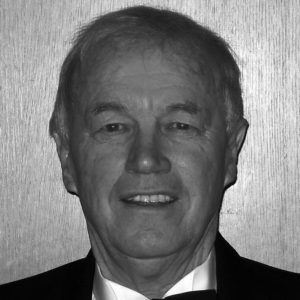
Hank Majewski gained MAPGA Hall of Fame recognition for his contributions to the game, especially to junior golf, and for contributions to the MAPGA and The PGA of America as an administrator. Within the MAPGA he rose to the Presidency in 1988 and to The PGA of America’s District 10 Director’s position representing not only the Middle Atlantic Section, but also the Kentucky and Carolinas Sections. Hank’s awards include MAPGA Merchandiser of the Year (1982), MAPGA Professional of the Year (1988) and The PGA of America Professional of the Year (1988). He is a member of The PGA Golf Professional Hall of Fame Inaugural Class of 2005.
Hank’s golf career began as a ten-year old “underage” caddie at Baltimore CC about 1950. Before entering college he excelled at golf and basketball at City College of Baltimore where his golf teams went undefeated over three seasons. MAPGA Hall of Fame member Bill Clarke coached those golf teams.
During his University of Baltimore years on a golf and basketball scholarship, Hank earned his degree and garnered Who’s Who Among College and University Students distinction. He won the Mason/Dixon Conference Golf Championship in three of the four years. A few years later, while as an assistant professional he entered the University of Baltimore Law School and finished that degree in 1968.
Following graduation in 1961, Hank worked in the private sector for two years before accepting an Assistant Professional position at Burning Tree Club under the legendary Max Elbin. A year later he moved on Baltimore CC as an Assistant to Walter Romans, another MAPGA Hall of Fame member. In 1967 Hank took on the challenge of developing a golf program at the “new Columbia Community” facilities: Hobbit’s Glen and All View. He succeeded. In short order, golf lessons, corporate outings, programs for juniors and women, tournaments and charity events came to fruition. While there, he took over and greatly enhanced the Middle Atlantic Open, which continued under his tenure for another eleven years. The last stop in his career began in 1985 as the owner and PGA Director of Golf at Wakefield Valley Golf Club.
Hank’s career as an MAPGA leader began as Treasurer in 1984, followed by a Vice Presidency before his tenure as President in 1988 and 1989. Prior to that, he served on committees to such an extent that Hank either chaired or held membership on every one of them. When he chaired the Handicap Committee, they moved from a write-in system to a computer system in conjunction with MSGA and the VSGA. This effort significantly contributed to the financial well being of the MAPGA and both State Associations. He hosted the MAPGA Section Championship in 1969, 1970 and 1982. Hank was the primary force leading the movement of the MAPGA into a three-Chapter organization, which has been in place for twenty years.
As the District 10 Director of The PGA between 1993 and 1995, he served on several committees: National Public Awareness, Jurisprudence and Long Range Planning.
One of the stellar characteristics in Hank’s career is the commitment to and the support of junior golf. Throughout his career, junior golfers have played and practiced free of charge at his facilities. Furthermore, for a number of years Hank orchestrated a bussing program that brought children from the region to Hobbit’s Glen. In 1980-1981, Hank also single-handedly rescued the Howard County Public School System Golf Program when the School Board had previously decided to drop the sport in a cost-cutting move. Furthermore, Hank and Frank Emmet, the Dean of Junior Golf in the Region, collaborated on the creation of the Maryland Junior Open.
Hank is also a member of the City College of Baltimore Hall of Fame and the University of Baltimore Hall of Fame for both golf and basketball. (rev. 2009)
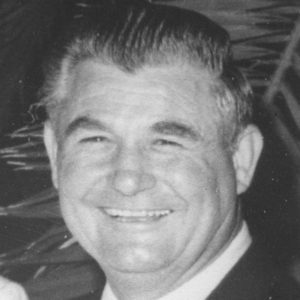
1922-1999. Tony Marlowe’s illustrious golf career included the MAPGA Presidency and chairmanships of several important MAPGA and PGA of America Committees. He began as a caddie at Hoovenkoff CC in Hilburn, New York. He quickly succeeded in developing his game and played the number one position on the high school golf team for four years.
After graduating from high school in 1941, he enlisted in the Army, ultimately serving in Europe during World War II with the Signal Corps as a crewman aboard gliders with the 101st Airborne Division. Tony returned home safely in 1946, but the experiences he faced during his time in the gliders caused him to dislike flying for the rest of his life.
His professional career started as an Assistant at Rivervale CC, New Jersey, in 1946. The following years were spent as an Assistant at the Mountain View Club in New York City and then the 1949 season at the Country Club of New Jersey. He played in numerous “Tour” events during the winter months of 1949 and 1950 including the Miami Open, the Miami International Four-Ball, and the North and South Open in Pinehurst.
Elected to PGA membership in December of 1949, he eventually went to work for PGA Professional Herman Barron at Fenway Golf Club (Scarsdale/White Plains, New York) in 1950 where he remained into 1954. He was to be Tony’s first and most influential mentor and coach. Herman was a highly skilled merchandiser, a talent he passed on.
Tony was selected for his first head PGA professional job in the summer of 1954 at High Ridge Country Club (now Pound Ridge CC) in New York. It was during his years at High Ridge that Tony went to Sebring, Florida, during the winter months and taught at Harder Hall CC and Kenilworth Lodge. He was hired by Woodmont CC and began his tenure as its head PGA Professional on March 17, 1960. Tony retired from Woodmont nearly 30 years later on September 30, 1989.
Tony served as one of the Middle Atlantic Section’s Regional Vice Presidents for six years, then elected President in 1969 and 1970. Twice during his career, 1967 and 1970, the Section named him the MAPGA Golf Professional of the Year. Additionally, Tony chaired the Section’s Employment and Club Relations Committee for two years. In 1980, he received the Bill Strausbaugh Award. On the national level, he chaired the National Education & Club Relations Committee in 1970. He was also a member of the National Manufacturer Relations Committee for three years.
Tony was particularly known for his outstanding putting ability. He won three MAPGA Pro-Assistant Championships (1965 with Ron Howell, 1967 with Mike Fitzgerald, and 1972 with David Jiminez), the 1976 MAPGA Quarter Century Championship, and the Maryland State Golf Association’s Pro-Scratch Championship in 1963 with Alvin Dulcan (Woodmont CC’s club champion at the time). In 1965, Tony made it through the U.S. Open local qualifying at Washingtonian GC. (rev. 2009)
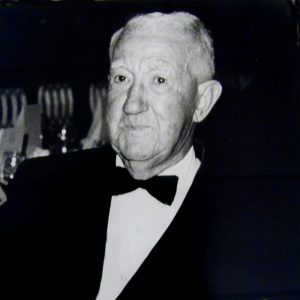
1882 – 1976. Fred McLeod’s PGA Hall of Fame career included distinction as a founding member of The PGA in 1916, and election as the first President the District of Columbia Professional Golfers’ Association in 1923. As a player, his 1908 US Open title highlighted a stellar career.
He came to the United States in 1903 from North Berwick, Scotland, at age 21. Before becoming the Head PGA Professional at Columbia County Club, where his tenure lasted for fifty-five years, (1912 – 1967), he was the Head PGA Professional at Rockford CC, St. Louis CC and Midlothian CC.
Fred played in twenty-four US Opens, seventeen of them consecutively, 1903 – 1921. He won the 1908 US Open at Myopia Hunt Club with a six stroke victory over Willie Smith in an 18 – hole playoff. Fred finished fourth in 1910 and 1911, but only one stroke off the lead; tied for third in 1914; and tied for second along with Walter Hagen on his home course in the 1921 US Open.
He also won the 1909 and 1920 North – South Opens, and the 1922 St. Petersburg Open. He finished fifth on the PGA money list in 1921. While living in the mid West, he won the Western PGA titles in 1905 and 1907. Also, he twice finished as runnerup in the prestigious Western Open.
Playing in seven PGA Championships in the match play era, Fred made it all the way to the finals in the second playing of the PGA Championship in 1919, where lost to his friend, Jim Barnes. In 1921 and 1923, he played through until the semifinals and quarterfinals, respectively. Noteworthy match victories in PGA Championships include winning over J.D. Edgar in 1919, Jack Gordon in 1921, and Wiffy Cox and Clarence Hackney in 1923.
After finishing seventh in the 1921 British Open at Royal Lytham and St. Anne’s, Fred went to Wentworth to take part in the informal Anglo-American matches that proved to be the forerunner of the Ryder Cup that officially began in 1927. He defeated J.H. Taylor 1-up in the matches by winning the last three holes.
Locally, at age 45, he won the Maryland Open in 1927 at Fountain Head. The previous year he had finished a stroke behind Leo Diegel at Rolling Road. Fred played in the Middle Atlantic Opens organized by the MAPGA in the late 1902s. The tournament attracted many well-known touring professionals. In 1927, he lost the championship in a playoff to Leo Diegel. He played in thirteen PGA Seniors’ Championships, winning the second edition in 1938 at Augusta following a fourth place finish in 1937. In 1954, he won the 70 – 74 year old division.
Membership of the newly formed MAPGA Section elected him their first President, serving in 1925 until April, 1926. The previous year, the Washington DC area professionals elected him the first President of the District of Columbia PGA, an organization which lasted through 1927.
Over his years at Columbia, Fred McLeod organized, hosted and played in important exhibitions with the world’s premier players, including: Chick Evans, Jim Barnes, Harry Vardon, Ted Ray, Gene Sarazen, Jock Hutchison, Leo Diegel, Arthur Havers, Jim Ockenden, Tommy Armour, MacDonald Smith, Joyce Wethered, Glenna Collett Ware; and of course, Bobby Jones and Walter Hagen.
The National PGA Hall of Fame elected him to their body in 1960. In 1967, at the age of 85, he had his eighth hole-in-one. His “Ringer” score at Columbia Country Club was 39 (21 + 18)! He started matching his score to his age at 66. In 1967, he walked18 holes in the MAPGA Pro-President commenting that he never played golf while riding in a golf cart. (rev. 2007)
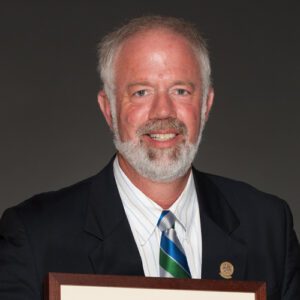
Paul Michaelian, PGA
1962-2023
Paul Michaelian was born in Plainfield, New Jersey on August 11, 1962 to Charlie and Joan Michaelian. He had two older brothers, Tom (Jeanine) and Dick (Becky), and a younger sister, Margaret (DeJournette).
His father introduced him to golf at Williamsburg CC. When his brothers stopped playing baseball and started playing golf, Paul did the same and at age 13 he started playing golf in earnest. In addition to his father, Paul had one other big influence in his life, John Mattson. John was an assistant professional at Williamsburg CC for Banks Guyton. “Big John” took Paul under his wing and, among other things, took him on his first golf trip. Paul was John’s caddy in the Virginia State Open at The Cavalier Golf and Yacht Club.
Paul’s first work experience in golf was at Williamsburg Country Club as the cart boy for Pete Britton, Jr. making $2/hour and all the range balls he wanted to hit, if he picked them up, but 14-year-old Paul loved it. In 1984, after graduating from Pfeiffer University in Misenheimer, NC with a BS in Business Administration, Paul began his professional career in golf back at Williamsburg CC as an assistant professional. He relocated to Richmond in 1987 to be an assistant professional at The Country Club of Virginia. In 1989, Paul was elected to membership in the PGA of America and promoted to Head PGA Professional at CCV’s Westhampton Course. In 1996, Paul was promoted again, this time to be the Head Professional at CCV’s James River and Tuckahoe Creek Golf Courses, where he met his lovely wife, Michele. He then worked as Head Professional at Meadowbrook Country Club in Richmond before being selected as the Head PGA Professional at The Princess Anne Country Club in Virginia Beach. Paul served in that role for thirteen years before retiring in 2016. Even after retiring, Paul continued to serve the golf community by spreading his love of the game to the youth of The First Tee of Hampton Roads.
Paul began his leadership roles with the MAPGA and the Southern Chapter beginning at the end of 1995, when he was elected Secretary of the Southern Chapter. After two years, he was elected to be their President and in 1999, Paul was elected Section Secretary. After serving as the Section Vice President for the two years, Paul served as the MAPGA President from 2004-2005. He has served as the chair and as a member of numerous committees during his time with the Section. Paul served the National PGA as a delegate for many Annual Meetings and on the PGA Board of Control from 2011-2015. In that role, Paul was one of 4 PGA Members to study, learn and help adjudicate issues with specific PGA professionals. In total, Paul reviewed hundreds of cases each year, always trying to help and serve his fellow PGA professionals.
Paul was the recipient of the 1994 MAPGA Professional Development Award, honoring him for outstanding service and contributions in the areas of education and professional development for fellow PGA professionals. He was honored as the MAPGA Professional of the Year in 2003, the Section’s highest annual honor for the consummate PGA professional.
Paul was married to his wife, Michele, for 24 years. Together, they raised three children: Kyle, Ross, and Caroline. Kyle went on to be a First Lieutenant in the US Army and now has 2 children of his own (Miles and Parker) with his wife, Christina. Ross is serving in the US Navy, stationed in Virginia Beach and in the spring, Caroline will be graduating from nursing school at Virginia Commonwealth University. Paul proudly told everyone he met about their three children and two grandchildren.
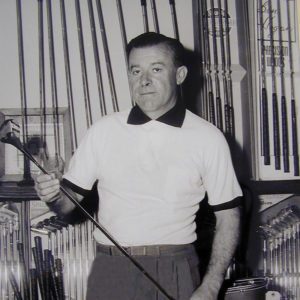
1913–1999. John O’Donnell entered into the MAPGA Hall of Fame for his stellar play in regional and national events and for years of contributions to the MAPGA. On several occasions, the MAPGA membership elected him a regional Vice President or sent him to the National PGA Convention. He was the host pro for the PGA Tour stop, the Eastern Opens at Mt. Pleasant and Pine Ridge, between 1956 and 1962.
Born in Baltimore, John began his golf career caddying at the Baltimore Country Club’s in-town course, Roland Park. As a seventeen-year-old he turned professional in 1930 working as an assistant to Leo Kernan at Greenspring Valley Hunt Club. Four years later, he became the head professional and greenskeeper for the Officer’s Club Golf Course at Edgewood Arsenal in Aberdeen. John went to the Country Club of Virginia in 1940 as an assistant to Bobby Cruickshank, and then to West Point Country Club in 1942. In 1943, John joined the U.S. Navy. As a Chief Petty Officer in their physical fitness program he worked with boxer Gene Tunney. During that time he also taught golf alongside Paul Runyan, Herman Keiser and Chandler Harper. In 1945, John became the head PGA Professional at the Navy’s Sewell’s Point Golf Club. It was there that he starred in the first golf instructional television show in the United States, Par in the Parlor. After eleven years at Sewell’s Point, John moved on to the Mt. Pleasant Golf Course, where he served for 27 years as their head PGA Professional, 1956-1983.
Nationally, John played in seven U.S. Opens between 1946 and 1961, finishing 55th at St. Louis CC in 1947, and 51st at Merion in 1950. John played in six National PGA Championships, five at match play. In 1956, he lost a second round match to Sam Snead on the 20th hole. In 1960, at stroke play, he finished 59th. He played, and placed in the money, on the regular tour, the Caribbean Tour and the European Tour. On the PGA Tour he appeared in the Hershey Open during the 1930s and the Eastern and Virginia Beach Opens in the 1950s. John finished 8th against the touring professionals in 1950 at Cavalier and 7th in 1953.
Regionally, John won the Maryland Open twice (1939 and 1954), and the Virginia State Open five times (1948, 1951, 1953, 1954 and 1955). In 1954, at Manor, his second round 67 laid the basis for a win the next day. In 1948 at Hampton CC he won his first Virginia State Open title with a last round 67.
In the MAPGA Championships and events of national importance he won the Maryland and Virginia State Opens in 1954 and was the only Section player to qualify for both the PGA Championship and US Open that year. He earned 1956 Player of the Year honors. For that year, his credentials include medalist honors in the PGA qualifier at James River CC, medalist honors in the US Open qualifier at Mt. Pleasant, and a 65 at Cavalier Yacht and CC in the year-end pro-am.
In MAPGA pro-ams, he won the first time at Prince George’s CC in 1942 when he and Jack Isaacs tied with 68s. The last came at Norbeck in 1963 with a 69.
In 1963, John won the MAPGA Senior Championship at Fountain Head at the Mt. Union Open in Pennsylvania. He and his son captured the Maryland State Pro-Am in 1964 at Argyle.(rev. 2004)
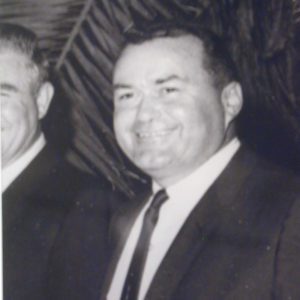
1922 – 1997. Carl Rasnic, a native of Lee County, Virginia, held a greater variety of leadership positions in the MAPGA than any other figure in the second half of the Twentieth Century. His legacy includes being both President and Executive Director of the Section.
Carl entered the Marine Corps in 1944 after two years at Virginia Tech, where he also played basketball and baseball. He saw action in the Pacific theater, notably Iwo Jima. Never having played golf, his initial foray into the sport took place while on “R and R” in Hawaii. Following the War, Carl worked for the Veteran’s Administration for two years. His entry into the golf business started when he opened a driving range in 1949 in Berwyn Heights, Maryland.
In 1957, Carl officially became a golf professional when he took the head professional job at the Gunpowder Golf Club in Laurel. From December 1958 through much of 1961, Carl held the head professional position at Fredericksburg CC, which also included the course superintendents and club manager’s responsibilities. While there, he oversaw the construction of the second nine, which he designed. An eight-year stint as head PGA Professional at Fort Meade followed. In 1969, he began the Golden Triangle golf course project in Crofton, Maryland, where he remained until 1978. His last PGA professional position took place at Martingham, now Harbourtowne, which ended in 1981. For the next several years Carl Rasnic held paid positions with the MAPGA. Beginning in 1981, he worked as the Tournament Director and Club Relations Coordinator through 1984. He concluded his career as the MAPGA’s Executive Director starting in late 1984 and continuing into 1986.
Carl Rasnic never played in an amateur golf tournament. His first experience with tournament golf occurred in the District of Columbia Open at the original Indian Spring. Carl’s name appeared at the top of the leader board for the first time in 1955 in the Pro-Junior at Elkridge, where he bested Andy Gibson and Johnny Musser by a stroke. In regional events, Carl finished third in the 1958 Maryland Open at Chevy Chase. The next year, and the year after, he won pro-ams at Argyle and Bonnie View. In 1962, he topped his professional colleagues at the Willow Oaks pro-am with his Hall Fame comrades Clarence Doser, Dick Whetzle, and Leo Steinbrecher all behind him. In MAPGA Championships, he and Colonel Ed Quarantillo won the Pro-President Series in 1963 at Fountainhead CC. Then, in 1967, in the Pro-President event at Hermitage, he shot 67 to win the pro sweeps and followed that with a win at Lakewood.
After being elected to PGA membership in 1962, it took only four years for Carl to rise to the MAPGA President’s position. Carl Rasnic, Leo Steinbrecher, Bill Clarke and Bill Strausbaugh formulated the agreement which gained PGA membership for the non-PGA guys who had at least five years of professional experience. They entered the MAPGA as full members, and at the time created the Virginia Chapter of the MAPGA in 1966. He also oversaw the opening of the Section’s first office. He held the chairmanship of the MAPGA’s Board of Control and the Tournament Committee as well. In 1965, the MAPGA named him the Professional of the Year. Twenty years later, 1986, the Section awarded him the Bill Strausbaugh award for “special recognition…in the field of Employment and Club Relations by promoting and enhancing improvement in employment relations in the mid-Atlantic region.”
The MAPGA named their Pro-Assistant Championship Trophy in honor of Carl Rasnic. (rev. 2004)

Larry was born in Hagerstown, Maryland to Robert Mervyn and Julia Marie Ringer. He is the oldest of three brothers, James David and Rick Alan. After Robert’s service in WWII, he moved his family all over the mid-Atlantic region due to his position with a Coca-Cola Bottling Company; Robert retired 41 years later as the Vice President for Military Sales.
Larry credits his father with introducing him to the game of golf. He remembers his little league coach dropping him off at the CC of Culpeper after baseball games. Larry took his first whiffs at a golf ball wearing his little league uniform and baseball mitt; he vowed to not let that dumb old golf ball take advantage of him ever again. At the age of 11, Larry started to receive golf lessons from Dick Amidon, Head PGA Professional at the CC of Culpeper. It was there that he won the Junior Club Championship in 1956.
Larry is a 1963 graduate of LaPlata High School in LaPlata, Maryland where he played four years of varsity basketball and one year of golf. He attended Charles County Community College for one year where he won the Eastern Regional Junior College golf qualifier in 1964, but then went on to play basketball and golf for Murray State University (Murray, Ky.)
Larry graduated with a B.S. degree in Business Administration in 1967. That same year, he was elected President of the Murray State “M” Club (club for athletes of all sports who earned a varsity letter), selected as their Most Valuable Golfer, named NCAA All America, and qualified (at Hillendale CC in Phoenix, Md.) for the U.S. Amateur, competing at the Broadmoor in Colorado Springs.
Larry’s first golf-related job came in 1969 when he was hired to work on the grounds crew at Hawthorne Country Club in LaPlata. He was hired to rake bunkers, mow grass and hand-pick crab grass out of the greens. After about a month of that task, he was elevated to Assistant Professional under the tutelage of Head PGA Professional Michael Bigony. After one season, Larry went to Wicomico Shores Yacht & Country Club and worked the summer for Head PGA Professional Keith Eynon. Larry became a very “well rounded” assistant at Wicomico because he gained experience in the golf shop, cleaning golf carts, cooking for the golfers and playing golf after work.
Larry turned professional in 1971 as an assistant at Bel Air Golf & Country Club (now Bowie G & CC in Bowie, Md.) for Head PGA Professional Bill Deck (MAPGA Hall of Fame Class of 1998) before taking an assistant job at Congressional Country Club where he worked for Head PGA Professional Bob Benning. He was elected to PGA Membership February 1, 1974 and spent the next couple of years competing on the PGA Tour.
In 1976, Larry started work at the U.S. Naval Academy (Annapolis, Md.) as an assistant for Head PGA Professional Alan Neiderlitz. Alan left the following year and Larry was selected to replace him. For the next 15 years (1977-1991), Larry was the Head PGA Professional and Golf Coach at the Academy. He then went on to serve the members at the Country Club at Woodmore as their Head PGA Professional until 2000. Since then, Larry taught at Enterprise Golf Course (Mitchellville, Md.) for a year before moving to Country Road Family Golf Center (Frederick, Md.) where he taught for 5 years. In 2006, he became the PGA Director of Instruction at Musket Ridge Golf Club (Myersville, Md.) before becoming the PGA General Manager/Head PGA Professional there in 2007.
In 2009, Larry returned to his current position as the PGA Director of Instruction at Musket Ridge. The development of his professional staff members has not only been paramount in his efforts, but has also led many of his assistants to go on to be Head PGA Professionals at many facilities across the country. Larry has been a leader at the highest level at each club he has been associated with and gained the respect of those memberships and guests alike.
Larry has served on the Section Board of Directors in several different capacities over numerous years having been both elected and appointed. He served as Secretary (1991-92) and President (1993-94) of the Northern Chapter while simultaneously serving as the Section’s Tournament Chair. He actually served as the Tournament Committee Chair or Co-Chair on three separate occasions since 1977 and continues to serve as a member of that committee today. Larry also continues to serve on the Northern Chapter Board as a Past President and an elected Regional Director.
In the past, he also served as a member or Chair of the following Section or Chapter Committees: Education, Boundaries, Scholarship and Mentoring. Never one to be shy, several of Larry’s initiatives and proposals have gone on to serve the MAPGA membership well and remain in effect today, to include changing the prerequisites necessary to be elected Section President. His dedication to The PGA has been continual and unwavering in every way for nearly 40 years now.
While Larry’s service to the Section is impressive, his playing record is even more remarkable. One highlight was leading the U.S. Senior Open at Congressional Country Club in 1995 after the first round with an opening 68 as an unheralded PGA Club Professional (finishing tied for 21st.) On the Section level, Larry has been quite dominant, winning almost every major in the Middle Atlantic PGA. He was the recipient of the MAPGA President’s Award in 1995. Larry was elected to the Murray State University Sports Hall of Fame that same year.
Larry’s philosophy about golf has developed through the tutelage of other PGA Professionals with whom he has worked. His work ethic has always been geared toward future success because he knew he was not as talented as other players. Larry tries to gear his mental state of mind toward always being prepared and never being negative in his approach to success. His teaching philosophy has continually been to show “cause and effect” by having the student work with his/her strengths and avoid weaknesses.
Larry and his wife, Judith, were married 21 years ago in the U.S. Naval Academy Chapel. They have two Scottish Terriers, Morgan and Chloe.
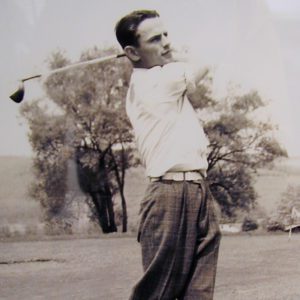
1917-2009. Walter Romans earned his MAPGA Hall of Fame membership through impressive play over the course of several decades. He held the Section’s Tournament Director position in 1951 and the Maryland Vice President position in 1954.
Walter, born in Warren, Massachusetts, started caddying around age 14. The PGA elected him to membership in 1938. Before serving in the Army during World War II, he won the Central New York Section Championship while still a young professional in Utica. After the War, he moved to Baltimore CC as the head PGA Professional, serving 39 years from 1945 to 1984, doing double duty at Five Farms and Roland Park. Upon his retirement, the club named him their Professional Emeritus.
His playing career is marked by success on the regional and national levels. Nationally, he played in five U.S. Opens and twelve PGA Championships, and then as a senior in a number of PGA Senior Championships. His twelve National PGA Championships included six at match play and six at stroke play. Walter’s best showing was advancing to the third round in 1949 at Hermitage Country Club by defeating Jack Ryan and Frank Moore. In his first six appearances, when the tournament included a 36 hole qualifier for the match play portion, he played his way into the match play field four times. Walter played the U.S. Opens in 1940, 1947, 1953, 1955, 1969, and qualified for the event in 1960. When the PGA Tour stop took place at Mt. Pleasant and then Pine Ridge, Walter acquitted himself admirably over the years, frequently cashing a paycheck. In 1950, he finished seventh. He made a few other PGA Tour events and finished quite high, and was in contention to win at the New Orleans Open and Texas Open in San Antonio in the late 1950s. He and Todd Hauck won the 1964 National PGA Senior-Junior. Additional credits include earning a spot on the Section Schmidt Cup Team in 1967 that played the Philadelphia Section.
His string of successes in the MAPGA Match Play Championships is significant. He won the Baltimore City Open six times: 1946, 1952, 1953, 1955, 1959, and 1963 by defeating Ralph Beach, Charles Bassler, Bill Moran, Harry Parr IV, Billy Gilbert and Lou Graham, respectively, in the final match. He lost the final match five times. Walter even made it to the semifinals at age 66. Locally, Walter won the 1948 District Open by shooting 65-68 when it was contested at the original Indian Spring Club and the 1953 Uplands Open at Rolling Road with 64 and 72. He captured the Maryland Open twice, the first time in 1956 at Woodmont and the second in 1959 at Woodholme. His credentials also include the 1959 pro-am at Hot Springs, Homestead course shooting 69-69. He and member Jack Emich won the MSGA pro-am championship in 1957 and 1959.
As a senior golfer, his titles include the 1970 and 1974 MAPGA Senior Championships and the 1977 MAPGA Quarter Century Championship; and in 1978 and 1979 the 60-64 age group winner in the Senior Championship. In the National PGA Senior Championships he finished in a tie for 49th in 1968, in a tie for 42nd in 1970, and again in 1975 in a tie for 39th. At sixty-years-old, he finished in a tie for 33rd in his last appearance.
Walter made his 11th hole-in-one at age 77. (rev. 2004)
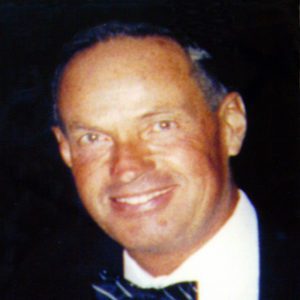
Herb Rose entered the MAPGA Hall of Fame for his years of service to the Association, including two years as President. Herb laid the groundwork for the MAPGA tournament program, and for establishing rules, regulations, policies and procedures that are still the basis for today’s extensive tournament program.
Herb, originally from Jamaica, New York, grew up in East Rockaway, Long Island. He attended Peddie Prep School in New Jersey for two years where he played golf at the school course and came to love the game. Herb earned his bachelor’s degree from the University of Virginia in 1966. From there he accepted the assistant job at Bow Creek Golf Club where Tom Strange held the head PGA Professional position. In 1969, Herb moved on to Bay Hills Golf Club in Arnold, Maryland, and in 1976, he purchased the club. After seventeen years, 1969-1986, as the head PGA Professional, he held the PGA Director of Golf position until 1992 when he retired to Florida.
Always service-minded, forward thinking and dedicated, for many years he sat on the section’s Board of Directors. After holding the Treasurer’s position, he moved up to Vice President in 1972-1973, and then to the top spot as President in 1977, serving two years. As President his goals included retaining a Tournament Director to upgrade the Section’s events and to enhance both professional and amateur golf events in the middle Atlantic region.
The Section selected him as the MAPGA Professional of the Year in 1979 and he also received the 1988 President’s Award from Hank Majewski. In 1984, the MAPGA elected him to represent them as a Director for three-year term on the National PGA Board of Directors. The Carolinas, Kentucky and Middle Atlantic Sections made up District Ten at the time.
As a player, Herb Rose won pro-amateur tournaments at Montgomery CC in 1972 with a seven under 66, tied for first or won at Nassawango in 1975, Hobbit’s Glen in 1977, Piney Branch in 1978 and at Evergreen in 1979, and finished third in the Salisbury Open at Green Hill in 1973. Herb played in two PGA Club Professional Championships as well. (rev. 2004)
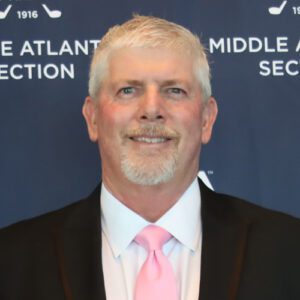
Rick Schuller, PGA
Rick was born in December 1962 in Jacksonville, FL at the Naval Air Station, to parents Rear Admiral Gordon “Dutch” Schuller and Anita (Faustini) Schuller. He was the youngest of 5 children with older brothers Jeff (now deceased) and Ron, and older sisters Donna and Laura (now deceased).
Rick moved around a bit as a youngster, but feels he got the best end of the deal compared to his siblings because his father had progressed in rank (and better housing) by the time the youngest child was growing up! His Dad was often deployed for 6 months at a time, but his mom was an amazing superhero to get 5 kids everywhere they needed to go and to finish their homework!
Rick became exposed to golf when the family was stationed in Japan at Atsugi Naval Air Station. Their family housing backed up to the golf course, and there was a 60-yard golf hole in their shared backyard. He loved playing around and started working at the driving range at the golf course. As the only family member who played (at the time), he taught himself to play and is still essentially self-taught. He played in his first tournament in Japan, and still has the press clipping. He still played all the other sports and feels that helped his game immensely.
When Rick and the family moved back to Virginia, he joined the golf team at Fairfax High School with Frank and Rob Ferguson and was coached by their dad. He loved playing and practicing with the team, played many rounds at Army Navy Fairfax, and got good enough to draw attention from college coaches. He was recruited to Old Dominion University to play golf by Murray Rudisill. Even though Rick attended through 1985, Coach Rudisill is still there!
Rick tried the minitours for a grueling 5 years. He relocated to Florida and had his ups and downs. Ultimately, afterward he quit golf altogether for 2 full years. A request for a lesson from his Father-in-law got him reenergized in the game. He was able to land a job at Congressional CC as the junior golf professional in 1992. Rick next went to Chantilly CC, where he worked under a man he would call his mentor, Dick Canney. Dick was very connected to his PGA peers, and also a good player. After helping to open River Creek Club with Bud Lintelman, Rick was playing well enough to earn conditional status on the then Buy.com tour in 2000 (Now Korn Ferry Tour), which got him a dozen starts or so.
A move to Richmond later that year, first working for John Sarrett at Willow Oaks CC, led to Rick’s first Head Professional job at CC of Petersburg. He then moved to the same role at River’s Bend GC. After that didn’t work out, Rick returned to his love of teaching, at Swader’s Sports Park, then Stonehenge CC, and now at Meadowbrook CC.
Rick’s Section playing record is almost impossible to quantify. He has been an outstanding player in the Section for many years. Rick won the Section Championship 4 times (’03, ’04, ’08, ’09) and was Section Player of the Year 5 times (’98, ’04, ’07, ’09, ’14) and Senior Player of the Year 6 times (’13, ’15, ’17, ’20, ’21, ’22). He has been in the top 5 of our Player of the Year lists (Regular or Senior) for an amazing 17 straight years dating back to 2007. In 2009, Rick won both the National Match Play and the National Stroke Play on the way to winning National Player of the Year honors. He also won the National Match Play in 2006 and 2011. He played in the National Club Pro Championship 15 times, and the PGA Championship 3 times (2001, 2003, 2016). He also played in 3 Senior PGA Championships, a US Amateur (1984) and two US Opens. Rick’s list of playing accomplishments includes over 100 wins in MAPGA Section events and qualifiers.
Rick says he owes his success to his parents. They instilled discipline in his upbringing. You set goals, and then worked hard to achieve them. His Mom and Dad, complimented by his siblings, taught him perseverance and persistence. He was driven by a desire to keep up with his older brothers and sisters, which developed into a life-long habit.
Rick is married to his wife, Wendy, of 24 years. They have adult children Lee, Sam, and the late Hannah (Schuller) Horr.
1883 – 1968
Tom Skipper, a founding member of The PGA of America, pursued a golf career that spanned two continents and six decades. Not only did he attend the inaugural meeting of The PGA of America on January 16, 1916, he also contributed to the development of the Maryland State Professional Golfers Association in 1923 and the Middle Atlantic PGA Section in 1925. After relocating to Princess Anne Country Club in 1927, he played a role in the attempt by regional professionals to form a new section, the Tidewater PGA in 1936. Herb Graffis in the definitive history of the PGA of America credited Tom Skipper as one of the founding members. After retiring to Dunedin, Florida during World War II, he accepted the Pro-Manager position at the National PGA course during 1952 when their professional unexpectedly took another job.
Born in London, he worked for Harry Vardon between 1903 and 1909, then came to the United States in 1914 at age thirty-one. Initially, he held positions at courses on Long Island, New York, and then Pittsfield, Massachusetts. In 1916 he accepted the Head Professional position at Suburban CC in Baltimore and moved to Rolling Road in the spring of 1920 where he remained through 1926.
After becoming the Head Professional at Rolling Road CC in Catonsville, Maryland, he suggested and organized the first Maryland State Professional Golf Championship in 1922. In the tournament he finished second to Jimmy Roche of Elkridge CC. They played at Baltimore CC and Rolling Road over thirty-six holes on each of two successive days. The silver trophy they bought and had engraved sits in the Elkridge CC display case. Subsequently, he and Bill Scott (Baltimore CC),
Charles Betschler (Maryland CC and MAPGA Hall of Fame member) and Glenn Spencer (Green Spring Valley) established the Maryland State Professional Golfers Association in 1923. The organization existed through 1928.
When the Baltimore and Washington DC professionals played against one another in 1925, the Baltimore group named him their team captain. Skipper and Fred McLeod split two matches with McLeod winning at Columbia, and Skipper at Rolling Road. Later in 1925, Tom missed playing in the PGA Championship by a stroke at the regional qualifier. When the MAGPA professionals took on the Philadelphia Section pros at Rolling Road in 1926, he defeated George Griffen. After moving to Princess Anne in Virginia Beach for the 1927 season, he finished second in the 1928 Virginia State Open held at Princess Anne behind Charles Isaacs. He led after the first day, including a first round 74. Several years later, 1931, he aced the Truxton Manor’s 9th on the second day of the Virginia State Open. It was his third hole in one, the first came in 1909 in England, the second in 1915 at Huntington, Long Island.
The Norfolk and Virginia Beach area golf professionals formed the Tidewater PGA in 1936. The organizational meeting took place at Cavalier Yacht and CC on March 2nd. Al Houghton, a MAPGA Hall of Fame member, and he more so than others, initiated the first meeting. At the March 16, 1936, meeting, the group elected Houghton the President, and Walter Beckett (Truxton Manor), Jim McMenamin (James River CC) and Tom Skipper the first, second and third Vice Presidents; and Russell Emig (Portsmouth GC) the Secretary-Treasurer. However, their attempts were short-lived and they never affiliated with the PGA of America.
As a player Tom Skipper qualified for the 1926 US Open at the Sectional Qualifier played at Merion. He began playing in the PGA Senior Championships when that series started in 1937 and finished 9th in his first attempt. He played again before World War II interrupted professional golf for several years. After retiring in 1942, and when professional golf resumed after World War II, he again teed it up in the 1945 Seniors Championship and continued to play annually through at least 1959. In 1954, he and Fred McLeod led the 70 – 74 year old age group with identical 70 – 74 – 144s.
In a career lasting well past sixty years, Tom Skipper played a significant role in the formation of four professional golf associations: the PGA of America, the Maryland State Professional Golfers Association, the Middle Atlantic PGA, and the Tidewater PGA. Following their formation, he continued to work for betterment of those organizations and the status of professional golfers.
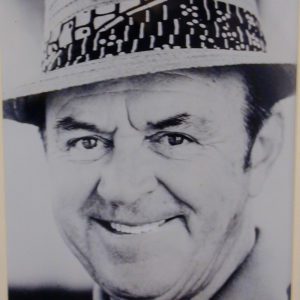
1912–2002. Sam Snead’s career ranks him as one of the greatest professional golfers of all time. Born in 1912 in Hot Springs, Virginia, Sam started caddying at the Homestead’s Old Course and accepted a professional position there in 1929. He moved to the Cascades course in 1934. Sometime later he became affiliated with The Greenbrier in White Sulphur Springs, West Virginia. After turning professional in 1934, he played in local and regional tournaments winning the West Virginia Closed Pro in 1936. His first effort on the PGA Tour took place later in 1936 at the Hershey Open where he finished fifth. Sam made his way to California for the opening of the PGA Tour’s 1937 season. He won the Oakland Open and four other titles that season.
Sam eclipsed many records associated with the PGA Tour: 81 titles, three PGA Championship titles, three Masters titles, eight Ryder Cup teams, leading money winner three times, Vardon Trophy winner four times and Tour Player of the Year in 1949. In 1965, the 53 year-old Snead won the Greensboro Open for the eighth time, setting a Tour record for oldest winner and for winning an event the most times. In 1974, the 62-year old Snead finished only three back of Lee Trevino in the PGA Championship. At the 1979 Quad City Open, he shot a second round 67, the first person to shoot his age in a PGA Tour event and followed that with a 66 the next day. The record still stands. He won his only appearance in the British Open in 1946 at St. Andrews. Sam Snead won six PGA Senior Championship and five World Senior titles. He won the PGA Club Professional Championship at age 71.
Sam Snead finished second in the U.S.Open four times. In 1939, thinking that he needed a birdie to win the title at the Philadelphia CC, he ended up missing a playoff after taking a risky shot from a difficult lie in the fairway. He lost a playoff to Lew Worsham in St. Louis in 1947.
Sam Snead made numerous appearances in the Middle Atlantic PGA area. In 1939, he shot 74-65 at Congressional in the US Open Qualifier. In 1941, at the Virginia PGA Open at Ocean View, he finished two strokes behind Chandler Harper. After the War, he defeated Chandler Harper in a playoff for the Virginia PGA Open at Cavalier in 1946. Snead’s last appearance in a Virginia PGA Championship took place the following spring. The young prodigy George Payton won with Chandler Harper and Snead in second and third place. The next week, Sam Snead appeared in his only MAPGA Section Championship. At Hampton CC in 1947 he finished behind Lew Worsham, Jack Isaacs, and Chandler Harper.
As the 1940s ended and the 1950s began, Snead continued to appear in regional events. In 1949, he shot 63-68 at Army Navy to win the Open Division of the National Celebrities and won the National Capital Open at the old Prince George’s CC with a 64 in the third round. In 1950 he won at Chandler Harper’s tournament celebrating Glensheallah Golf Course’s closure. In a 1952 exhibition at the no longer in existence White Flint course he shot an 8 under 62 and followed that with a win in the PGA Tour stop Eastern Open at Mt. Pleasant. One of his last appearances in the Middle Atlantic area occurred at Bowie Golf Club in 1990 to lend his name to a hospice charity event, the Sam Snead Classic.
Sam Snead is a member of The PGA Hall of Fame, the World Golf Hall of Fame, the Virginia Sports Hall of Fame, the West Virginia Hall of Fame, and the Helms Hall of Fame and in 1998, received The PGA’s Lifetime Achievement Award. (rev. 2004)
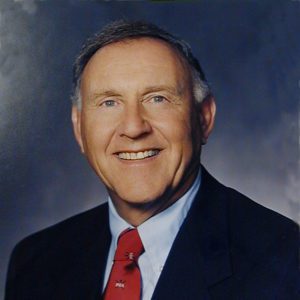
John Snyder’s contributions to the formation and administration of the Virginia Chapter of the MAPGA, his service to the MAPGA, and his dedication to the development of junior golf programs earned him entry into the MAPGA Hall of Fame.
John grew up in Troy, New York, and took up golf after his parents built a home near Frear Park Golf Course. Soon thereafter he started caddying at the Country Club of Troy. John first started playing the game about the time he turned 7.
John took to the game rather quickly and by the time he turned 14 he had played in the first USGA Junior Championship held at the University of Michigan Golf Course. The following year John qualified again for the tournament, this time at Medinah. In the 1950s he became one of New York’s top amateurs, winning the Eastern New York Amateur and making it to the finals in the New York State Amateur. He also won numerous club championships as well as seventeen regional invitational tournaments. At LaSalle Institute, his high school, he excelled at basketball, baseball and golf. The baseball and golf carried over to Sienna College.
After a few years working in his father’s business, he decided to turn to professional golf at age 27 in 1961. The following spring he accepted Joe Cannon’s offer of the assistant position at Farmington Country Club. In 1965, he succeeded Joe as the head Professional where he remained for 23 years. The PGA elected him to membership in 1967. In April of 1988, he was offered, and accepted, the head PGA Professional job at Water’s Edge Country Club where he served until his retirement in 1996.
In the mid 1960s, John Snyder and his Virginia colleagues ran the Virginia Chapter of the MAPGA when the Virginia Association of Golf Professionals became an official Chapter in the Section. Between 1966 and 1968, he held the Secretary’s position in the Virginia Chapter, then Treasurer and President. He also served as their Tournament Chair in 1974 and 1975. For sixteen years, 1967-1983, John sat on the Executive Committee, and before that he served on the Employment Committee, 1971-1973. The MAPGA named him Secretary for 1970 and he sat on the Board of Control from 1976-1989. He also taught the business side of professional golf at PGA schools and seminars.
As a professional player in Virginia, he won a number of pro-ams, finished second to Chandler Harper in the VSGA Open, and won the Dogwood Festival at Keswick in 1969. In Section events he won his age group in the MAPGA Senior Championship and played in one National Club Professional Championship. He once shot seven-under 63 at Farmington.
The MAPGA selected him as their Professional of the Year in 1976 and their 1980 Merchandiser of the Year (Private Category). He was inducted into the Dewar’s Hall of Fame for Virginia Golf Professionals in 1986. (rev. 2004)
1899 – 1983
Glenn Spencer put together one of the finer playing careers in MAPGA history during the 1930s and up through the mid 1940s. He won the MAPGA Championship in 1932, the MAPGA Match Play Championship in 1945, and the Maryland Open in 1930. Twice, he captured the Maryland State Professional Golfers’ Association title, 1926 and 1928. He played in four PGA Championships.
As an officer in regional golf associations, he served as Secretary of the Maryland State Professional Golfers Association in the mid 1920s, and President of the Middle Atlantic PGA in 1934. He attended the MAPGA’s formative meeting at Columbia on March 2, 1925. He and A.F. Bergman, the District of Columbia Professional Golfers Association Secretary, made the meeting arrangements.
Glenn Spencer and his four brothers, all of who entered golf careers, along with Warner and Nate Mather, grew up in the neighborhoods close to the Baltimore CC Roland Park course. There they all began as caddies, Glenn in 1907, and became important figures in the Section’s history. Then he worked for James Braid and Harry Henze, the Baltimore CC course professionals, starting in 1913. In 1916 Glenn started playing competitively on the public courses and turned professional in 1919, but only sold sporting goods until accepting a position at Green Spring Valley in 1922. He subsequently held Head Professional positions at Maryland CC, Forest Greens, Rolling Road and Catoctin CC which became the VFW club in Frederick.
Glenn Spencer played in the first Maryland State Professional Golfers Association Championship in 1922. In 1926 and 1928, he won their title before the organization disbanded in 1928.
In Sectional Championships, he won the 1932 MAPGA Championship when he defeated, in order, his brother Cliff, Ralph Beach, Gene Larkin and Charles Betschler. Twice in the MAPGA Championship, 1928 and 1933, he lost the final match when Jimmy Roche and then Ralph Beach defeated him.
In his first Maryland Open, 1923, he finished third. He won the Maryland Open in 1930 at Rolling Road and then finished two back of Ralph Beach the next year. During the late 1920s and early 1930s he routinely finished well up close to the leaders.
Nationally, he qualified for four PGA Championships: 1928, 1931, 1933 and 1934; and three US Opens: 1926, 1929 and 1932. In the 1928 PGA Championship, he defeated Fred McDermott in the opening round, but lost to Perry Del Vecchio on the 37th hole in the next round. In that match Del Vecchio led by five after the morning 18, but Glenn closed to force extra holes. He made trips to the US Opens at Scioto, Winged Foot and Fresh Meadow, but missed the cut each time. Those who saw him play have commented that he hit the ball as long as anyone with a swing as smooth as anyone’s. Tom Kernan, whose father Leo held the Head Professional positions at Green Spring Valley and then Princess Anne, saw Glenn Spencer play and commented in a interview that his swing was as good as Snead’s.
In the 1925 Middle Atlantic Open, the first one ever held, Glenn Spencer and Jimmy Thomson from Hermitage tied for fifth in the star-studded “tour” field at Burning Tree. Since they were the top MAPGA finishers, they were expected to hold a playoff for the MAPGA “Sectional” Championship. However, no records of that playoff have been discovered in the Baltimore Sun or Richmond Times Dispatch. Furthermore, a 1931 biographical sketch of Glenn Spencer and subsequent PGA Tour information about Jimmy Thomson do not refer to either winning the MAPGA Championship. He returned for the 1926 Middle Atlantic Open, that year at Rolling Road, and again held his own finishing thirteenth. Then in the 1927 edition at Indian Spring he came in four strokes behind the leaders Leo Diegel and Fred McLeod and tied with Tommy Armour for fourth. Willie Leach finished third. He and McLeod led after the first day at 146. Diegel won the playoff over McLeod. Teeing up in the last Middle Atlantic Open in 1930 at Woodholme that Gene Sarazen captured, Glenn finished higher than his MAPGA contemporaries, but in eighth place.
Glenn Spencer played many of golf’s great ones in exhibitions. When
Bobby Cruickshank and US Open winner Cyril Walker played a series of matches against the Baltimore area professionals in July, 1924, they defeated Glenn Spencer and Warner Mather at Sherwood Forest by 4 and 3. In 1929, he and J. Munro Hunter defeated Horton Smith and Leo Diegel in an exhibition at Indian Spring, and then with Warner Mather overcame the same duo at Woodholme. In another exhibition a few years later at Woodholme, 1933, Glenn Spencer and Warner Mather defeated Denny Shute and Ed Dudley. Spencer shot 72, the lowest score. In 1945 he teed it up with Carroll MacMaster against Byron Nelson and Jug McSpaden at Woodholme. Nelson and McSpaden triumphed 5 and 4 when McSpaden played spectacularly with six threes on the frontside.
Little is known about Glenn Spencer from the late 1930s until 1944 when he accepted the Head Professional position at Rolling Road succeeding Alec Taylor. However, once Maryland CC\Strathmore failed, he was probably at Forest Greens, the nine-hole facility at the Aberdeen Proving Grounds\Edgewood Arsenal. In his four-years at Rolling Road, he routinely played in the MAPGA Match Play Championship (the Baltimore City Open) at Green Spring Valley, which he won in 1945 by defeating amateur Frank Michalek, and professionals Jimmy Duke, Carroll MacMaster and at that time, amateur and later tour professional Bill Collins in the final. After leaving Rolling Road, Glenn Spencer held the Head Professional position at Catoctin CC, which became VFW, in Frederick, where he concluded his career. He played his last competitive golf in the 1953 MAPGA Championship and in the 1955 MAPGA Teacher’s Senior Championship qualifier.
All in all, Glenn Spencer played at an exceptional level, served as Secretary of the Maryland State Professional Golfers Association, and rose to President of the MAPGA, and had contributed to its formation in 1925.
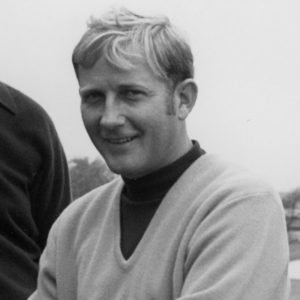
William “Spo” Sporre earned MAPGA Hall of Fame recognition for his outstanding play and for his forty years of steadfast contributions to the association. During the mid 1960s Bill established his presence as a premier player and continued to do so well into the 1970s. Twice “Player of the Year” (1968 and 1970) testifies to the skills and dedication he brought to bear in one tournament after another. His contributions to the MAPGA include Northern Chapter President, but more importantly, more than forty years on the Tournament Committee and four years as its chair.
His golf career started as a thirteen year old in 1949 when he went to Madden Park in Dayton, Ohio, with his father. As a star high school athlete he played on the basketball, track and golf teams. In track he pole vaulted, threw discuss and ran sprints. Following several years of junior tournaments Bill accepted a golf scholarship to Ohio State University. Immediately after his Ohio State time he spent two years in the United States Army, mostly in Fairbanks, Alaska. While in the Army, Bill won the Alaskan Amateur in 1960. Soon after discharge while back in Ohio his reserve unit received a call up notice which brought him to nearby Fort Meade in 1961. A year later, his PGA Professional career began as an assistant to Carl Rasnic at Fort Meade. After six years there, he spent two years as an assistant to Ward Burgess at Chevy Chase before accepting the Head Professional position at newly developed Towson Golf and CC. In 1978 Bill relocated to Crofton CC where he remained until retirement in 2001.
Bill Sporre’s playing career encompasses enormous success in the region and traveling on the PGA Tour over the winter and into the spring of 1966 – 1967. His sectional championship titles span the Match Play Championships in 1966 and 1968, the Assistant Professional Championship in 1970, the Pro – Assistant Championship with George Graefe in 1978, and the Senior Championship in 1986. Furthermore, he and Mark Spolarich won the Senior – Junior Championship in 1986 and the Two – Man Scramble title in 1989. Two MAPGA Pro – Presidents were captured by Bill and a club officer while at Towson. Bill Sporre won the Maryland State Open at Argyle in 1970 and in doing so established a new scoring record for the Championship held at the time by Deane Beman. He and Steve Bozel won the Maryland State Pro – Am title in 1980. Between 1967 and 1972 the MAPGA and the Philadelphia PGA squared off in the annual “Schmidt Cup” matches. Players earned a spot on the team based on a year-long point system. Bill Sporre was the only MAPGA player on all six teams. In the MAPGA Sectional Qualifiers for the PGA Championship in 1967 and 1968, Bill took “medalist” honors.
On the PGA Tour and in National PGA Championships, Bill’s career includes thirteen events on the PGA Tour with making six cuts. He played in the 1967 and 1968 PGA Championships. In 1968 at Pecan Valley his fourth round 70 moved him into 37th place. Only four players in the field, including the winner, Julius Boros, scored lower. Bill and Larry Wise competed in two PGA Two – Man Championships. Additionally, Bill teed it up in six National Club Professional Championships. As a senior he played in two PGA Senior Championships (1987 and 1988), two PGA Senior Club Professional Championships and the 1987 US Senior Open.
Since retirement Bill continued his support of local associations as an important figure in the Maryland State, Middle Atlantic and Washington Metropolitan Golf Associations rules official staff as well as that of the MAPGA.
(rev. 2006)
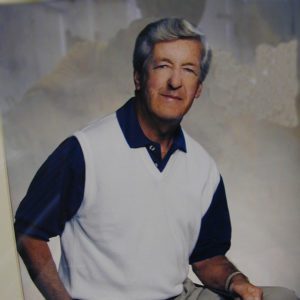
Leo Steinbrecher is recognized as one of the most important leaders in the MAPGA’s history. This is especially true for the 1960s when he served as President of the Virginia Association of Golf Professionals and Vice President of the Middle Atlantic PGA.
Growing up during the Great Depression in Richmond’s West End, Leo and his older brother Tony started out as caddies at the Country Club of Virginia’s Westhampton course. Coming from a family with five sons and three daughters, Leo and his siblings contributed to the family coffer as much as possible in those lean years.
As a young man, Leo shagged balls at .25 cents a bag for Bobby Cruickshank when the “Wee Scot” gave lessons. When Leo turned 12 years old in 1941, he won the Junior Caddie Tournament at the Country Club of Virginia. Cruickshank awarded him $5, a tidy sum in 194,1 and two old Willie Ogg clubs from the back of the pro shop. Leo swung for hours in his back yard. He later met Willie Ogg in 1957 at the first PGA School at Dunedin. Athletically he shined at Thomas Jefferson High School in all sports, so excelling at golf did not surprise anyone.
Following World War II he accepted the assistant’s position at Glenwood GC to Jim Reynolds who re-opened the course after the War. Then Jim Reynolds built Monacan Hills in 1949-1950. Service in the U.S. Army took Leo from Richmond to Europe during the Korean War. When he returned, Leo accepted an assistant position at the Country Club of Virginia to Darrell Napier in 1955. At the time, other assistants included George Bird and Freddie Christian. In 1956, Jim Reynolds offered Leo Steinbrecher the Monacan Hills head PGA Professional position. Four years later the name changed to Richmond CC.
During 1964–1966, Leo served as President of the Virginia Association of Golf Professionals (VAGP). For many years, some golf professionals in Virginia held VAGP membership, but not PGA membership. Leo Steinbrecher, Bill Clarke, Bill Strausbaugh and Carl Rasnic formulated the agreement which gained PGA membership for the non-PGA guys. They entered the MAPGA as full members and at the time created the Virginia Chapter of the MAPGA in 1966. Leo Steinbrecher held the Presidency of the Virginia Chapter for three years, 1967-1969.
In his playing career, Leo won the 1991 MAPGA Quarter Century Championship. Some twenty years earlier, in 1970, he made the final match in the Section Match Play Championship at Rolling Road. In 1979, Wade Briggs and Leo won the Virginia Chapter of the MAPGA Two-Man Championship. In 1993, he won the Middle Atlantic Senior Open at Chantilly National. Leo played in two Senior PGA Championships and in the 1984 U.S. Senior Open at Oak Hill. He also played in the PGA Tour stop at Greensboro twice and in an Eastern Open at Mt. Pleasant. One of his proud moments came in a U.S. Open qualifier at CCV, James River, where he shot 76-67. In the second round he hit all 18 greens in regulation.
In a long and distinguished career characterized by leadership and commitment, Leo Steinbrecher received the 1972 MAPGA Golf Professional of the Year Award and the 1984 Virginia Chapter of the MAPGA Golf Professional of the Year Award. Leo Steinbrecher was the 4th person inducted into the Dewar’s Hall of Fame for Virginia Golf Professionals. In 1987, the MAPGA awarded Leo Steinbrecher the prestigious Bill Strausbaugh Award. (rev. 2009)

PGA Tour
MAPGA Hall of Fame Class, 2017
Born in Norfolk, VA, Curtis Strange’s playing career began as a junior champion and reached its zenith by winning consecutive United States Opens. For these accomplishments the MAPGA has enshrined him into their Hall of Fame. As the second Virginian to win a US Open (Lew Worsham being the first in 1947), Curtis replicated a feat established by the greatest golfers teeing it up during the Twentieth Century. In taking the US Open trophy in 1988 and 1989, he matched Ben Hogan’s victories in 1950 and 1951 following World War II. Prior to the World War II, only Bobby Jones and Ralph Guldahl won back-to-back, and in the earliest days of the US Opens, Willie Anderson and John McDermott did so, Anderson three times.
Curtis emerged as the golfing prodigy of the already honored MAPGA Hall of Fame member, his father Thomas Wright Strange, Jr. Tom Strange, a prominent player in the 1950s and 1960s, won the Virginia Open five times, once as an amateur and four as a professional. Furthermore, he played in three US Amateur Championships, and six US Opens. The father introduced the son to golf about the time he turned seven years old. Unfortunately, he, his twin brother Allan, sister Anne and their mother lost Tom to cancer in 1969. Fortunately, the local golf professionals, notably MAPGA Hall of Fame member Chandler Harper, stepped in to provide the family support and well-being.
Following success in junior tournaments, having won the VSGA junior crown in 1970 and 1972, he embarked on an amateur career highlighted by winning VSGA Amateur Championships in 1974 and 1975; the Southeastern Amateur in 1973, Western Amateur, North-South and NCAA Championship in 1974; and the North-South and Eastern Amateurs in 1975. The Eastern Amateur title reproduced his father’s victory in the first one (1957). Additionally, he was a three-time All American at Wake Forest University as an Arnold Palmer Scholarship recipient. On perhaps the best college team ever, Strange’s power and pugnacity earned him the nickname “Brutus.” At the 1974 NCAA Championship, Strange eagled the 72nd hole to not only ensure the team championship but to win the individual championship by a stroke. “I’ve always looked at pressure as the time to show off,” he said.
In amateur team championships, he and his teammates captured the Eisenhower trophy, now the World Amateur Cup, in 1974; and the Walker Cup in 1975.
Turning professional in 1976, Curtis won the first of his seventeen PGA Tour titles, the Pensacola Open, in 1979. As a dominant tour player during the 1980s, he ranked at the top on the money list in 1985, 1987 and 1988, and was the first to accrue a million dollars in a single year in 1988. The PGA Tour named him Player of the Year in 1988 after having won four titles. Additionally, the Golf Writers of America named him their Player of the Year three times. Curtis won a PGA Tour event in seven consecutive years from 1983 to 1989. In the 1988 US Open, he defeated Nick Faldo in a playoff. In 1989, Curtis came back from a 3-stroke deficit to Tom Kite after 3 rounds to edge Chip Beck, Mark MacCumber and Ian Woosnam by a single stroke, thanks to a birdie on the 70th hole. The Official World Golf Rankings had him in the top 10 for some 200 weeks between 1986 and 1990.
Furthermore, he played on five Ryder Cup Teams, 1983 through 1991, again in 1995, and subsequently captained his US colleagues in 2002 at The Belfry in England. Strange’s finest hour was the final singles of the 1989 matches. By birdieing the final four holes, Strange took the lead from Ian Woosnam and took great delight in earning the final point for the American team, which secured a share of the trophy. Additionally, throughout the mid-1980s to mid-1990s, Curtis he played for the US in the biennial Dunhill Cup matches. In the 1987 edition, he shot a record 62 at the Old Course, St. Andrews.
As his illustrious playing career drew to a conclusion, Curtis became a well-known golf analyst, first for ESPN/ABC in 1997 continuing through 2004. Then he rejoined their broadcast team in 2008. Then in 2016 he joined the FOX Network telecast of the USGA Championships.
Not only a member of the Middle Atlantic PGA Hall of Fame, he is also a member of the World Golf Hall of Fame, the Virginia Sports Hall of Fame and the Virginia State Golf Association Hall of Fame.
Curtis is married to Sarah and have two grown children, Tom and David.
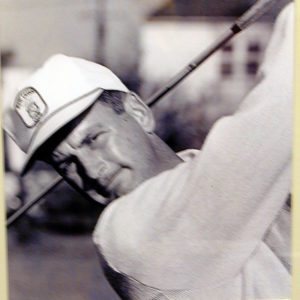
1931-1969. In an eleven year professional career that ended all too soon, Tom Strange compiled an impressive set of credentials in Middle Atlantic PGA and Virginia golf circles.
A Cincinnati native, Tom started as a caddie at Hyde Park Golf Club. He became a leading amateur when he won the city title at age 18. Even before that city championship, he won a match in the 1948 U.S. Amateur. In 1950 and 1951, Tom again played in the U.S. Amateur. Of greater magnitude, he qualified for three U.S. Opens, 1949-1951 at the end of his teenage years.
Military duty in the Coast Guard brought him to Norfolk. He won the City Amateur in 1955 and 1956, played in the U.S. Amateur in 1955, and won the Virginia State Open at Ocean View in 1957, shooting a playoff 64 against local professional Harold “Shorty” Oatman. As the 1957 golf season wound down, Tom also triumphed in the inaugural Eastern Amateur at Elizabeth Manor. Soon thereafter, he accepted the head professional position at Elizabeth Manor CC.
In 1960, he and Sam Snead played an exhibition against Chandler Harper and Jack Isaacs at Ocean View. Snead offered him a position as the “Host Professional” at the Greenbrier in White Sulphur Springs, which began in early 1961. After a nearly two-year hiatus, Tom Strange returned to Norfolk as the head PGA Professional at Bow Creek Golf and Country Club.
Nationally, once a professional, he played in three more U.S. Opens during the 1960s: 1964 at Congressional, 1967 at Baltusrol finishing in a tie for 48th, and 1968 at Oak Hill. He led the field in the 1964 U.S. Open Sectional qualifier at Woodmont with a 69 and 70. In the 1967 U.S. Open Qualifier at Crofton CC, he, Lee Elder, and Lanny Wadkins led the field.
As a MAPGA Section player, Tom Strange won state crowns four more times. In 1963 at Blue Hills he opened with 68 and 67 on his way to the VAGP title. The next year he captured the VAGP Championship at Cavalier Yacht and CC. A third VAGP Championship came to him in a playoff over Herb Hooper at Bide-A-Wee in 1966. The last title, this time at the VSGA Open, took place at Chatmoss in Martinsville in 1967. In the 1968 Virginia PGA Championship he lost by a stroke to Chandler Harper on the last day as the two battled over four days, never more than a stroke apart. And finally, he played on the 1968 MAPGA Schmidt Cup Team against the Philadelphia Section at Atlantic City CC and won both his matches.
Regionally, he won the Tom Ferguson Memorial Tournament at Bow Creek in 1963 with 67 and 65 on the first two days, pulled further ahead with 67 the third day and with a final round 71 only Avery Beck, a PGA Tour player, moved within three shots. Claude King and Jack Isaacs, also MAPGA Hall of Fame honorees, and Lou Graham, a U.S. Open winner, trailed by several more strokes. At the Fredericksburg CC pro-member in 1967, his 68 led Deane Beman and the rest of the field by three.
Not only one of the country’s finest players, Tom Strange became well-regarded as a teacher as well. There are many in golfing circles who have testified to his excellence, creativity, and far-sightedness in working with those who aspired to play the game. (rev. 2004)

1923-1999. Bill Strausbaugh, a native of Baltimore, earned the moniker of “Coach” for his work as a teacher and for contributions toward developing and improving educational opportunities for PGA professionals and apprentices. For this service to golf and to the MAPGA and The PGA, Bill entered the Hall of Fame.
He began his golf career while a teenager caddying at Bonnie View in 1937. Bill enrolled at Loyola College, but World War II beckoned as it did for many men born in the early 1920s. During the War, Bill served in the Marine Corps on the USS Wasp, an aircraft carrier assigned to the Pacific theater during most of the war.
“Coach” Strausbaugh turned professional in 1946 as an assistant to Andy Gibson at the County Club of Maryland. Before arriving at Columbia County Club as the head PGA Professional in 1968, he held the top position at Fountainhead CC from 1955 to 1961 and at Turf Valley until 1968. He retired from Columbia in 1994, ending a 26-year career as Columbia’s head PGA Professional. They named him their Professional Emeritus.
Bill contributed to the integration of the Virginia Association of Golf Professionals into the MAPGA. For many years, some golf professionals in Virginia held VAGP membership, but not PGA membership. Bill Strausbaugh, Leo Steinbrecher, Bill Clarke and Carl Rasnic formulated the agreement to assimilate those that had at least five years of professional experience. They entered the MAPGA as full members, and at the time created the Virginia Chapter of the MAPGA in 1966.
During his career as an officer in the MAPGA, he held the MAPGA Employment Chairman position in 1970 and the Presidency from 1974 through 1976. While President, he also represented District Ten (Carolinas, Kentucky and Middle Atlantic Sections) for three-years as a Director sitting on the National PGA Board. The MAPGA membership selected him as their Professional of the Year in 1966. He earned the Section’s Horton Smith Award for outstanding service and contributions towards developing and improving educational opportunities five times: 1966, 1968, 1971, 1978 and 1983. Along with Irv Schloss and Frank Cronin, he received the initial Horton Smith Trophy in 1966. He is the only five-time recipient. Twice the Section named him the Teacher of the Year: 1988 and 1992. He was the first two-time winner.
Bill instructed in Ferris State University’s Professional Golf Management program and lectured for golf associations throughout the United States, including 38 of the 41 PGA Sections, and in eight foreign countries as well. He was a speaker at the first PGA Teaching and Coaching Summit in 1988.
The World Golf Teachers’ Hall of Fame named him their tenth honoree in 2003. The tribute reads for “unfailing dedication to his students” and assisting thousands of golfers improve their games as well as teaching teachers how to teach. His colleagues in the Hall of Fame include Tommy Armour, Jim Flick, and Harvey Penick.
Within the ranks of the PGA leadership, Bill Strausbaugh served on the National Education Committee and chaired the National Club Relations Committee. Nationally, he won the PGA’s Professional of the Year honor (1966), the Horton Smith Trophy (1983), and the Teacher of the Year recognition (1992). Bill Strausbaugh is the only one to have been awarded all three. The National Golf Foundation granted him the Joe Graffis Award in 1977.
In 1979, The PGA and the MAPGA established the Bill Strausbaugh Award for work in the employment and club relations area. (rev. 2009)
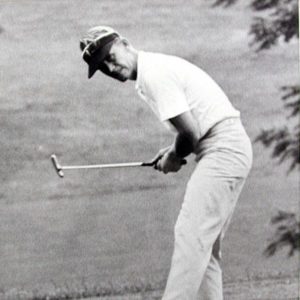
1932-1985. Dick Whetzle gained MAPGA Hall of Fame recognition for his stellar play and for his service as the section’s President and Tournament Chair. He spent fourteen years out of his 26 year professional career at Woodholme (1959 – 1968) and Prince George’s CC (1968 – 1973). Dick chaired the section’s Tournament Committee from 1966 through 1968. He served as the Section President from 1971 through 1973.
Dick Whetzle, originally from Buffalo, went to Dallas when his family relocated in 1938. As with many young men, Dick started out in golf as a caddie and carried Bobby Locke’s clubs in the Columbus Invitational Golf Tournament where he received a crisp $100 bill for his efforts from Locke, the then 29-year old South African star. After graduating from Holy Rosary High School in 1951 where he starred for three years in basketball, football and baseball, Dick accepted a baseball scholarship to the University of Texas. He stayed only one semester before enlisting in the Army. For two years at Camp Rucker, Alabama, his responsibility was running the golf course. While there Dick really took up the game and then began to seriously think about making golf his career.
He left the Army and enrolled at North Texas State College (NTSC) in 1954 where he made the golf team as a freshman. Dick’s amateur career included victories in the Dallas City Amateur in 1956 and the Texas State Public Links Championship that year as well. During the 1950s the professional and amateur golfers played against one another in the annual the Texas Cup. The amateurs, including Dick, Miller Barber and Jim Hiskey defeated Byron Nelson’s team made up of Nelson, Jack Burke, Tommy Bolt and Jimmy Demaret. At one time or another Dick defeated Byron Nelson and Ben Hogan in these matches. In 1957 he finished third in the Texas PGA tournament and made the cut in the Houston Open in 1958. Dick captained the NTSC golf team in 1958 and won 1st team All-America honors. In 1957 and 1958 he won the Southern Intercollegiate Championship. Dick posted a 61 at Sweetwater CC playing with Don Massengale and Charles Coody in a practice round for a local tournament which he subsequently won in 1958. In another local tournament he bested Miller Barber with a 62 leading to a 3 and 2 victory.
At 27 years old, Dick turned professional by accepting the assistant position to Carroll MacMaster at Woodholme upon the recommendation of Byron Nelson. When MacMaster unexpectedly died in October 1961, he became their Head Professional. Dick was a “PGA Approved Tour Player” and on the 1962 Winter Tour earned money in 8 of 11 tournaments. In November of 1968, Dick went to Prince Georges Country Club (now the Country Club at Woodmore) as an assistant and then in September of 1970 they appointed him their head PGA Professional where remained until 1973.
Dick Whetzle holds one of the MAPGA’s outstanding playing records. He won the 1965 Section Championship at Elizabeth Manor by four over Jack Isaacs, Maryland Opens in 1962 and 1969, Middle Atlantic Opens in 1968 and 1969, the Howard County Open in 1964, the MAPGA Match Play Championship in 1967, the Assistant’s Championship in 1961, and the Pro-Assistant Championship with Lloyd Kelley in 1966. He captured Player of the Year honors in 1965 and 1966. Dick played in four U.S. Opens, two PGA Championships, and three National Club Professional Championships.
Dick Whetzle was the first Hall of Fame member to qualify as both a Player and an Administrator since the MAPGA Hall of Fame selection criteria was modified in 1993. (rev. 2006)
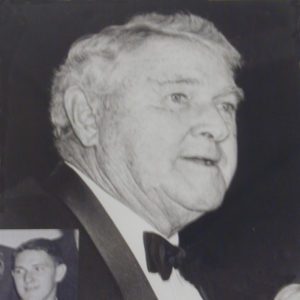
1917–1990. Lew Worsham grew up in Altavista, Virginia. He started the road towards a career in professional golf as a caddie at Bannockburn Golf Club, near Glen Echo, Maryland, in 1929. He became a shop boy at Kenwood Golf and Country Club in 1936. Lew turned professional in 1938 by accepting an assistant’s position to Robert Barnett at Chevy Chase Club. He moved on to Burning Tree Club in 1939 as Head Professional. While in the Navy during World War II, Lew was stationed at Bainbridge, Maryland, with Sam Snead and Jimmy Demaret. After the War, he returned to Burning Tree Club in 1946 and was elected to membership in The PGA in June of that year. Lew then accepted the Assistant PGA Professional position at Congressional CC working for Wiffy Cox with the intention of succeeding on the PGA Tour. He became Head PGA Professional at Oakmont CC (Pennsylvania) in late 1947 where he remained until his retirement in 1979.
Lew won nine times on the PGA Tour, including the 1953 World Championship at Tam O’Shanter in Chicago, where he eagled the final hole to beat fellow Virginian Chandler Harper. Two more victories in 1953 ensured first place finish on the PGA Tour money list. His first PGA Tour victory took place at the Atlanta Open in 1946, the same year he won the Delaware Open. Lew won twice in 1947, taking the US Open and the Denver Open, finishing 8th on the money list. He also won the Phoenix Open (1951) and the Miami Biltmore Fourball with Ted Kroll in 1952.
Nationally, Lew played in sixteen consecutive Masters between 1947 and 1962. In 1951, he tied Lloyd Mangrum for third behind Skee Riegel and the winner, Ben Hogan. That was his best finish at Augusta. Between 1938 and 1961, Lew played in seventeen US Opens, winning the 1947 edition at St. Louis CC by besting Sam Snead on the 18th hole of their now famous playoff. He played in fifteen PGA Championships making it to the quarterfinals twice (1947 and 1955). Twelve of those appearances occurred during the match play years where he failed to make the match play field only twice. In 1947, he defeated John Morris, Clarence Doser, and Reggie Myles to make the quarterfinals where he lost to Vic Ghezzi. Then in 1955, to get to the quarterfinals, he knocked out Dick Lundahl, Ray Hill, and Johnny Palmer before losing to Tommy Bolt. Lew’s best finish in his three PGA Championships at stroke play was in 1961 when he finished 37th. In the 1947 Ryder Cup Matches, he and Ed Oliver won a Foursomes match on the first day and then Lew beat Jimmy Adams in a second day Singles match helping the U.S. to a victory of 11-1. His nickname on tour was “The Chin.”
Lew’s first local triumph, in 1938, took place in the Lancaster pro-am sponsored by Arthur Thorn where Lew and Ed Dudley tied with 68s. He led the US Open Qualifying at Manor CC in 1940 with a 72-66, establishing a new course record that only lasted until Jack Isaacs came in behind him during the afternoon with a 65. Stellar play in the 1940 PGA Qualifier at Baltimore CC-Five Farms landed Lew in his first PGA Championship. The 1941 US Open Qualifier at Columbia CC put him back in the national spotlight. He garnered the Baltimore Open Tribute from Johnny Roche in 1941 with a 68-70 at Elkridge Club. Then immediately after World War II, Lew won the Maryland Open in 1945 by three at Kenwood G&CC and then earned a spot in the U.S. Open at the Burning Tree Club qualifier in 1946.
Triumphs in the MAPGA Section Championship came to Lew three times (1942, 1946, 1947). In 1942 at the old Indian Spring CC he beat the field by eight shots. He repeated the task, following his military service, in 1946 at Woodholme CC by three, and in 1947 at Hampton CC by three over Jack Isaacs and Chandler Harper, and by four over Sam Snead. Lew is also a member of the Tri-State PGA Hall of Fame and the Virginia Sports Hall of Fame. (rev. 2011)
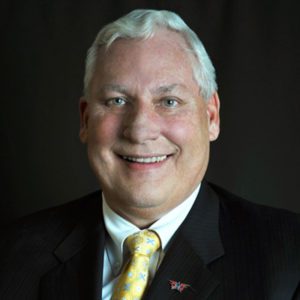
Folds of Honor Foundation, Baltimore, Maryland
Hall of Fame Class of 2015
Allen Wronowski’s incomparable impact and contributions to the Middle Atlantic PGA and the PGA of America span over thirty years. His dossier is filled with service to the golf industry and includes positions stretching from Head PGA Professional to President of The PGA of America. For that, he is honored with MAPGA Hall of Fame recognition.
He spent 34 years at Hillendale Country Club starting as an assistant professional, then PGA Head Professional, before being named PGA Director of Golf. Following election to membership in 1981, he earned numerous awards, most notable the Middle Atlantic Assistant Golf Professional of the Year in 1984; the MAPGA Merchandiser of the Year in the private facility category in 1998; the Section Golf Professional of the Year in 1999; and the Bill Strausbaugh Award in 2002 for his work in club relations and employment. In addition to the many awards he has earned over the years, Allen has a distinguished record of service to the MAPGA and to The PGA of America beginning with active involvement in Section governance. From 1983-1988, Allen served on the Assistant’s Committee as Treasurer, Vice President, President, and Tournament Chair. He has served on the MAPGA Board of Directors since 1996 holding the offices of Secretary, Vice President, President, Honorary President and currently Board of Control representative.
As Middle Atlantic PGA President from 2000-01, Allen implemented numerous plans and strategies that are still being used today by the Section. A few of those ideas include creating a business plan for the Board and Committees, starting a mentoring program for apprentices to use when joining the Section, and guiding an investment fund that increased Section reserves to over $2 million, some of which was used to build a permanent headquarters in Stafford, Virginia in 2006.
At the national level, Allen has been an active member including chair of numerous committees. He served a term as District 10 Director on the national PGA Board from 2000-04 when he demonstrated his passion to enhance player development. Allen was the chair for the 2009-10 PGA Professional National Championship, 2007-10 Junior PGA Championship and The PGA Board of Control. He has chaired the Junior PGA Championship five times and has served as co-chair of the PGA Youth Player Development Committee. In 2013, Allen captained the American PGA Cup team where they retained the Llandudno Trophy when the PGA Cup ended in a 13-13 draw. Allen has also served on eight Masters Rules Committees and four U.S. Open Rules Committees.
In November 2010, Allen Wronowski became the 37th President of The PGA of America, following two years each as PGA Vice President and PGA Secretary. As PGA President, Allen oversaw the launch of Golf 2.0, the industry’s groundbreaking growth-of-the-game initiative. After completing his term as President in 2012, Allen became PGA Honorary President and on November 22, 2014 was extended a second two-year term as Honorary President by the PGA Board of Directors.
A member of The PGA of America Hall of Fame class of 2013, Allen was named Director of Golf Development and Relations in 2014 for the Folds of Honor Foundation – a PGA, United States Golf Association (USGA), and National Golf Course Owners Association (NGCOA) supported foundation. In this position, he is responsible for pursuing new partnerships and other opportunities as he promotes the Foundation’s cause to provide scholarships in support of families of military veterans who have served and sacrificed for our country. He also serves on the National First Tee Board.
Allen and his wife, Gail, live in Bel Air, Maryland. Allen has two step-children, Rob and Lauren Chase. Rob is a PGA Professional at the Elkridge Club where he works for Joe Franz, one of Allen’s former assistant professionals. Lauren is a massage therapist and has two children, Grace and Hunter. When he is not working, Allen loves to play golf and fish.